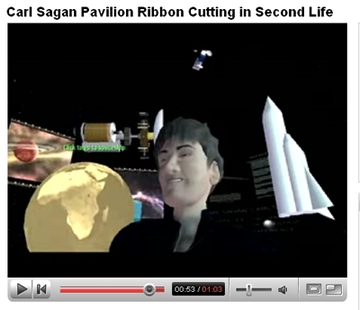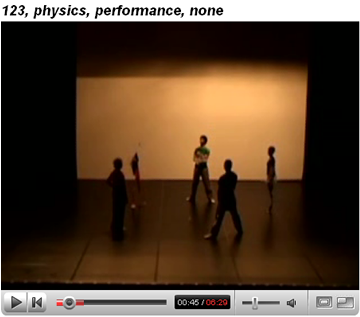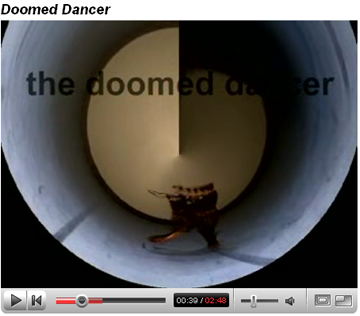« December 2006 | Main | February 2007 »
January 31, 2007
Grey Thumb Meeting Announcement
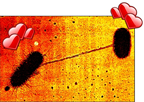
Chuck Lewin, "Sex And The Single Algorithm"
Grey Thumb features a talk by Chuck Lewin, "Sex And The Single Algorithm :: When: February 5, 2007, 7:00 pm :: Where: The Asgard Irish Pub & Restaurant (350 Mass. Ave, Central Square, Cambridge, Massachusetts) :: All are welcome.
Sex And The Single Algorithm: Similarities and Differences in the Reproductive Habits of Biological and Simulated agents: In honor of Valentines day, Chuck Lewin will use selected examples from the natural and artificial world to discuss differences and commonalities in how biological and simulated organisms reproduce, and how they map their genetic characteristics into a functional organism or artificial agent.
Chuck (aka Emanuel) Lewin is an entrepreneur who has founded a number of for-profit and non-profit organizations in the past twenty five years. In 1979 he started L&M Software, a developer of micro computer software. In 1991 he founded, and is presently CEO of, Performance Motion Devices, Inc., a Lincoln, MA-based developer of motion control electronics. In 2001 he founded, and is currently board president of, Art Interactive, a Cambridge-based gallery exhibiting interactive contemporary art. In 2006 he founded, and is presently director of, New Generation Energy, a non-profit focusing on renewable energy. Mr. Lewin was born in Holland and has resided in the US since 1966. He received a BA in Biology from Brandeis University.
Grey Thumb is a group of scientists, engineers, hackers, artists, and hobbyists in the Boston metro area with a strong interest in artificial life, artificial intelligence, biology, complex systems, and other related topics. We get together on the first (non-holiday) Monday of every month to do a blend of socializing, coding and listening to lectures by group members.
Posted by jo at 05:38 PM | Comments (0)
Hazardous:
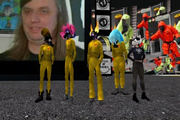
Second Front watches "Strange Culture"
This week we were invited to attend the premiere of "Strange Culture", an independent film by Lynn Hershman which discusses the infamous case of the arrest and pending trial of Steve Kurtz from the Critical Art Ensemble. The film will be shown at the Sundance Film Festival this week and has the distinction of being the first-ever feature film shown in Second Life.
It seemed altogether appropriate to have the first-ever performance art group in Second Life present at opening night (afternoon). We decided to don hazmat suits and gas masks to show our support for the defense in the ongoing Kurtz case. Second Front was unusually subdued in its urge to create a large-scale performance. We sat quietly and watched the film. The only sound besides the movie soundtrack was the constant clicking of the Second Life cameras as we documented this historic event.
Watching a movie in Second Life was totally weird. When you get to the movie theater, you hit the play movie control on your SL window. We're all watching the same film, but a different times! That seems like the most significant difference from a traditional cinema. Continue reading Hazardous: Second Front watches "Strange Culture" by Great Escape, Second Front.
Posted by jo at 01:00 PM | Comments (0)
TurntablistPC
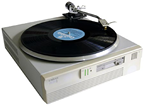
CALL FOR PARTICIPATION
TurntablistPC – CALL FOR PARTICIPATION :: The Art Museum of West Zealand invites you to participate in TurntablistPC, an internet-connected physical art installation by artist Mogens Jacobsen on show now at the museum through April 9th 2007. You can participate via your website from today on (please see below).
We are seeking the participation of websites from as many different countries as possible, so please forward this message to other interested parties.
WHAT IS TurntablistPC? TurntablistPC is a telematic hybrid of a turntable (a grammophone) and an old personal computer. Installed in the museum space, the TurntablistPC will play a vinyl record whenever someone visits one of the participating websites around the world, including your website. A video projection of a world map will show where the participating party is from, thus generating a map of global, remote participation for the local visitors in the museum space.
HOW CAN YOU PARTICIPATE? All we need is a “counter-hit” from your website, telling us that someone has visited your website (a hit). The counter-hit can be automatically generated by following a simple step – please place the following small snippet of HTML-code at the bottom of the most visited page of your website:
NOTE: Only use this code if your position is EAST of the city of Sorø, Denmark (11.5561 East / +11° 33’ 21.96”):
NOTE: I HAD TO MAKE IMAGES OF THE CODE FOR IT TO APPEAR. DO NOT USE THESE IMAGES; JUST TYPE THE CODE:
![]()
If your position is WEST of the city of Sorø, Denmark (11.5561 East / +11° 33’ 21.96”) please use this code:
![]()
This is the exact code to be included depending on your position. We will need your participation already for the set-up of the installation, so please act now.
We kindly ask you to notify us of your participation by sending an email to curator Andreas Brøgger at ab[at]vestkunst.dk with the subject line “turn”. Please also state in which country your website is registered/hosted.
The image and the code should remain on your site throughout the exhibition period (i.e. until April 9 2007).
TECHNICAL INFORMATION
The code places a tiny “invisible” image (a transparent GIF-image) on your website. Neither the image nor the HTML–snippet will interfere with the appearance of your website nor with the visitor’s experience. The code and the image are a mere 700 bytes (0.7Kb) in total. Participation does not pose any security risk whatsoever, nor is any personal or otherwise sensitive information stored.
MORE INFO
Mogens Jacobsen is a Danish artist who has exhibited widely in Sweden, Finland, Germany, Austria, France, Spain, Japan, Brazil.
More info on TurntablistPC at www.turntablistpc.info.
TurntablistPC is part of WEBSCAPE – ART IN THE VIRTUAL LANDSCAPE, a series of exhibitions of netbased, physical installations at the Art Museum of West Zealand 2006-2007.
Posted by jo at 11:25 AM | Comments (0)
ENTER_UNKNOWN TERRITORIES

CALL FOR PARTICIPATION
Enter_Unknown Territories is an international New Technology Arts Festival and Conference happening in Cambridge for the first time from 25-29 April 2007.
PUBLIC ART EVENTS: From 25 to 29 April, Enter_ invites you to explore new ways of experiencing and making new technology performance and sonic arts. LED art installations, CCTV footage films and an interactive maze are just some of the works set to invade Cambridge’s public spaces as Enter_ unfolds, claiming new territories.
WORKSHOPS: Visit our temporary dome site on Parker’s Piece to meet artists and find out more about new technology arts practice and process. Take part in a DIY workshop or hang out at the Mediashed or just drop in for a coffee to see what it’s all about.
LIVE PERFORMANCE: Performances, featuring cutting edge sonic arts, dance and theatre, make up an electric programme of live events, during the festival nights at the Junction.
CONFERENCE: As art and new technology practice challenge the borders between creative disciplines, contemporary culture and commerce, the relationships shift between producer and consumer. As these boundaries are contested, dissolved and reformed, new kinds of spaces are emerging for creativity, discussion and experience. The conference provides an opportunity to explore these new spaces and maps the potential for collaboration and exchange. The conference will explore three topics (Participation and Consumption, Control Technology and Technology & Sustainability) as catalysts for discussion and examine existing international exemplary practices to highlight potential new spaces for future collaboration.
The conference will take place at Downing College and The Junction from 25-27 April.
PRESALE & INFORMATION
Presale will start from 15 Feb 2007. Check the website for special advance discounts, programme updates and further information: www.enternet.org.uk
Enter_ is a collaboration between essexdance, The Junction, Wysing Arts Centre and is funded by Arts Council England, East and the East of England Development Agency.
Posted by jo at 08:09 AM | Comments (0)
January 30, 2007
SOCIAL ANIMAL
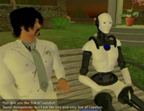
Son-of-Copybot
A conversation with Social Autopoiesis, one of the first fully-formed interactive NPC avatars in Second Life. Best viewed as a Windows Media video here; low-res YouTube version here.
I got a clue from Dedric Mauriac, and found Social Autopoiesis sitting there on a park bench on the isle of Discordia. So I joined him, and got to talking, and after a time, he told me he was the son of Copybot. (Then again, he also claimed to be logging in from a leather bar in the Castro district.) Whatever the case, he's perhaps the first avatar-based, conversation-enabled, non-player character to enter Second Life-- a project stemming from libsecondlife, the admired (and occasionally vilified) initiative to create a reverse engineer version of the SL viewer. Making such 'bots as Autopoiesis possible.
Like any conversation with a chatbot powered by a limited database, dialog with Social Autopoiesis is apt to run off the rails, on occasion; watch this video, to see. (View with Windows Media player; intermittently ribald chat possibly not safe for work, unless you work in a steel mill.) Or have a chat with him yourself-- direct teleport here. Continue reading SOCIAL ANIMAL by W. James Au.
Posted by jo at 05:33 PM | Comments (0)
First International Art Tech Media Congress

Call for Entries
International Artist Call Art Tech Media 07:: Calling on all creatives of the world to participate. Submissions will be accepted from the following categories: A: - Video art - Net-art - 2D & 3D Computer Animation - Blog, videoblog - Creation for mobile platforms - Digital Music. B: - Digital Communities - Geospatial storytelling - Artificial Life, Software art, Transgenic art, Generative art.
In a globalised world, dominated by communication technologies, with countless questions concerning a future that affects our everyday life, it is essential to make this analysis and to consider, from different perspectives, how our polyhedral, altered reality is being effected by the widespread use of new technology as a support for new ideas and possibilities that are almost infinite. We need to investigate how this occurs in different societies and cultures and to propose models that may go beyond what has been known until now.
The First International Art Tech Media Congress has been set up in order to reflect upon and analyse questions currently being raised about art and new technological media within an international context.
Within this context, an intensive debate needs to take place on the influence and transformations that new media is producing in art, there needs to be a greater understanding of the foundations for more effective cooperation between the different sectors linked to digital art, and proposals need to be devised for the development of national and international collaborative networks in order to improve production, research, exhibition and promotion.
Last year, Art Tech Media 06 encounters had been held at nine Spanish museums, and given the great participation and the opinions collected, its seems clear that this is an ideal time to celebrate the First International Art Tech Media Conference. It represents a great opportunity to hold a transversal debate in order to devise proposals that will lead to greater and better coordination among the different sectors of art, aimed at strengthening its development.
www.artechmedia.net/artechmedia06.htm
Art Tech Media 06 headquaters: Museo Nacional Centro de Arte Reina Sofía, Museo de Arte Contemporáneo Unión Fenosa, Presidencia Gobierno de Canarias, Museo Domus Artium 2002, Centro-Museo Vasco de Arte Contemporáneo Artium, Fundación BilbaoArte, Centro Párraga, Museo de Arte Moderno y Contemporáneo EsBaluard, Centro de Cultura Contemporánea de Barcelona.
<<< GENERAL REGULATIONS Art Tech Media 07 art call - Works must have been produced after January 1st, 2006. Projects: - Those interested in submitting work in these categories must send a completed entry form. DEADLINE: 30th march 2007 SELECTION AND JURY - Works presented will be selected by a committee of the organization. SELECTED WORKS must include: - Technical credits. >registration form> enter
Posted by jo at 05:05 PM
| Comments (0)
"Art and Society: The Work of Fred Forest" featuring Fred Forest :: Slought Foundation Exhibition :: Curated by Osvaldo Romberg :: February 03 - March 23, 2007 :: Reception: Saturday, February 03, 2007 ; 6:30-8:30pm :: Free admission (Reservation not required) :: A special seminar by Forest concerning his practice will take place immediately before the opening from 5:30-6:30pm, and will be moderated by Jean-Michel Rabate. Fred Forest, "For an aesthetics of communication" (Plus Minus Zero, 1985): "I have always considered that the natural field of artistic production is the terrain of social activity. A field which may be enlarged and explored thanks to the new Communication technologies. This option upsets the holders of a fixed concept of aesthetics, who are incapable of grasping the obvious articulation between this type of practice, the concept of art, and a society in transformation. We are called upon to ask the question "Where are the frontiers of art situated?" It's a brave man who will stick his neck out! There is no frontier. Art is an attitude-- a way of relating to something, rather than a thing in itself. There is an aesthetics of behavior, an aesthetics of gesture, just as there is an aesthetics of object. We have now to take a new category into account: the aesthetics of Communication. The media of this aesthetics are often immaterial: its substance comes from the impalpable stuff of information technology. In the sky above our heads, the electrical signals of this information trace invisible, blazing and magical configurations." Visit: http://www.webnetmuseum.org Fred Forest is a communication artist and theorist (born in Algeria in 1933) who has worked at the forefront of interactive art and new media, sociology, and institutional critique for over forty years. His work, frequently immaterial and relational, raises questions about the nature and function of art in a market-driven age of information. Forest has exhibited and presented at institutions including the Museum of Modern Art, New York; the Centre Georges Pompidou, Espace Pierre Cardin, and the Museum of Modern Art of the City of Paris; the Venice Biennial; Documenta 6 and 8 in Kassel, Germany; the Foundation Miro, Barcelona; and the C.A.Y.C./Center for Art and Communication, Argentina. Fred Forest recently created the "Digital Street Corner" at the invitation of Art Basel Miami Beach 2005, in conjunction with the Cartier Foundation for Contemporary Art, Paris, and the Bass Museum of Art, Miami. This interactive network, artistic environment and "virtual happening" was co-created in real time by people on the internet, which Forest in turn choreographed and projected on an outdoor screen on the exterior wall of the Bass Museum (http://www.fredforest.com/). Also in 2005, Forest was commissioned by the National Audiovisual Institute (INA) of France to create "Memory Pictures," a website and installation, for the Great Hall in the French Ministry of Culture. In this work, the artist, digital avatars, and anonymous participants create collaborate collage works of art. In 2006, Forest launched "The Biennale of the Year 3000," a participatory new media intervention staged against the "official" Sao Paulo Biennale that took the form of an exhibition without curatorial selection. As early as 1967, Forest organized a series of participatory and community-based art activities which laid the foundations for the "Sociological Art" movement to follow. By 1969, Forest was known as the first French "plastic" artist to make extensive use of video art and carry out one of the first installations of this type at the Sainte-Croix Gallery in Tours, France. In 1972, continuing his research into this medium, he purchased media space in the French national newspaper "Le Monde," and launched a series of "press experiments" which extended from journalism to television and radio both in France and abroad. In 1973 his work in mass-communications won him the Communications prize at the XIIth Biennale in Sao-Paulo, Brazil, and in 1974 he co-founded the "Sociological Art Collective" whose activities were eventually featured in the 1976 Venice Biennale. Forest also participated in Documenta 6 in 1977, and exhibited a field frequency of 14,000 hertz in the Fredericanum in Kassel, Germany in Documenta 8 in 1987. Following the dissolution of his sociological collective, Forest staged various art actions and exhibitions, frequently involving the late Pierre Restany, such as The Artistic Square Metre, The Stock-Exchange of the Imaginary, at the George Pompidou Centre, and The Communicative Space at the Museum of Modern Art of the City of Paris. In 1982 Forest formulated the term "Communication Aesthetics," and in 1983 Fred Forest co-founded the International Group for Research into Communication Aesthetics, to explore new directions for art centered on problems of communication, new models of anthropological behavior, and our evolving relationship with a world conditioned by technological developments. This exhibition has been curated by Osvaldo Romberg with the generous support of l'Institut National de l'Audiovisuel, the Cultural Services of the French Embassy in the United States, and the School of Arts and Sciences and the Department of English at the University of Pennsylvania. Please note that an interview with the artist is available online on the Slought Foundation website.
Posted by jo at 04:50 PM
| Comments (0)
Collision 11 is looking for experimental technology based artwork. Collision 11 will be held in conjunction with the Cambridge Science Festival and the Boston Cyberarts Festival. In order to submit, first add yourself as a user (if you haven't already in a prior submission), login, and then use the submissions navigation link to submit your proposal. After initially submitting, reedit to add collaborators. If you have any trouble send me mail. Collision 11 will take place at the mit stata center balcony apr 20 - may 3 on the two weekends from 12p-6pm and during the week 9a - 5p. The opening will take place on sat apr 21st at 6-9pm. Artists will be responsible for artsitting during the two weekends. Submissions are now open and must be received by midnight Sun Mar 04, 2007. Acceptances will be sent out by midnight Sun Mar 11, 2007. We will also do an early acceptance for standout pieces that are received before midnight Sun Feb 18 2007 and those pieces will have an opportunity to be part of our cyberarts press photo kit. So please submit early if your piece is complete so that we can get good press photos to cyberarts. This c11 show is meant to be rough and experimental and more inclusive than our other shows. Strong works will be selected from the Collision 11 show and will be considered for more polished future shows. Works will be judged according to the following criteria in decreasing order of importance: art / technology -- be techno in production or product
Posted by jo at 04:12 PM
| Comments (0)
Night Haunts is a collaboration between writer Sukhdev Sandhu, website designer Ian Budden and sound artist and musician Scanner. Night Haunts unfolds in monthly episodes through 2006 on this specially designed site. In this contemporary nocturnal journal, Sandhu prospects in the London night with the people who drive its pulse from night cleaners to praying nuns, security guards to the Samaritans. In each episode, Sandhu reflects on the nature of the urban night. Has night life been corroded by light and entertainment? What are the invisible forces that pulse through the sleeping city? Is real darkness possible any more? Sandhu's first piece, Whatever Happened to the London Night? introduces his endeavours against the backdrop of past investigations of the nocturnal metropolis, particularly HV Morton's The Nights of London, published in 1926. In his February episode, Avian Police, Sandhu recounts the experience of flying above the city in a police helicopter 'equipped with night-vision cameras that can pick out shirt labels from over 2000 feet'. In March, he tracks the solitary working lives of night cleaners traversing the city's empty streets and offices. In future episodes he will be wading through the eternal darkness of London's Victorian sewers, dodging officialdom with pirate radio DJs, and praying for the soul of London with the Nuns of Tyburn. The Night Haunts website is described by designer Ian Budden as "a virtual landscape that reflects the physicality of Sandhu's experiences. The site involves a method of programming which we call 'techtonic animation', using a greatly enlarged version of the pixel, the fundamental building block of internet technology." The visual and sonic textures are in constant flux, randomly triggered so that each experience of the site is unique. You will never see or hear it the same way twice.
Posted by jo at 03:09 PM
| Comments (0)
"Stay in Place reveals the resurgence of small complicities between two friends in a chat session while the screen acts as a mirror of oneself and the other, and makes us reflect about personal relationships in the presence of new technologies." -- Arlan Londoño, curator STAY IN PLACE is a reflection of connection moment between two friends through a Chat by Internet. In this way, a teleshared space arises among them when both maintain a telematic talk by this channel. This scene is captured by the creator of this video, Sara Malinarich, with the intention to trap this spontaneous action in which both achieve to articulate a narration in the context of an unique and unrepeatable situation. According to this video, the woman that is in the upper window is Maren Pimstein, who was located in Santiago of Chile at 14:32 hrs. of June 12 of the 2006; the another is Sara Malinarich, was in Cuenca, Spain at 19:32hrs of that same day. Few years ago, both women were girlfriends on the University of Chile. Normally Maren and Sara used make up every time before going out. The day in which this action occurs, Sara had to leave again. For this reason she took her makeups again and she begins to be makeup herself, using the screen of the computer as a mirror and, as well as, an intangible backup for her friend that, from the another side, feel that this results very similar for her, finally, both knows that this is a renewal among them of their old complicities. This work speaks us, not only of a concrete theme of human relationships, also of the simultaneous and multicultural settings produced by the connection by webcam across the distance. In the same way, meeting places and people on a digital backup. This technological backup admits new elements of composition, implying new narrative possibilities, but also present us anxieties such as where the action occurs? How many artworks have been produced on a simultaneous way during this action? Why these friends have been themselves motivated by their digital clones? STAY IN PLACE is a proposal directed to the experimentation into the cyberculture land, oriented to the collaborative creation to distance through Internet. This artwork arises after the development of other projects proposed and directed by the author of this piece, related to the scenic arts and the new technologies, such as, "ORBITA. Festival for the teleshared actions by webcam" (2004-2005) and "INTACT. Interface for the teleshared action" (2005-2006). The reflections considered in the implementation of ITCT at the service of the scenic arts, are basically the digitalization of the body and the transmission of data in real time, as well as the fusion of the scenes into one space of digital nature. STAY IN PLACE connects elements that are inherent to the action and the new technologies, such as: Light, speed, body, sound, communication, virtuality and digital code, de-materialization and data transformation. [via Rhizome]
Posted by jo at 02:51 PM
| Comments (0)
The Burning Question, by Abinadi Meza, is a participatory installation and internet radio broadcast. This project consists of customized computers, large color posters, and pamphlets examining Intellectual Property and copyright. Multiple computers are loaded with hundreds of works contributed by composers, musicians, and sound artists from around the world. Visitors are offered blank CD's and invited to freely burn copyleft music; as they make playlists, they collectively generate an Internet radio broadcast that streams 24 hours a day from the gallery for the duration of the exhibit. The gallery becomes an impromptu radio station and visitors become DJ's. [via Rhizome]
Posted by jo at 02:39 PM
| Comments (0)
Open Video Projects (OVP) is a video archive currently based in Rome, Italy which facilitates screenings throughout the city in conjunction with a weekly appointment at the Blueroom evening at Rialto Santambrogio, a contemporary cultural center in Rome's historic district; Blueroom features a dynamic mix of live experimental electronic music, a rotating DJ line-up, live video-mixing, site-specific video installations and 3500 cm² (a weekly exhibition of poster art specially designed by a contemporary artist for free distribution at the event). There has been overwhelming public response with over 1000 guests in attendance each week. OVP’s participation in large scale cultural events exposes the public to work it would normally not see, as well as provides a unique form of visibility for the participating artists and filmmakers. For its second season of screenings Open Video Projects is looking to expand its international network of artists working with film and video. All artists working in these media are invited to submit work to be part of OVP. All submitted materials will be evaluated for inclusion, however, only selected pieces will be screened. Lorenzo Benedetti and Sarra Brill are responsible for the selection of all video entries and will curate the weekly selections. All submitted materials will be collected in a searchable database, accessible on the program's website. In addition to the database, the site will feature a program guide, screening times, and links to websites of participating artists and filmmakers (if provided). GUIDELINES FOR SUBMITTING VIDEO-WORKS - Subject matter is unlimited; There is no deadline for submissions, however it is advised that work be sent promptly as screening slots are limited. Please confirm your submission with an e-mail to submissions[at]openvideoprojects.org Inquiries may be directed to info[at]openvideoprojects.org Submissions can be sent to: Open Video Projects Open Video Projects We look forward to hearing from you! Lorenzo Benedetti is an independent curator, Project Curator of Volume! non-profit gallery, and curator of the Sound Art Museum, RAM, in Rome. Sarra Brill is an AV artist as well as co-director of the New York-based art collective, Aviate, organizing audio/visual events in New York and Rome.
Posted by jo at 01:59 PM
| Comments (0)
[Tiffany Holmes asked] "Would anyone wish to volunteer a story about an influential teacher or mentor who impacted their development as an artist or scholar? There are two contrasts which taught me more about education than listing syllabi -- that between the negotiatior and the knife. First, the knife. In the third year of my undergraduate education in English Honours (an underground mafia of critical theorists, marxists, feminists, and continental philosophers) I ended up in a two term seminar simply titled "Theory." A somewhat notorious seminar for its drop-out rate: this seminar went from a healthy bunch of 25 to about 8 within 30 days. Many students received failing grades on their first paper. They were not encouraged to return. Those of us who were doing well were pushed even harder: the comments on our papers were brief and penetrated beyond the paper itself, a kind of samurai incision to the work that reduced it to nothingness. The professor was like a zen master: the comments were koans, the lectures parables of emptiness. The professor in question was highly trained in deconstruction and psychoanalysis, a feminist and lesbian, expert in law, computer technology, James Joyce and senior faculty. She was a product of the critical '60s left. It was a taste of what university might have meant: if we were to assume a certain mantle, we had to work for it by questioning the desire and all desire itself, beginning with our desire to be there. Thus the course dismantled the fragile structure of our fledgling intellectual egos. This was not a course in deconstruction, but a course deconstruction of our psyches to the point of trauma. That such discipline manifested by excluding 80% of the class wasn't something I reflected upon until much later: one simply had to struggle to breath. Nonetheless, it was a kind of trauma that inspired a dedicated work ethic and fostered an intensive critical approach. She openly posed the question, like Brian and Luis, if university was at all a worthwhile path for us, as students, and if in general the system held anything for us. She wasted no time in attempting to hold everyone's hand in a grand gesture of all-inclusive pedagogy. Second, the negotiator. Much later, as a graduate student, and perhaps more common to many of us: the professor who enlivens the seminar by negotiating each perspective, summarizing and catalyzing the movement of thought. An easygoing flow, an inspiration, a wit and ready-access knowledge that flows from all corners. Yet the program is somewhat deceptive: the generosity came first, now the marking will be rigorous and the comments detailed to the point of editorial overview. Excellent preparation work for the "real world:" here, the knife is hidden behind the overcoat of the smile. Encouraging nonetheless, but the knife remains. One learns how to perform and negotiate in the seminar, the academic environment, and the work. There are other models too -- but these two, the negotiator and the knife, are archetypes, certainly not opposites, but rather movements in what education requires if critical pedagogy is to persist: how to sharpen the blade, which arteries to cut, and the time to slice. tV iDC -- mailing list of the Institute for Distributed Creativity iDC[at]bbs.thing.net http://mailman.thing.net/cgi-bin/mailman/listinfo/idc List Archive:
Posted by jo at 09:06 AM
| Comments (0)
InterAccess is pleased to present ZOO, an exhibition of three works by three artists that artfully integrate natural and artificial life, colliding the realm of living things with the genre of creative electronics. Artists Ingrid Bachmann, Garnet Hertz and Amy Youngs explore the complex relationship between technology, culture and nature. Opening Reception Friday February 2, 8:00 pm :: Artist talks Friday February 2, 7:00 pm :: Exhibition runs February 2 - March 17, 2007 :: InterAccess Electronic Media Arts Centre, 9 Ossington Avenue, Toronto. Digital Crustaceans v.0.3: Homesteading on the World Wide Web involves live hermit crabs and their avatars that explore the World Wide Web. The hermit crabs have two homes - a large glass terrarium and a ‘home’ page on the Web. The movements of the real crabs within the terrarium are tracked by a motion capture system and animate a mechanical plotter that traces its movements onto a surface. These mappings serve as formal drawings as well as a record to track the movements of the avatars, as they map their itinerary and journey across the structures and sites of the World Wide Web. Cockroach Controlled Mobile Robot #3 is an experimental mechanism that uses a living Madagascan hissing cockroach atop a modified trackball to control a three-wheeled robot. If the cockroach moves left, the robot moves left. Infrared sensors also provide navigation feedback to the cockroach, striving to create a pseudo-intelligent system with the cockroach as the CPU. Holodeck for House Crickets is a suspended artificial landscape that is designed to house Acheta domesticus (house crickets), who are raised in climate-controlled tanks as food for reptiles. As actual nature would be a bit harsh for these domesticated crickets, artist Amy Youngs provided them with an artificial landscape where they can interact with a video “holograph” of the pastoral grasslands and woodlands experienced by their wild relatives. Through the use of a computer interface, the crickets are able to “interact” with their projected environment by chirping. Each chirp advances the panoramic, cricket-eye-view video footage of outdoor scenery.
Posted by jo at 01:28 PM
| Comments (0)
REVIEW: 5+5=5 by Tindara Sidoti: 5 short movies by 5 film makers about 5 networked art projects exploring critical approaches to social engagement. Some of my earliest memories involve flashes of evocative cinematic imagery, Gene Kelly dancing athletically across a small screen or Alec Guinness and Peter Sellers squabbling. While studying art, this fascination with film coexisted, but the two arts were never really connected for me until I became more familiar with video and media art, later doing research on the influence of cinema on artists’ film. 5+5=5 is an experiment on the boundary of media, art and film; a cross-pollination that uses a variety of cultural influences from cinema and the Internet, to provide an access point to networked art and the artists groups’ selected projects. Furtherfield have commissioned these five short movies that feature conversations between artists, audiences and film-makers. 5+5=5 manages to tap into the current fluidity of the boundaries that exist, between genre and media; a space between art, film and technology that has resulted in artists like Douglas Gordon and Philippe Parreno releasing Zidane: A 21st Century Portrait (2006) in cinemas. Though interpretive, these films are more contextually assertive than Turner Prize nominee style documentaries and betray a more inter-disciplinary function. The movies are an example of how the relationship between art and film can work effectively; not only do they hook you, making you curious about the projects themselves but each one is an engaging film. Continue reading at New Media Fix.
Posted by jo at 12:35 PM
| Comments (0)
Seeing that in this discussion (Kanarinka, etc.) many are just entering the academic tunnel, I would like to contribute a little from the vantage point of the exit. I retired 7 years ago after slowly dying during 32 years in an institution that started well. We were to take off were we thought Antioch had stopped, "break the lockstep of traditional education" as our mission stated in 1968. The three decades plus spent on observing changes of mission, corruption, brown nosing and decay, only served to teach me that there is no way to build a truly progressive institution in the U.S. The rhetoric may be progressive, but the core won't ever get there, and it is not only due to corporations, government, bad administration and self-serving colleagues. Education in this country is only a relatively true right for the people until high-school level. After that it is a commodity in a profit making business. University profit comes of course from the tuition students have to pay for the honor of getting a job to help corporations make more profit. It comes from corporations themselves, that sponsor projects that benefit them (government and army being part of that), and it comes from non educational things like sports events. It is into this picture we enter trying to educate people, without realizing that we can't really balance a greed-based structure with our idealism. In terms of art education I figured that if I had 5000 students over the years, maybe 20 of them managed to support a family with their art. The 5000 ensured that I could survive as a professor. The other 4980 that didn't make it in the gallery circuit, hoped to survive teaching the same way I did. If they managed to get a teaching job, each one of them would need another 5000 students to survive. We have a perfect pyramid scam here. I suggest a different utopia than the attempt to find the precarious balance you are seeking or an impossible institutional reform within the university. It is too late for all that. It might be much more realistic to accept that the U.S. universities are corporate tools that in fact are competing with corporate training at a disadvantage. In art, the Whitney museum is training its own artists and being better at it than many schools (partly due to better filtering). Let us stop the hypocrisy and have corporations openly take over education for "real life," making sure that students survive in the market. It will provide a much better and up to date education. With this we would have a true education for serving. Let us also have the government start from scratch and create a free humanist education system that ensures that people learn about cultures and ideas, how to speculate and how to make connections. This would be the education for thinking. The student could be in both systems at the same time and end up well rounded. Some of us are better at teaching skills than thinking, and therefore would contribute in the first system. Some of us are better at idealistic speculation and would be in the second. We all would lead much less frustrating lives, be incredibly more productive, and present ourselves with a constructive attitude to our students. Presently, those of us who are idealistic can only teach (justified) resentment." Luis Camnitzer iDC -- mailing list of the Institute for Distributed Creativity iDC[at]bbs.thing.net http://mailman.thing.net/cgi-bin/mailman/listinfo/idc List Archive:
Posted by jo at 11:41 AM
| Comments (0)
Presentation of the book: Networking | The Net as an Artwork @ Transmediale :: Sunday 4/2, 16:00 :: Salon, Akademie der Kuenste, Berlin, D :: With Tatiana Bazzichelli [it/de], Jaromil [it/nl], Gaia Novati [it/de]; moderated by Diana McCarty [de]. Networking | The Net as an Artwork :: Written by Tatiana Bazzichelli, with the preface of Derrick De Kerckhove and the epilogue of the Italian videoartist Simonetta Fadda. The book represents a first tentative to write a comprehensive history of both analog and digital subcultural networked art in Italy, through an analysis of the realities which during the past twenty years have given way to a creative, shared and aware use of technologies - such as Mail Art, Neoism, the Luther Blissett project, BBS culture, Telestreets, and many other subcultural movements and networks. The Italian network proposes a form of critical information, diffused through independent and collective projects. Active in underground environments, they use diverse media (computers, video, television, radio and magazines) and deal with technological experimentation, or hacktivism, depending on the terminology used in Italy, where the political component is a central theme. The book describes how in Italian subculture there was never a divide between artistic and political activism, covering the evolution of the Italian net culture from the Eighties till today. The book shelds light onto the affinity of 1980s Mail Art manifesto to post-1990s Internet culture, up to its terminology of artists as "network operators" and art as a "network-web", the political redefinition of the term "Cyberpunk" in early 1990s in Italy, the mutation of Cyberfeminism into Netporn activism, and presents the works of many artists and activists, such as 0100101110101101.ORG, [epidemiC], Jaromil, Giacomo Verde, Giovanotti Mondani Meccanici, Correnti Magnetiche, Candida TV, Tommaso Tozzi, Federico Bucalossi, Massimo Contrasto, Mariano Equizzi, Pigreca, Molleindustria, Guerriglia Marketing, Sexyshock, Phag Off and many others. Networking | The Net as an Artwork, is printed on paper (Costa & Nolan publisher, Milan, Novembrer 2006, pag. 336), but it is also available online under: http://www.networkingart.eu (Creative Commons License) ENG: http://www.networkingart.eu/download_eng.html Diana McCarty [de] lives and works in Berlin. She is a co-founder of bootlab and co-initiated the open source radio project, reboot.fm. She is an active member of the Free Cultural Radio Network, Radia.FM. Together with Valie Djordjevic, Kathy Rae Huffman and Ushi Reiter, she runs the Faces mailing list for women in media. As part of the International Women's University server development team, she worked with Seda Gürses, Barbara Schelkle, Prof. Heidi Schelhowe, and Heiki Pisch - and also worked to develop feminist pedagogical approaches to computing. In the mid-nineties, McCarty co-founded the Nettime Mailing list and as part of the Media Research Foundation, she co-organized the MetaForum Conference Series in Budapest. Her main interests are exploiting social and technological systems for cultural use; i.e. piracy and open source software development for real life. www.bootlab.org www.mrf.hu Tatiana Bazzichelli a.k.a. T_Bazz [it/de] (Rome, 1974), is a Communication Sociologist and an expert in Media Art, Hacktivism and Net Culture. She gave a dissertation on Italian interactive digital art at the University la Sapienza in Rome (1999). Towards the end of the 1990's she organized events and conventions, such as Cum2Cut (Berlin, 2006), Hack.it.art (Berlin 2005), Art on the Net in Italy (Berlin 2005), MediaDemocracy and Telestreet (Munich, 2004), AHA (Rome, 2002), Hacker Art Lab (Perugia, 2000). She is the founder of Activism-Hacking-Artivism, a networking project started in 2001 in Rome and based in Berlin since 2003. She manages the aha@ecn.org mailing list regarding artistic activism and writes of art, media and new creative trends for many Italian magazines. Jaromil [it/nl] is a hacker and author of various free software applications (GNU/Linux/BSD), known as an artist for his performances and creations, as well as activist for his social concerns and radical way of life. Online since 1994, he co-founded the italian non-profit association Metro Olografix for the diffusion of telematic cultures. Later he gave birth to the dyne.org foundation: creating software for the freedom of expression, to let people communicate free from capitalist speculations and expensive hardware. www.rastasoft.org www.dyne.org Gaia Novati [it/de] is involved since many years in the Italian queer countercultural movement. She has worked with radio and visual media projects. Co-founder of Sexyshock, communication laboratory on gender theme and first sex-shop managed by women in Italy, she is interested since long in independent pornography. She is one of the organizers of Cum2Cut, Indie-Porn-Short-Movies Festival in Berlin, where she lives since 2006.
Posted by jo at 11:30 AM
| Comments (0)
[...] Has the shiftspace project evolved since I first heard the presentation you made at Ars Electronica in September 2006? Definitely! First of all, we had four more releases since then (with v0.08 is coming soon too) and have just launched the new ShiftSpace.org which is wider and more comprehensive than the previous site. The new site also allows users to watch and subscribe to RSS feeds of shifts created by the vast user community. We have been giving more presentations to spread the word and have been throwing 'installation parties' where participants were invited to install a public spaces on their laptops. We are currently working with Turbulence to start a unique commission program to support artists creating new parasitic net art and using ShiftSpace as a platform. This can become the moment we've been working towards, where ShiftSpace becomes an open-ended creative platform, shared and developed by a wide community.We are looking for more people to join us in working on it. It can be as simple as using the system, being creative with it, and also reporting bugs from time to time when they appear (and bare with us while they will most certainly appear...). You can also join by developing new spaces for ShiftSpace, or best - for the web gurus out there, we are looking for developers to help us work on the core system itself. We are pretty serious about the open source model and are inspired by the Wikipedia foundation. We hope to achieve a stage when we could hold elections for the lead of the project. We will then hopefully compete with peers who are as enthusiastic and committed as we are to the future of the (meta)web..." From Interview with Mushon Zer-Aviv by Regine Debatty, we-make-money-not-art.
Posted by jo at 10:46 AM
| Comments (0)
XIV RADIO CREATION WORKS CONTEST | CDMC-RADIO CLÁSICA 2007 :: The CDMC and Radio Clásica (RNE) are undertaking a collaboration to encourage the production of radio creations in order to promote this type of works. Within this line, a contest of ideas is called subject to the following RULES: 1 The works will necessarily be pieces of radiophonic creation, that is to say, whose most suitable means of production and diffusion is the radio. The works will not have been previously awarded nor emitted. 2 Words, noises, music, electronic or radiophonic editings and other similar elements may be the base of the work. 3 The project may be in Spanish only or in several languages but in this case Spanish should be the main language. The use of language or voice may also be omitted. 4 To enter the contest it will not be possible to send accomplished works, but mere projects: a written description of the work and of the elements that it will require, some excerpts as a model in cassette, CD or DAT, scores or fragments of these, acoustical materials, etc. Any form or presentation will be admitted, provided that it makes possible to the Jury to appreciate the interest of the projected idea. 5 There is no age nor citizenship limit. 6 The deliveries should be made on before April 15th, 2007 by any of the procedures allowed by the Administrative Procedure Act; such as registered mail, (postmark date will probe meeting the deadline), personal delivery, etc; and they should be addressed to: "XIV Concurso de Obras de Creación Radiofónica" 7 There is no limit to the number of projects to be sent by each author. 8 The projects should arrive anonymously with an assumed name that will be reproduced on an enclosed closed envelope containing a photocopy of the DNI or passport and personal details of the author or authors. In the case of using texts by another author, his opportune permit must be accredited. 9 A Jury appointed by the CDMC and Radio Clásica will choose on the project considered the most suitable. The decisions of the Jury are without appeal. 10 The selected project will be the object of a commission by the CDMC, endowed with 6.000 euros gross. This Commission will be considered as the Prize of the Contest and it is independent of the production costs, which will be assumed by Radio Clásica. 11 Radio Clásica will produce the work with the means that the radio itself will determine. For that purpose, in addition to the human and technical means of the Radio, the facilities of the Laboratorio de Informática y Electrónica Musical del CDMC (LIEM-CDMC) can also be used. The radio broadcasting will take place during the last quarter of 2007, and we will try to give the work première at the Festival de Música de Alicante (end of September 2007). The project should be developed with enough time so that it may be produced and emitted on time. 12 By the simple act of participating, the competitors accept the terms of these Rules and the decision of the Jury. 13 The non-awarded projects will be available to their authors who can fetch them personally at the CDMC, previous identification of the assumed name, within the period of three months after the awarding is made public. 14 Once this period is over, the non-collected projects will be destroyed in order to preserve the anonymity of the Contest. Contact: jose iges [joseiges[at]wanadoo.es]
Posted by jo at 07:15 PM
| Comments (0)
One of the main common characteristics of all Web-based literary products is that they often can be read (or viewed, listened, played with, used) in multifaceted ways. Accordingly the curation of Electronic Literature is challenged by ambiguity and heterogeneity on different levels. As broadly termed by the Electronic Literature Organization itself, „Electronic Literature“ describes a form of cultural and artistic production on the Internet with important literary aspects that takes advantage of the contexts provided by the stand-alone or networked computer. Similar to what is not yet consistently defined as Digital Art, Netart, net.art, Internet Art, New Media Art, etc. the production of literary works on the Internet or by other digital means ranges from terms like Computer Literature, New Media Poetry to Codework and Hyperfiction, mixing up genres with subgenres and single descriptions. In this context the methods of classical literature studies are frequently transferred to a networked and online surrounding without creating innovative categories. Florian Cramer (3), a Germany based literature scientist and co-founder of the curatorial platform runme.org - say it with software art!, outlines in a very general way that the Internet is based upon a code which acts on the logic of the alphabet and therefore is finally based upon text. The Internet, for the author, is literature in its original meaning, a system of letters whose poetry can only be found by the reader. Despite this very general point of view Cramer also describes various levels of production and dissemination of literary texts: on the one hand the Internet can purely work as a medium of distribution for literature, on the other hand it operates as a platform for collaborative writing or as a literary database. Not until text needs a software interface, is generated automatically or randomly programmed by rules, it is genuine Computer-Literature. Furthermore he locates literature on the Web to be understood on various levels: poems, written in programming languages like for example Perl are readable in three ways. At first as a poem in a natural language, then as a sequence of machine commands and finally -- once executed -- as a poem in natural language again." Continue reading Curating Ambiguity [PDF] [Other interviews]
Posted by jo at 06:54 PM
| Comments (0)
Make Everything New—A Project On Communism :: Edited by Grant Watson, Gerrie van Noord & Gavin Everall (2006): Communism is routinely defined as defeated and its conquest the subject of regular celebration. Caught in the disappointment and negative connotations of the past, it has become all but unthinkable. Make Everything New seeks to rescue the idea of Communism from this trap. Collaborating with artists, writers and collectives, this project has commissioned and collected counter-narratives, abstract and unrealistic ideas, engaged political commentary and satirical work, that presents neither an historical or comprehensive overview nor a requiem for the past. It is a collection of partial and subjective accounts of various creative practices, an experimental platform for ideas and an attempt to see in what ways the communist imagination can be materialised as art. Contributors include: 16Beaver, Gopal Balakrishnan, Michael Blum, AA Bronson, Maria Eichorn, Factotum, Dmitry Gutov, Wu Ming, Aleksandra Mir, Sarah Pierce/The Metropolitan Complex, CK Rajan, Raqs Media Collective, Dont Rhine, Martha Rosler, Rob Stone, Alberto Toscano, and Klaus Weber.
Posted by jo at 05:16 PM
| Comments (0)
[from the sharing "new media" curricula/potentials introduced by Tiffany Holmes]: saul ostrow wrote: "Seemingly, what is required of us is a view that takes into account general as well as specific conditions - that is what is the common economy and ecology of cultural production, inclusive of education as a process in which differing aspects of those network systems that circumscribe and arise from these practices are reproduced, replicated and revised (reformed.)" I think I see what you mean, Saul - In some ways the premise of this thread has been based on a model of curriculum delivery, rather than of curriculum as a means of production within broader economies. I liked Adrianne Wortzel's mention of "curriculum as process" (which must be a hard sell to the registrar.) It would be useful to hear more about that. Perhaps a merge of the last thread on Praxis and Research with the current one would be good - in that conversation we seemed to be talking more about the larger scope of how what we do as educators and educational institutions is complicit with broader economies. The best I can offer to your point right now is that making curricular goals clear to students might be seen not only as a symbolic empowerment but as a way of placing the educational process under inquiry within a greater social context. It would be worth re-visiting the record of IIT, the Bauhaus, Black Mtn. School etc to see where that happened or where it didn't. My sense is that Gropius, and later Moholy-Nagy, were very happy and hopeful about producing students to serve industry, in a progressive, if non-reflexive, way. But how did that happen in the classroom? We know the assignments, the syllabi, the influence, but what attitude toward education was promoted by those old teachers? What were the politics of their classrooms? I was surprised once to see a picture from the Black Mountain school of Josef Albers on the floor with students, cutting out shapes of color. How did the emerging work of Cage or Cunningham benefit from, or suffer from, the specific discursive models at work in Black Mountain School "classroom"? Bailey quotes Bridgman in his essay for Frances Stark's _Primer_ reader: "So my naive idea of the 1960s—that designers were part of the solution to the world’s chaotic uncontrollability—was precisely the wrong way round. Today’s designers have emerged from the back room of purist, centralist control to the brightly lit stage of public totem-shaping. Seen from the self-same Marxist viewpoint that I espoused in those ancient days, they are now visible as part of the problem, not the solution. They have overtly accepted their role as part of capitalism. Designers are now exposed, not as saviours of the planet but as an essential part of the global machinery of production and consumption." I need to go the next step, I guess, and look at the role of educators in a similar way. Not just to reveal complicity, and try to erase it like a stain, but to acknowledge even the inescapable ways in which my actions as an educator benefit from some relations, produce new ones, reinforce old ones. The danger seems to be that reflexivity or self-critique on the part of educators, even in the classroom, can so easily serve to isolate, rather than to locate. If I get Socratic on a group of undergraduate students and start asking about why we're in the room, how we got there, where we're each going, I might end up preparing them for useful future critique and re-engineering of their own institutional roles. But I just as easily might alienate students and leave them with no where to go but a tech manual or a CAA conference when they need to feed themselves or others. This is why I liked the Spivak quote from the Verwoert essay I snipped. Singerman's essay for the USC reader also gets to some of this - his history of UCLA's MFA program serves as a way of asking what economies the department served within different visions of the University as a whole. The Either/Or approaches to this (admittedly still ill-defined) problem are a challenge to escape. List Archive:
Posted by jo at 03:57 PM
| Comments (0)
Leonardo Electronic Almanac Discussion (LEAD): Vol 14 No 8: Wild Nature and the Digital Life special issue of Leonardo Electronic Almanac :: guest edited by Dene Grigar and Sue Thomas. Monday, January 29 :: 2 pm West Coast US / 5 pm East Coast USA / 10pm UK :: Live chat with new media artist and multimedia essayist Giselle Beiguelman and Professor of New Media in the Faculty of Humanities at De Montfort University and an Associate Fellow of DMU’s Institute of Creative Technologies, Sue Thomas. Chat instructions are below. The LEA website includes instructions and a complete list of upcoming chats. Giselle Beiguelman is a new media artist and multimedia essayist who teaches Digital Culture at the Graduation Program in Communication and Semiotics of PUC-SP (São Paulo, Brazil). Her work includes the award-winnings "The Book after the Book" "egoscópio" and Landscape0 (with Marcus Bastos and Rafael Marchetti). She has been developing art projects for mobile phones ("Wop Art", 2001), praised by many media sites and the international press, including The Guardian (UK) and Neural (Italy), and art involving public-access, by the web, SMS and MMS to electronic billboards like "Leste o Leste?" and "egoscópio" (2002), released by /The New York Times/, "Poétrica" (2003) and "esc for escape" (2004). Beiguelman's work appears in important anthologies and guides devoted to digital arts including Yale University Library Research Guide for Mass Media and has been presented in international venues such as Net_Condition (ZKM, Germany), el final del eclipse (Fundación Telefonica, Madrid), Desk Topping - Computer Disasters (Smart Project Space, Amsterdan) Arte/Cidade (São Paulo), The 25th São Paulo Biennial and Algorithmic Revolution (ZKM). Sue Thomas is Professor of New Media in the Faculty of Humanities at De Montfort University and an Associate Fellow of DMU’s Institute of Creative Technologies. Her most recent book is the non-fiction travelogue of cyberspace Hello World: travels in virtuality (2004). Other publications include the novels Correspondence (short-listed for the Arthur C Clarke Award for Best Science Fiction Novel 1992) and Water (1994); an edited anthology Wild Women: Contemporary Short Stories By Women Celebrating Women (1994), and Creative Writing: A Handbook For Workshop Leaders (1995). She has published extensively in both print and online, and has initiated numerous online writing projects including The Noon Quilt, now an iconic image of the early days of the web. She founded the trAce Online Writing Centre in 1995 where she was Artistic Director until going to De Montfort in January 2005. She is Programme Leader of the online MA in Creative Writing and New Media, which she teaches with Kate Pullinger, and Leader of the Production and Research in Transliteracy group (PART). Her research interests include transliteracy, participatory media, How to participate in the live chat? Live chats will use the Writing and the Digital Life Discussion Room. To acess the WDL discussion room, it is necessary to subscribe to the list, by choosing "Join WRITING-AND-THE-DIGITAL-LIFE" from here. LEA Journal: http://leoalmanac.org/index.asp
Posted by jo at 03:41 PM
| Comments (0)
"The characteristics of the digital medium pose numerous challenges to the traditional art world, ranging from presentation to collection and preservation. For the longest time, museums, galleries and the art world and art market in general have been mostly “objectoriented” and have configured their framework and infrastructure to accommodate the presentation and preservation of the static art object. The characteristics of so-called new media art have introduced a shift from the object to process: as an inherently time-based, dynamic, interactive, collaborative, customizable and variable art form, digital art resists “objectification” and has changed traditional notions of the “art object.” The one thing everyone seems to agree upon when it comes to this art form is that the term now commonly used to describe it — “new media” — is an extremely unfortunate choice. This umbrella term is not at all helpful when it comes to describing characteristics or aesthetics of the extremely hybrid digital medium. The qualifier of choice here, “new,” points to the fleeting nature of terminology: in the late 20th century, the term “new media” – previously used mostly for film / video — made a fluid transition from analogue to digital media." Continue reading Challenges for a Ubiquitous Museum: Presenting and Preserving New Media by Christiane Paul, Neme.
Posted by jo at 11:48 AM
| Comments (0)
"As the Internet permeates our lives, our future may include networked devices in the home and workplace that provide global connectivity. Closely examining this concept is German architect and designer, Tobi Schneidler. Schneidler's work explores the seemingly limitless potential of networked furniture, living spaces, and clothing on our daily lives and experiences. From his "Remote Home" project that provided an Internet link between the furniture and lighting fixtures in two apartments in Berlin and London, to his "Ticker Chair" which dynamically displays stock market and news information on an illuminated chair. Schneidler's work uncovers striking associations between interior design and external data streams. Gizmodo recently caught up with Schneidler to discuss his past and current projects, and to discover exactly why dynamic information displays need to exist in physical, not only screen-based spaces." Continue reading Networked Furniture and More with Tobi Schneidler; Interview/Article by Jonah Brucker-Cohen, Gizmodo.
Posted by jo at 09:56 AM
| Comments (0)
Turbulence.org and New Media Fix are pleased to announce the publication of 3 X 3: New Media Fix(es) on Turbulence, three texts about works from the Turbulence.org archive. The texts--published in English, Italian and Spanish--were written and translated by members and affiliates of New Media Fix. They include The Body in Turbulence by Josephine Bosma; Narrating with New Media: What Happened with Whatever has Happened? by Belén Gache; and Turbulence: Remixes + Bonus Beats by Eduardo Navas. The translations are by Lucrezia Cippitelli, Francesca De Nicolò, Raquel Herrera, and Brenda Banda Corona & Ignacio Nieto. Ludmil Trenkov designed the PDF and HTML documents. "3 X 3: New Media Fix(es) on Turbulence" was funded by the National Endowment for the Arts. The essays may be read and/or downloaded at Turbulence or New Media Fix. BIOGRAPHIES JOSEPHINE BOSMA (1962) is a writer and critic. She started working in the field of new media art making radio shows, documentaries and interviews about the topic for VPRO and Patapoe radio in 1993. She has published interviews, reviews and texts about art and new media in various books and magazine, both on and offline, since 1996. Her work mostly focuses on net art, sound art and net culture. Bosma has also organized several events, like the radio section of the tactical media festival Next5Minutes 2 (1996) and 3 (1999), an evening about net art criticism (2001) and the newsletter CREAM (2001/2002). She lives and works in Amsterdam. BELÉN GACHE has a Master's Degree in Discourse Analysis with a thesis on the argentine writer Julio Cortázar. She has published books such as Escrituras Nómades, del libro perdido al hipertexto (Nomadic Writings, from the lost book to hipertext) (Spain, Gijón, Trea, 2006), El ser escrito: lenguajes y escrituras en la obra de Xul Solar (The Written Being: languages and writings in Xul Solar's works) (Madrid, Museo Centro de Arte Reina Sofía, 2002), Jorge Macchi, el destino como principal sospechoso, (Jorge Macchi, Destiny as the Principal Suspect) (France, Centre Contemporain d´art, Montebeliard, 2001). As a narrator she has published the novels Lunas eléctricas para las noches sin luna (Electric Moons for Moonless Nights) (Sudamericana, 2004), Divina Anarquia (Divine Anarchy) (Sudamericana, 1999) and Luna India (Indian Moon) (Planeta, 1994). Since 1996 she develops Wordtoys , a compilation of net poems and other non-linear works. EDUARDO NAVAS is an artist, historian and critic specializing in new media; his work and theories have been presented in various places throughout the United States, Latin America and Europe. He has been a juror for Turbulence.org in 2004 and for Rhizome.org in 2006-07, New York. Navas is founder and was contributing editor of "Net Art Review" (2003-05), is co-founder of "newmediaFIX" (2005 to present) and is co-founding member of "acute.cc", an international group of artists and academics who organize event and publications periodically. Currently, Navas is a Ph.D. Candidate in the Department of Art and Media History, theory and Criticism at the University of California San Diego.
Posted by jo at 05:20 PM
| Comments (0)
Biomapping Brixton-How do you feel about the area that you live in? Which areas do you have a physical and emotional response to? The Hayward are running workshops with artist Christian Nold to create bio maps of areas in Brixton and Clapham. These workshops are FREE and promise to be a fascinating insight into your community The Bio Mapping tool allows the wearer to record their Galvanic Skin Response (GSR), which is a simple indicator of emotional arousal, in conjunction with their geographical location. This can be used to plot a map that highlights points of high and low arousal. By sharing this data we can construct maps that visualise where we as a community feel stressed and excited. These workshops involve a walk around the area followed by a download session where your physical responses are downloaded and mapped on Google Earth. It is strongly recommended that you register your interest beforehand as the number of participants has to be limited to a maximum of 10. Meeting and download point: Brixton - Monday 29 Jan. Meet at Brixton Library at 2.30pm For more information and to register your interest in either of these workshops please e-mail Paul.green[at]southbankcentre.co.uk To find out more about the Southbank Centre's programme of socially engaged digital arts projects please visit. To find out more about Christian's work and bio mapping visit:
Posted by jo at 04:14 PM
| Comments (0)
The Girlfriend Experience: Multi-player game with avatars of flesh and blood 26 :: Jan 07-9 Mar :: Opening: Friday 26 January at 20:00 :: Mediamatic: Oosterdokskade 5, Amsterdam :: T 020 638 9901. Martin Butler presents four human avatars to play with. Log in at home with your character of choice. Direct the avatar, explore the space and challenge him or her. The avatars can also be observed live in their Analog Villa. The avatars of The Girlfriend Experience will be available every Wednesday, Thursday and Friday from 20:00- 23:00. They can also be observed live in the Analog Villa, the Mediamatic Exhibition space. The rampant growth of online avatar communities such as Second Life and World of Warcraft has enabled the creation of a personal online social and economic existence. Simultaneously this triggers inherent questions about this existence, as it questions what the consequences will be for first life, or reality. When you use virtual avatars you can do as you please. In The Girlfriend Experience you will have to get to know each other first. Player and avatar explore what they can do for each other and how far the avatar wants to go to execute specific desires. It is ambiguous who is really controlling the situation. You have ten minutes to figure out what you can do with your avatar. After that, your time is up and another player can take your place. The title of the project, The Girlfriend Experience, denotes the paradoxical character that online social interaction has. On one hand, the safe anonymity by using the avatar, on the other the intimate releases and projections that can spread easily. For Martin Butler is this the merging of two apparent extremes, anonymity and intimacy, which characterizes an important part of contemporary social traffic. The best paid prostitutes are the ones with whom the client feels as though he is with his girlfriend, or with whom he has a Girlfriend Experience. related items:
Posted by jo at 11:32 AM
| Comments (0)
Bacterial Orchestra is a self-organizing evolutionary musical organism made of audio cells. Every cell -consisting of microphone and a loudspeaker- listens to its surroundings and picks up sounds trying to play them back in sync with what it hears. It can be the background noise, people talking or sound played by other cells. Every cell is simple, but together they create a complex whole. Every cell is born with a unique set of characteristics (its DNA) that control the way it will react to sound. If it’s not fit enough, the cell dies and is reborn with a new DNA (you can also adopt a cell, btw.) The result is a musical organism adapting to its environment, evolving with neighbouring cells and spectators and becoming musically smarter and smarter. The piece was developed by Olle Cornéer, Christian Hörgren and Martin Lübcke. I asked Olle a couple of questions about the Bacterial Orchestra: What motivated you to make this installation? We are really interested in systems that are self-organizing and has it's own life. You never know what would will be created in the end. The only thing you could do is to give birth to the creation. Then wait. I have been interested in sound installations for a while now, but I often think that they're more "sound" than "music". This is musical organism. It might sound a bit random, but it creates music. All sounds from the Bacterial Orchestra are played in interaction with the other cells and with sounds in the room. It's music. Any plan to show the installation at other venues or to keep on improving it? Yes, we have just showed it one time. First we are interested in showing it in another environment - since it will react competely different. We're also interested in making it larger. Today it's built around 16 cells, but the idea is to add a few cells every time we show it. It can easily be scaled - since the cells only are communicating through (analog) audio. We hope to one day be able to show it when it's built of hundreds of cells. That's what I call a pendemic! The work sounds kind of "human", did you develop some sort of affection for it? Yes, actually we did. It really didn't react the way we wanted it to, which was really interesting. For example it started to scream - from self oscillation in the room. This is not supposed to be possible, since the cells don't listen and play sounds at the same time. Feedback is impossible. And still sometimes there would be strange noises, similar to a musical feedback. At that times all the other cells picked up the uncontrolled sound and the whole installation was screaming. At points when we were in other parts of the building, me and Martin would react to the screaming sounds down in the basement, where the installation was showed. I think you could compare it to a father or mother reacting to a crying baby in the room next door. You think you hear it, but it's not there all the time... It comes from your concern. Thanks Olle! [blogged by Regine on we-make-money-not-art]
Posted by jo at 09:30 AM
| Comments (0)
Mega Plotter is an interactive installation by Mads Wahlberg. The installation consists of a 5×7 metre large canvas. An X-Y-moveable system with industrial paint spray guns with the colours red, green, blue and yellow were mounted in front of the canvas. The X-Y-movable system was computer and mobile phone-controlled. By dialing a particular phone number, visitors at the Danish musical festival, Skanderborg Festival, were able to control the plotter with the keyboard of their mobile phones. By pressing the star, zero or pound keys, users could choose between the different colours of paint. By pressing the 2, 4, 6, and 8 keys they were able to control the movement of the plotter horizontally and vertically, and by pressing the 1, 3, 7, and 9 keys they were able to control the movement diagonally, creating imaginative drawings. The installation has been set up two times at the Skanderborg Festival, in 2005. [via Digital Experience] [blogged by emily on textually.org]
Posted by jo at 08:08 AM
| Comments (0)
YouNeverCall, the popular online cell phone store, has ventured into a new dimension of cell phones - the virtual one. The resident-owned Second Life population can now get a virtual - and functional - cell phone, for free. [digg via MPhone.net and YouNeverCall press release] "At YouNeverCall, we have decided to venture beyond our traditional customer base," states Sam Michelson, CEO of YouNeverCall, "and Second Life offers us more than a 1.5 million potential new customers". The virtual cell phones we are offering on Second Life are more than just a fun accessory. The cell phones let Second Life residents send and receive text messages, as well as hold the virtual phone to their ear. They ring like real cell phones and, best of all, require no special download. YouNeverCall's Second Life cell phones also offer valuable information like the exchange rate of the Linden dollar. While many things in Second Life are available for a fee, the phones at the YouNeverCall kiosk are completely free. [blogged by emily on textually.org]
Posted by jo at 08:03 AM
| Comments (0)
IBM today announced Many Eyes, a site for sharing and commenting on visualizations. Martin Wattenberg, who developed the original version of the treemap we use for our book market visualizations as well as the awesome baby name voyager, and Fernanda Viegas, who worked with him on the equally awesome history flow visualizations of Wikipedia, are the geniuses behind this project. As with swivel, users can upload any data set, but the tools for visualizing and graphing the data are much richer. The visualization options include US and World maps, line graphs, stack graphs, bar charts, block histograms, bubble diagrams, scatter plots, network diagrams, pie charts, and treemaps. The site isn't yet live, but should be very shortly. Meanwhile, you can get a good sense of the types of graphs available by checking out the visualization gallery. I asked Martin and Fernanda how they compared themselves to swivel, and Fernanda replied: You also asked if we see our site as "Swivel for visualization". That phrase isn't quite accurate (any more than Swivel is "Many Eyes for data" ;-). Both our site and Swivel are examples of a broader phenomenon, which we call "social data analysis," where playful, social exploration of data leads to serious analysis. At the same time the two sites fall on different ends of a spectrum. Swivel seems to have some neat data mining technology that finds correlations automatically. By contrast, we've placed our emphasis on the power of human visual intelligence to find patterns. My guess is that both approaches will be successful because social data analysis is a powerful idea. Martin added: In Many Eyes our goal is to "democratize" visualization by offering it as a simple service. We also think that there's something special about visualizations that gets people talking, so we placed a big emphasis in design and technology to let people have conversations around the visualizations. Personally, I'd love to see swivel and many eyes working together, as swivel already has some great data sets, but has only a limited number of graphing tools. But that's an exercise for the future. For now, data wonks can just rejoice that both sites exist, and should start exploring, and as Martin says, conversing about what they find. I love both of these sites. [blogged by Tim O'Reilly on O'Reilly Radar]
Posted by jo at 09:50 AM
| Comments (0)
A Study in Choreography for Camera (1945) (with Talley Beatty) "The movement of the dancer creates a geography that never was. With the turn of the foot, he makes neighbors of distant places. Being a film ritual, it is achieved not in spatial terms alone, but in terms of a Time created by the camera." -- Maya Deren Click here to read Erin Brannigan's essay on Maya Deren and the history of film utilising choreographic content and form. [via expanded cinema]
Posted by jo at 09:24 AM
| Comments (0)
These past couple of months has been extremely productive for me... Not only was the performance-art group that I co-founded, Second Front formed within days of me actively creating my avatar (Second Front est. November 23, 2006) – this very same group was able to add Gazira Babeli to our roster almost exactly a month later. For those who do not know Gazira Babeli already, she is probably considered to be the very first dedicated performance artist in Second Life. Little is known about the RL life of Gazira Babeli. This is an avatar who likes to hermetically exist only within the virtual bubble-economy of Linden Labs. All the public knows for sure is that she hails from Milan, Italy and is a “code performer”. You may have seen her at Ars Virtua slinging endless pans of singing pizzas or possibly had to scrape off the globs of both the nanotech industry’s and Linden Labs’ worst virtual nightmare, “grey goo”. If “Gaz’” (as she is known in SL) took a special liking to you, you may have had the privilege of being barfed on! If you have not already witnessed Babeli’s official performances and artistic interventions yet, you are very likely to be her unwitting “audience” sooner or later. Just make sure you do not offend her with any foul language as she is likely to send an intelligent yet sinister tornado after you in order to make you repent your impolite ways. http://www.gazirababeli.com/DONTsay.html) I interviewed Babeli about modernist White Cubes, contemporary Pop-(T)art(s), “Fluxus Hut” pizza toppings and the generally non-lucrative enterprise of performance art in Second Life... Wirxli: The Second Life art-critic, Lythe Witte has written a previous article for SLatenight magazine called “The White Cube of the Virtual Art Space” where she questions whether or not the modernist white cube gallery model is worth reproducing in Second Life. You might recall from a few days ago that we were all hanging out together feeling depressed and bored about the fact that even Second Life itself felt like one big and boring white cube. "...My question is, what kind of methodology do you think is needed to make interesting art that can be comprehended within the unique context of Second Life? Gazira: To realize an “artistic” or “aesthetic” experience, it requires a frame-space that is contemporarily physical and conceptual; it could be a frame, a museum, a computer network, a bedroom... or just a plain box 'dressed' like a RL art-galley. This referential "cube gallery" reminds me of the ironical artwork made by Marcel Duchamp called "Box in a valise" (Boîte-en-valise, 1942) Although the "box gallery" could be a valid expression, I prefer thinking the whole SL environment as (a kind of) frame-space. It means that scripted and built objects, avatar-people and their behaviors become essentially parts of the artwork...a "world in a valise", in this case. :) Wirxli: So there are parallels between the Second Life infrastructure as a kind of “artistic” framing device and the statements made by the early RL performance-art group, Fluxus where they blurred the boundaries between “art” and “life”? Gazira: Sure, and it is very similar with the Linden's statement: "Your World. Your Imagination". We still don’t understand what “life” is and yet, we are talking about a second one. One life at a time, please! Maybe these lives (RL and SL) are not so different: symbolic abstractions and virtuality are common attributes. Wirxli: Is there a difference in your mind between "performance art" in SL and "performing arts" (theater etc) in SL? Also, everyone in SL seems to be either intentionally or unintentionally an artist of some sort - in what way does a performance art group like Second Front stand out from the regular surreal, yet routine activities of SL residents? Gazira: Yes, SL looks like a very democratic kind of theatre. Everyone is an actor, director and audience together. But is that so different from what we call RL? I think that "intention" is the keyword. The artistic goal could be primarily some shared aesthetic way of thinking and it also needs a shared kind of intentions, so I enjoy being part of the Second Front crew. I think Second Front is the first example of Second Life as the embodiment of a "native" artistic proposal..." From Gaza Stripped by Wirxli Flimflam, Slate. Aidan: I read on your blog that you're an Alien…
Posted by jo at 08:26 PM
| Comments (0)
Aram Bartholl, previously featured with his public installation SPEED and the "do it yourself set" First Person Shooter, created threeinteractive paintings "Static", "Dynamic" and "Centric". Each image shows an individual black and white pattern, handpainted with Edding on PVC foam board, which can be decoded by using a standard camera phone. Each image shows an individual black and white pattern which has been painted manually with an edding 850. These patterns have been created by a special software on a computer. It is possible for any visitor to decode each "Semacode" by using a standard camera phone. Similar to the generic Barcodes the technology of Semacode makes it posssible to encode a specific amount of data within the pixel pattern. This string of data can be decoded from an image taken by the camera phone afterwards. The technology of Semacode is used in serveral industries for improved logistics. For the users it serves as a tool to get simple access to websites on a mobile phone. Equiped with the software the user navigates to websites by just taking a photo of a semacode which has the specific web address encoded. [...] A citation of Joseph Weizenbaum is encoded in the first image named "Static". more works by Aram Bartholi [blogged on placeboKatz]
Posted by jo at 08:14 PM
| Comments (0)
Artists, Architects, Scientists, Curators and Researchers :: We invite projects undertaking RESEARCH or developing DISCOURSE / zooming in on CHINA'S URBAN AND SOCIAL DYNAMICS / confronting art and technology with the different realities of the CHINESE CITY / doing so from a MULTITUDE of perspectives and disciplines. beiLAB is a multidisciplinary work space and research platform covering an office space, an artist studio and a project space for lectures and workshops. BeiLAB is conceived as a meeting place for artistic, architectural, scientific and corporate communities researching China's social and urban identities in all its greyscales. THREE FRAMES ONE / RESEARCH AND DISCOURSE We host projects in residence undertaking research or developing discourse. TWO / CHINA'S URBAN AND SOCIAL DYNAMICS Projects reveal a link with China: they zoom in on China's urban and social dynamics, confront art and technology with the different realities of the Chinese city and/or the patchwork of people it unites, define and renconfigure Chinese identity in a global perspective. THREE / MULTI DIRECTIONAL BeiLAB is fascinated by projects that are not too rigid to stick to their own context, but experiment with knowledge, perspectives, technology and physical environments other disciplines and communities have to offer. TWO PROGRAMS Open Lab Residence Program: more info click here ONE STUDIO The studio is located in the beiLAB, on the top (third) floor of an old factory building in a small hutong (traditional Chinese alley) south of the Lama Temple. The area is known as Beixinqiao (New Northern Bridge) in the north eastern part of Beijing, within the second ring road which is considered the very center of the city. The studio covers in total 104 square metres, and consists of a 10 metres long, 5.5 metres wide open living and workspace, with two big windows with view on the old city, a separate bathroom and a separate kitchen with all necessary appliances to cook and dine. The furniture in the studio can be reorganized according to the residents need. There is wireless internet available. Els Silvrants
Posted by jo at 07:39 PM
| Comments (0)
Unveiled by his son Nick in a December ribbon cutting ceremony (video above), Carl Sagan now has an official site in Second Life, appropriately shaped like an observatory, with a viewing screen to watch clips of his timeless PBS show "Cosmos", and assorted memorabilia, both enlightening and whimsical-- like a dispenser which disgorges copies of Sagan's trademark turtleneck. Direct portal to the Sagan memorial here. (Notwithstanding the title's word play, the Sagan site is a creation of The Illusion Factory, a Hollywood effects house which outsources its metaverse development to Ho Chi Minh City, Vietnam-- as documented here.) [blogged by W. James Au on New World Notes]
Posted by jo at 04:43 PM
| Comments (0)
The FAMULUS project consists of an intelligent modified vacuum cleaner and the FAMULUS server. it is a replacement of the ubiquitous desktop metaphor feature of the trash bin. Instead of moving unwanted trash into the bin, it is sent over to the FAMULUS, that consumes the digital debris for the satisfaction of the user. The FAMULUS features an empirically modelled realistic sounding vacuum cleaning noise that expresses the complexity of the object sucked in. Plug-ins are used in order to hand over as many data types as possible. Currently, FAMULUS can successfully imbibe e-mail messages and RSS feed items. the latter even opens up the chance to automatise the process of digital scavenging. This is the prototype website. You can already send mail directly to FAMULUS and even include urls of RSS feeds in the mail. FAMULUS will download the RSS feed once and trash all information as well as the original mail. The web-interface is yet to come... Also see TRATTI and sevenmileboots.
Posted by jo at 04:15 PM
| Comments (0)
Fantasie no. 1 for Mobile Pianos is a kinetic sound and video installation. Five modified toy pianos circulate the gallery on five elevated wooden tracks. Each piano is equipped with small speakers to play amplified sounds picked up from conductive tape on the tracks. Each piano also contains small motors which intermittently spin to strike the toy pianos' tone bars, adding acoustic elements to the overall soundtrack of the work. The installation also features five video monitors, which display images of five different real landscapes to compliment the abstract landscape of the wooden tracks. As the pianos begin to move around the gallery, these video landscapes become populated by a seemingly infinite stream of mobile pianos. Distributed Performance takes place in multiple sites throughout a single building. Each site, or 'node,' is comprised of installed speakers, wire, various amplifiers, microphones, and a computer. All nodes are interlinked, both by audio cable and via ethernet. Each computer features the same display: an abstracted map of the space and the nodes within it, through which audio materials flow. When visual representations of audio flow within the spatial boundaries of a particular node, it is sonified there. The performer's presense at a particular node will serve to attract audio material to that location and to slowly organize it into rhythmic structures. Simultaneously, the programming may usurp the performer's control and direct the flow of materials elsewhere. The display may then serve as a map--both to the performer and the audience--to direct the flow of the performance from node to node. More >>
Posted by jo at 03:57 PM
| Comments (0)
Future of Sound provides a forum for the discussion of new and convergent art forms. By creating immersive experiences using state-of-the-art sound technology Future of Sound showcases leading practitioners in the fields of music and audio design. December 2006 sees the start of a nationwide tour by musicians and audio designers collaborating with artists and scientists, which will literally blow your mind ... Artists at the cutting edge of sound production and manipulation will showcase their innovations and discoveries. Participants include LSD evangelist Brian Barritt, 'telephone terrorist' Robin Rimbaud aka Scanner who recently composed a new national anthem for Europe, Brian Duffy whose work with Modified Toy Orchestra creates new electronic instruments from abandoned children's toys and Paul Devereux, who discovered that Neolithic burial grounds resonate at the same frequency - a trance-inducing 111Hz chant. For the full roster of artists, go here. Chris O'Shea be covering the upcoming on his blog Pixelsumo. Here are some of his photos from the first two events http://www.flickr.com/photos/pixelsumo/sets/72157594409570768/ See Think of a Tune (Literally) and Make Beautiful Brain Music, Wired.com.
Posted by jo at 03:27 PM
| Comments (0)
Interactive Architecture dot Org is going Stateside! I’ve just finished putting the final touches to organising my first Interactive Architecture Event. It has been put together with the generous support of Eyebeam, New York, and Professor Stephen Gage of the Interactive Architecture Workshop at the Bartlett School of Architecture, London. Here are the event details. Friday 7pm Jan. 26 :: EyeBeam, 540 W 21st Street, New York :: Organised by Ruairi Glynn of www.interactivearchitecture.org, Eyebeam is pleased to co-host, with the Bartlett School of Architecture, an evening of presentations on Interactive Architecture. Presenters will include Phil Ayres of Sixteen Makers, Eyebeam residents Carmen Trudell and Jennifer Broutin, Marek Walczak of MW2MW and David Benjamin and Soo-in Yang of the NYC architecture firm, The Living. Presenters will discuss their work for 15 minutes followed by a panel discussion moderated by Professor Stephen Gage of the Bartlett with a reception from 9-10pm. This event is open to the public free of charge with a suggested donation. This evening symposium will be the culmination of a two day "work in progress" International Jury held at Eyebeam between final year students of the Bartlett’s Interactive Architecture Workshop, and Parsons The New School of Design. The Interactive Architecture Workshop would like to thank the Stuart Murphy Travel Award Trustees for their generous sponsorship. The Two day "work in progress" International Jury held at Eyebeam (25/26 Jan) is also open to all. We would welcome artists, architects and students from other schools in the NYC area who would also wish to share their work in progress. If you or your fellow associates / class members are interested in joining us please contact me for more details. ruairi[at]interactivearchitecture.org About The Bartlett Interactive Architecture Workshop The Interactive Architecture Workshop is based in Diploma Unit 14 of the postgraduate studios at the Bartlett. Postgraduate Architecture students take a 2 year Diploma where the second year of the course is set up to encourage directed research into a particular aspect of design. Our students chose to investigate the architecture of time-based transformation. Projects vary from speculations about large long-term landscape transformations to the construction of 1:1 responsive and interactive installations. Graduates from the studio include Jason Bruges, Usman Haque, Phil Ayres, Chris Leung, James O’Leary. [blogged by ruairi on Interactive Architecture dot Org]
Posted by jo at 03:15 PM
| Comments (0)
Speaker: Anne Friedberg :: Time: Wednesday, January 24, 6-8pm :: Location: USC's Robert Zemeckis Center for Digital Arts (RZC), Room 201 Zemeckis Media Lab (ZML). Title: The Virtual Window and it's Interactive Other: the Page and the Window; the Book and the Screen: The Virtual Window: From Alberti to Microsoft is a book about windows and screens and frames and the virtual and the metaphors that shape our everyday access to the world around us. In his 1435 treatise on painting and perspective, De Pictura, Leon Battista Alberti famously instructed the painter to “regard” the rectangular frame of the painting as an open window (aperta finestra). Alberti’s Renaissance metaphor of the window has haunted centuries of subsequent thinking about the humanist subject of perspective, and has remained a defining concept for theories of painting, architecture, and moving image media. Unlike the metaphor of the window as a frame for perspectival view, the metaphor of the window in computer software relies on a different set of assumptions about the viewer and the view that the window provides. An early component of the graphical user interface, the computer “window” did not refer to the full expanse of the computer screen, but rather to a subset of its screen surface: an inset screen within the screen of the computer, one of many nested on its “desktop.” The computer “window” shifts its metaphoric hold from the singular frame of perspective, to the multiplicity of windows within windows, frames within frames, screens within screens. The Virtual Window Interactive is a translation / extension / conversion of ideas and arguments found in the book. Because the computer screen is both a “page” and a “window,” at once opaque and transparent, it commands a new posture for the practice of writing and reading—one that requires looking into the page as if it is the frame of a window. The Virtual Window Interactive forms a tangent to the matrix of concepts in the book while supplying vivid examples of the still and moving images that have—in the span of centuries-- filled the apertures of our windows, frames, and screens. Anne's Wikipedia bio is here. [posted by sfisher on USC Interactive Media Division blog]
Posted by jo at 02:43 PM
| Comments (0)
Rock N' Scroll by Annina Rüst is a software infrastructure for interventions into wifi-equipped public space. "Imagine walking into a coffee shop or another semi-public wifi-equipped place where people normally congregate quietly with their laptops: instead of working unbudgingly on their computers, they are shaking their office equipment and wildly tapping their cell phones. Both mobile phones and computers are connected using Skype VOIP software. This creates delay effects depending on how good the network connection is. The sound itself is a combination of standard macintosh and windows sounds, as well as sounds that included in the Skype software, and pre-made drumloops. Check out pictures and videos here. [blogged by emily on textually.org]
Posted by jo at 11:43 AM
| Comments (0)
TAGS NETWORKS NARRATIVE :: Exploring the use of tagging and folksonomy in digital narrative research :: * Tagging as a form of communication * Folksonomy as an emergent knowledge network * Narrative as a common ground. THE PROJECT: Tags Networks Narrative is a unique speculative project exploring the potential for collaborative keyword tagging (folksonomy) in narrative research. We want to know: (1) What kinds of collaborative social network tools are available for the gathering and classification of information? (2) Which researchers are making online narratives the focus of study, and how are those projects categorised by discipline? (3) How can these researchers make effective use of social network tools to share knowledge and develop interdisciplinary collaborations? We are interested in the ways in which academic researchers studying narratives might develop people-to-people models of knowledge-sharing across disciplines. To that end, we are seeking researchers working in any type of narrative in any discipline to include in our database of projects and individuals. We would also welcome your suggestions for other researchers who might like to hear from us. REQUEST FOR PARTICIPATION: We are especially interested in researchers who are willing to participate in our tagging experiments, due to take place Spring 2007. For more information please contact Bruce Mason as soon as possible at bmason01[at]dmu.ac.uk. The project is based in the Institute of Creative Technologies (IOCT) at De Montfort University and funded by the Arts and Humanities Research Board from October 2006-September 2007. The Project Team comprises Professor Sue Thomas, Simon Mills and Bruce Mason. Website.
Posted by jo at 10:52 AM
| Comments (0)
A vast amount of information in the shape of index graphs is constantly being created at the different stock markets of the world. In the project NASDAQ Vocal Index the graphs of companies listed on the NASDAQ are transformed into music. Computer software converts the graphs to sheets of music, and the scores are presented online on a projection screen, to be read and sung by a member of a local choir. Every company has got its own voice and together the choir vocally interprets the current situation on the market. The project has among other places been performed in Tirana Biennale, Yamaguchi, Japan and at Färgfabriken, Stockholm.
Posted by jo at 10:04 AM
| Comments (0)
The Viroid Flophouse was an exploration of playable art in an online gaming environment, which incorporated movement, motion tracking, streaming technologies and telematic performance, within the common theme of "virus." It was a hybrid game/performance environment created by ADaPT (Association for Dance and Performance Telematics) which includes among others Arizona State University (Tempe, Arizona), Nottingham Trent University (Nottingham, UK), Wayne State University (Detroit, Michigan) and Waag Society for Old and New Media (Amsterdam, NL). The sites functioned as rooms in the "flophouse," in which on-site participants could interact with remote participants. The ADaPT members involved in this production included a team from Arizona State, spearheaded by John Mitchell, a small team from Waag Society headed by Josephine Dorado, with additional input from Johannes Birringer (Nottingham Trent University). Previous renditions of the project: ADaPT had already experimented with one rendition of the project, named the Saira Virous which involved teams from Nottingham Trent University, headed by Johannes Birringer, and Wayne State University, headed by Kelly Gottesman. Birringer's documentation of the Saira Virous can be viewed at the following urls: http://art.ntu.ac.uk/performance_research/birringer/lat5.htm That rendition of the project mainly focused on the extension of dance performance telematically within an online gaming infrastructure, via streaming and projected media integrated with live performance. The introduction of OSC (Open Sound Control protocol) into the gaming structure: In our rendition of the project, the goal was to enhance the interaction by incorporating the sending and receiving of OSC data (Open Sound Control protocol) combined with motion capture, into the scenario. The incorporation of osc data transmission over a network, in combination with motion capture via softVNS, enabled the sites to communicate the performers’ positions to each other. That data, in turn, could be used to control game events. The gaming structure: The game structure was developed and was based on the action of the remote and local gamer "sharing" the same space. In other words, the gamer in Arizona and the gamer in Amsterdam had to position themselves in the same virtual gaming space in order to get to the next level. The game was played by Arizona and Amsterdam players in this fashion, with supplementary commentary being streamed in sports commentary style, from Birringer.
Posted by jo at 09:45 AM
| Comments (0)
RPM's Remixed is a telematic, transdisciplinary performance based on remixing Alvin Lucier's RPM's score – integrating dance, video and sound improvisation between artists in New York, Tampa, and San Jose. Alvin Lucier, a well-known composer of music and sound installations that explore natural phenomena and resonance, is renowned for making spaces "sing." This piece explores the possibilities of using one of his scores to make a virtual space "sing" by using improvisational techniques as well as the natural feedback and delay created by streaming. Themes exploring isolation, intersection, and madness reverberate through images, body and sound. Dancers and sound artists in San Jose, Tampa, and New York collaborate while realtime processing of the video images is driven partially by the performers’ movements. Motion analysis is sent over the network to trigger aspects of video manipulation, further blurring the lines of authorship and contributing to the impromptu chemistry. Lucier’s original “RPM’s” score was a tongue-in-cheek take on creating sound based on depressing and releasing the accelerator of an Aston Martin engine. The score itself is a series of nonsensical curvatures and dashes – nonsensical, that is, until a personal interpretation of each written gesture is applied. Taking this a step further, the cast of RPM’s Remixed deconstructs the score, into dance gestures, violin strokes, guitar riffs, and sound and video mashing. The challenge is not only to collaborate within one’s own medium but to improvise successfully between mediums and within a virtual space. Can the magic of improvisation reach across the ether? [via Rhizome]
Posted by jo at 09:33 AM
| Comments (0)
Brigitta Zics discusses the development of a series of virtual reality projects with artist and writer Julia Peck. Zics reflects upon the different approaches she took and outcomes generated within her 'Mirror-Space' and 'Out of Body Control' projects, comparing the experience of working with programmers to develop custom-made software with the opportunity to transpose pre-existing high specification software. Brigitta Zics, new media artist, discusses two recent projects and the collaborative process that facilitated their production with her colleague from University of Wales Newport, Julia Peck. Zics was born in Hungary and has studied in Germany at the Academy of Media Arts Cologne and Britain. Zics practice concentrates on virtual reality systems and responsive interfaces to provide an immersive and interactive environment for gallery and other audiences. Zics is currently a PhD candidate, researching interface development and real-time visualisation in creative artworks for which 'Out of Body Control' will be the final major work. Zics and Peck met in their course of undertaking their research projects and have used the interview to extend their discussions on Zics' creative output and her theoretical models. Julia Peck: Brigitta, we're going to talk about two recent projects, 'Mirror_SPACE' (2004-2005) and 'Out of Body Control' (2004-2006) and the collaborative and conceptual processes that you go through to create these two pieces of art. I'd like to start with 'Mirror_SPACE', as you initiated the project and then located programmers who could help you realise the end artwork. Did you find that the way you thought about the project was quite different to the programmers? Brigitta Zics: Actually to be honest, this was the first time I had this kind of artistic idea and I wasn't really sure which form of creative process I would choose or who I was going to work with. I wasn't sure how many programmers I would need or do I just do the concept for myself. For me, this project started a new form of creating. Before I was working by myself rarely using external help. During the project I realised the whole idea was really complex, therefore I decided to use people who have specialist knowledge. So as part of the process I was asking people to help me, and when I got these people, then we worked together and they provided ideas for the project but I had a very strong vision of how it should look, so I tried to implement the knowledge and I tried to lead them to this. But it is also important to say that these people were students not professionals, so I had to deal with problems such as they didn't have enough time etc. It also depended on the money because I just had a small budget for the project but I wanted to realise quite a complex thing. This was a new form of project management, a new way of expression. At the same time I have to admit that some of the naivety or freshness disappeared from the art work. More >>
Posted by jo at 08:14 AM
| Comments (0)
Information about the community as a commons and about commons in the community can be useful for promoting a sense of shared fate and shared identity. In addition, as mobility increases, information about how a community moves into, out of, and through its spaces (such as public commons) can be a useful source of community feedback. A new project at the University of Michigan investigates using public displays to understand and represent community dynamics and preferences: Prospero is an infrastructure to enable public displays to reflect evolving public participation. The objectives of the Prospero project arise from two primary motivations: one descriptive, the other normative. First, technologies that foster cooperation enhance our relationship to our surroundings. Many of these technologies incorporate user feedback in real-time. Second, our team members believe that a society in which collective decision-making is based on participatory democracy and public resources should be allocated not by top-down or centrally-controlled mechanisms, but on the basis of the expressed desires and needs of participants. As cooperation increases, we have seen a resurgence of "the commons," i.e. that public sphere in which community values are expressed. In our project, we shall explore this theme through its instantiation in the specific domain area of public displays. In much of modern life, public spaces, public media and public art are designed to send us messages that we passively receive, process and absorb. However, we believe that in a democracy, citizens must actively shape the public sphere. This necessitates "talking back" to the elements that constitute the public sphere. Public displays, that is, displays located in public spaces and accessible to a public, constitute an increasingly important element of the public sphere. We will develop an infrastructure for community-aware public displays that are controlled by users' expressed needs and preferences; we see our endeavor as part of an ongoing, democratic reclaiming, by citizens, of control over an increasing number of aspects of the public sphere in general. Thus, by making a public display that is attentive to its community of users, a Visual Commons, it becomes possible for the community to escape the present hegemony of one-way communication, or "broadcast," of generic information (such as the time, or stock prices) or the barrage of mass-media advertising (such as occurs in New York City's Times Square). In effect, dynamic processing of community feedback regarding the contents of the display enables it to become more than just a billboard. [blogged by Paul Hartzog on Smart Mobs]
Posted by jo at 06:04 PM
| Comments (0)
Electric Sheep is a free, open source screen saver run by thousands of people all over the world. It can be installed on any ordinary PC or Mac. When these computers "sleep", the screen saver comes on and the computers communicate with each other by the internet to share the work of creating morphing abstract animations known as "sheep". The result is a collective "android dream", an homage to Philip K. Dick's novel Do Androids Dream of Electric Sheep. Anyone watching one of these computers may vote for their favorite animations using the keyboard. The more popular sheep live longer and reproduce according to a genetic algorithm with mutation and cross-over. Hence the flock evolves to please its global audience. You can also design your own sheep and submit them to the gene pool. [via]
Posted by jo at 05:57 PM
| Comments (0)
Call for Proposals: New Forms Festival 2007 :: The New Forms Festival is an annual cross-disciplinary festival exploring installation, performance, music, film, and electronic arts. The theme for NFF07 is Re·Use. To use something again, often for a different purpose and usually as an alternative to throwing it out. NFF 07 looks at the ideas of reuse in the media arts. These forms have been able to come from different areas all around us. Whether involving the recycling of equipment, the change in its use, reprogramming material, the sample and mash-up of sound/images and reconstruction of ideas; the concept of reuse has become one of the major entities behind invigorating, changing, and growing media and electronic arts. Over history art has always seen recontextualization at its very core. Warhol once asked if there was ever really an original idea. Shakespearean tales become modern films, ancient sounds become electronic music anthems. Pop culture drives home sounds and imagery that have changed, grown, and evolved over time. Within this we have seen our cultures mix, grow, and shape shift as ideas get recontextualized and reapproapriated from generation to generation, and culture to culture. For Re:Use NFF is looking for pieces that challenge these models and trends, recognizing shifts that have taken place as well as new and innovative works that re:use works on formats and in ways not yet seen. As the amount of information we receive on a daily basis increases at a pace far faster that at any other time in history, NFF 07 will become a platform for this mixed media world, and a indicator of what might lie ahead in the years to come. Bring your turntables, laptops, or sewing machines, your old mp3s, National Geographics, bridesmaid’s dresses, or liquor tickets. Come with something, and leave with something else. We invite all manner of on-the-spot engagements including but not limited to: DIY projects that transform discarded materials in something beautiful, cool or useful; showing people how to cut and paste code to make quick and dirty websites or applications; strategies for revisioning experiences or environments; workshops for recycling photographs, cassettes, CDs or other technological or manufacturing detritus; conceptual detournement; discussion or demonstration of interventionist practices relating to performance, psychogeography or street art; collaborative drawing events; experimentation with found materials; realtime mixing of cameraphone pictures, text messages, video, photostreams or something else; swaps, exchanges or tricked-out marketplace mods for circulating, disseminating or evolving objects, subjects or frameworks; presentation of cultural objects or artifacts that relate to reuse or recycling; discussion tracing the circulation and “reuse” of strategies or ideas; or grand schemes for social or environmental engagements. You get the idea: it’s up to you. Bring something -- object, material, idea, technology, or just bring yourself – and put it in the mix. Deconstruction Deconstruction looks to films made entirely out of sample based material. Whether coming from a found art, archival, scratch video or other mode of presentation, deconstruction looks to those works that alter the reality of the original clips, creating new context through the finished result. Works are encouraged from a wide range of sources including poltical, pop-cultural, surreal, home-video, and the internet. Scratch Video Aiming to present a comprehensive look at the world of scratch-video, one of the most prominent sub-genres of live video production and interfacing, this night takes live video mixing/scratching under the context of hip-hop/beat music production as its focus. Assembling National and International artists, software developers, and scenemakers, NFF07 affords a mash-up of sub-genres, styles, and methods, picturing where this Form has been and where it is going. Live movement within the image, movement, and sound is crucial to this evening. Cross-Pollination Articulating the crossovers and variances between traditional band/instrument structures and electronically-mediated production and performance, this event allows audiences to see committed efforts on both sides in order to facilitate cooperation and communication between Forms. Cross-Pollination features 30-minute sets from bands, which are sampled live and then restructured and remixed by a laptop/live p.a. artist immediately thereafter, which effectively is a live remix. This format encourages both artists and audience to stretch their understanding and appreciation to the limit, as it lays bare both the capabilities, but also inadequacies, of the Forms, while pushing both all involved to further their skills and the scope of their art. Electronic Heritage Electronic music as a musical art form has been in existence for nearly a century. From early modulating and noise creating machines like the intonarumori to modern day audio computer software like ACID and Pro Tools electronic musicians have been at the forefront of musical innovation since its existence. 2007 will mark the 100th anniversary of the first electronic instrument the teleharmonium. In celebration of the birth of this now antique musical art form the New Forms Festival would like to pay tribute to yesteryears electronic pioneers by inviting contemporary electronic innovators to interpret their sound. Electronic Heritage will invite artists to incorporate electronic theories, instruments and samples from their electronic forefathers into live performances that will both address the old and bridge the new. This night will show where we’ve come from and where electronic music is yet to go. Building off the success of the "Where We Are" and "Timestretch" nights from the Low/Music & Visual Series of NFF05 & 06 respectively, Mangling plans to showcase those at the forefront of modern dance culture and its subsequent music production. These artists provide necessary alternatives, reconsiderations, and subversions of the vast machine that has occured as the music industry has overtaken branches of the electronic music scene and its pop tangents. The event will complete the spectrum of the modern club environment, pairing the music sets with visual installations and live video performance. New Forms has begun to work with Artist Run Centres in the city to produce works specifically around the festival. The goals are to create a maximum audience for these local artists works that might not be available otherwise, and also to give these artists a forum to display works in an international context. The first of these partnerships will be with OFMAS (Open Forum Media Arts Society) for 2007. We will be contacting further Artist Run Centres in Vancouver concerning this in the months ahead. The Residency Program is only applicable to local artists and community projects are encouraged. Please contact curatorial[at]newformsfestival.com for further information on the program. (No Submissions arriving after April 1st will be accepted) For any further information please email submissions[at]newformsfestival.com. Malcolm Levy
Posted by jo at 05:29 PM
| Comments (0)
A split is under way in the culture industry at present, between ever more high-budget centrally-created and released products designed to net the 'live experience' ticket or product-buying punter, and new forms of distributed, Net-mediated creativity. This is evidenced throughout the culture industry; but while ARGs (alternate reality games) are a strong candidate for being understood as the 'literary' output of this new culture, there is little discussion of increasing attempts to transform this emerging genre straight into a vehicle for advertising. In the light of my own rather old-fashioned literary idealism, I want first to situate ARGs in the context of this split between culture-as-industry and culture-as-community, to argue the case for ARGs as participatory literature, and finally to ponder the appropriateness of leaving them to the mercies of the PR industry. the culture industry and the new collaboration Anti-pirating adverts have been common since video came into wide use. But the other day I saw one at the cinema that got me thinking. Rather than taking the line that copying media is a crime, it showed scenes from Apocalypto, while pointing out that such a spectacular film is much better enjoyed on a huge cinema screen. It struck me as a shrewd take: rather than making ominous noises about crime, the advert aimed to drive cinema attendance by foregrounding the format-specific benefits (darkened room, audience, popcorn, huge screen) of the cinema experience . It reminded me of a conversation I had with musician-turned-intellectual Pat Kane. Since the advent of iTunes and the like, he said, gigging is often a musician's main source of income. I had a look at live performance prices, and discovered that whereas in 2001 high-end tickets cost $60, in 2006 Paul McCartney (amongst others) charged $250 per ticket. The premium is for the format-specific features of the experience: the atmosphere, the 'authenticity', the transient moment. Everything else is downloadable. But the catch is that you have to sell material that suits the 'live' immersive experience. That means all-singing, all-dancing extravaganza gigs (Madonna crucified on a mirrored cross in Rome, anyone?) and super-colossal epic 'excitement' films, full of special effects, chases, explosions and the like. Consider the top ten grossing films 2000-06: three Harry Potters, three Lord of the Ringses, three X-Men films, three Star Warses, three Matrix films, Spider-man, two Batmans, The Chronicles of Narnia, Day After Tomorrow, Jurassic Park 3, Terminator 3 and War of the Worlds. Alongside that there were typically at least two high-budget CGI films in the top ten each year Exciting fantasy epics are on the up, because if you produce anything else the punters are more likely to skip the cinema experience and just download it. So the networked replicability of content drives a trend for high-budget, high-concept cultural content for which you can justifiably charge at the door. But other forms are on the up. The NYT just ran a story about M dot Strange, who brought a huge YouTube audience to his Sundance premiere. And December's Wired called the LonelyGirl15 phenomenon on YouTube 'The future of TV'. It's not as if general cinema release is the only way to make your name. Sandi Thom's rise to fame through a series of webcasts tells the same story. Here, we see artists who reverse the paradigm: rather than seeking to thrill a passive audience, they intrigue an active one. Rather than seeking to retain control, they farm parts of the story out. As Lonelygirl15's story grows, each characer will get a vlog: rather than produce the whole thing themselves, the originators will work out a basic storyline and then pair writers and directors with actors and let them loose. I don't wish to argue here that this second paradigm of community-based participative creation is necessarily 'better', or that it will supplant existing cultural forms. But it is emerging rapidly as a major cultural force, and merits examination both in its own right and for clues to the operation of Net-native forms of literature. fact or fiction? who cares? A frequent characteristic of these kinds of networked co-creation is debate about the 'reality' of its products. LonelyGirl15 whipped up a storm on ARG Network while people tried to work out if she was an ARG trailhead, an advertising campaign, or a real teenager. Similarly, many have suspected Sandi Thom's webcast story of including a layer of fiction. But this has not hurt Sandi's career any more than it killed interest in LonelyGirl15. Built into these discussions is a sense that this (like much ambiguity) is not a bug but a feature, and is actually intrinsic to the operation of the net. After all, the promise underpinning Second Life, MUDs, messageboards and much of the Net's traffic is radical self-reinvention beyond the bounds of one's life and physical body. Fiction is part of Net reality. Literary theorists have held fiction in special regard for thousands of years; if fiction is intrinsic to the 'reality' of the Net, what happens to storytellers? Is there a kind of literature native to the Net? ARGs: net-native literature Though it's a relatively young phenomenon, and I have no doubt that other forms will emerge, the strongest candidates at present for consideration as such are ARGs (alternate reality games). Unlike PVP online games, they are at least partially written (textual), and rely heavily on participants' collaboration through messageboards. If you're trying to catch up, you essentially read the 'story' as it is 'written' by its participants in fora dedicated to solving them. They have a clear story, but are dependent for their unfolding on community participation - and may be changed by this participation: in 2001, Lockjaw ended prematurely when participants brought a class-action lawsuit against the fictional genetic engineering company at the heart of the story. Or perhaps it didnt - I've seen one reference to this event, but other attempts simply lead me deeper into a story that may or may not still be active. Thus, like LonelyGirl15 and her ilk, ARGs also bridge fact and fiction. This is part of their pleasure, and it is pervasive: I had a Skype conversation yesterday with Ansuman Biswas, an artist who has been sucked into the now-unfolding MEIGEIST game when its creators referenced his work in the course of casting story clues. Ansuman delightedly sent me the link to the initial thread on the game at unfiction, where participants have been debating whether Ansuman exists or not. Even though I was talking to him at the time I almost found myself wondering, too. Where ARGs as a creative form diverge from print literature (at least, from modern print literature) is in their use of pastiche, patchwork and mash-up. One of the delights of storytelling is the sense of an organising intelligence at work in a chaos of otherwise random events. ARGs provide this, but in a way appropriate to the Babel of content available on the Net. Participants know that someone is orchestrating a storyline, but that it will not unfold without the active contribution of the decoders, web-surfers, inveterate Googlers and avid readers tracking leads, clues, possible hints and unfolding events through the chaos of the Web. Rather than striving for that uber-modernist concept, 'originality', an ARG is predicated on the pre-existence of the rest of the Net, and works like a DJ with the content already present. In this, it has more in common with the magpie techniques of Montaigne (1533-92), or the copious 'authoritative' quotations of Chaucer than contemporary notions of the author-as-originator. the PR money-shot The downside of some ARG activity is the rapid incursions of the marketing machine into the format, and a corresponding tendency towards high-budget games with a PR money-shot. For example, I Love Bees turned out to be a trailer for Halo 2. This spills over into offline publication: Cathy's Book, itself an interactive multimedia concept co-written by Sean Stewart, one of the puppetmasters of the 2001 ARG 'The Beast, made headlines last year when it included product placements from Clinique. So where YouTube, myspace, webcasts and the like appear to be working in some ways to open up and democratise creative activity as a community activity, it is as yet unclear whether the same is true of ARGs. Is it acceptable for immersive fiction to be so seamlessly integrated with the needs of the advertising world? Is the idealism of Aristotle and Sidney still worth keeping? Or is such purism obsolete? where are the artists? Either way, this new genre represents, I believe, the first stirrings of a Net-native form of storytelling. ARGs have all the characteristics of networked cultural production: they unfold through the collaboration of a networked problem-solving community; they use multiple media, mixtures of fact and fiction, and a distributed reader/participant base. Their operation, and their susceptibility to co-opting by the marketing industry poses many questions; but the very nature of the form suggests that the way to address these is through engagement, not criticism. So, ultimately, this is a call for writers and artists interested in what the form is and could become: to situate Net writing in the context of why writers have always written, to explore its potential, and to ensure that it remains a form that belongs to us, rather than being sold back to us in darkened theatres with a bagful of memorabilia. [posted by sebastian mary on if:book]
Posted by jo at 05:04 PM
| Comments (0)
ABSTRACT: Throughout the history of urban center in the west, the public "square" and "street" have been the predominant locations of participation in the life of the polis. Historically, this has been where political debates and conversations have taken place, domestic turmoil and celebrations have emerged, as well as the expression of unity that comes about when differing individuals begin to develop a common identity often reinforced by the aesthetic qualities and meaning associated with certain places, architecture, or urban forms. Recently, with the rapid rise in influence of telecommunications and other associated technologies, our perceptions of the role of a specific place or urban form in constituting this type of identity have radically changed. This paper will set out to explore the traditional role that these urban spaces have played in the cultivation of a sense of belonging to a group identified with a certain geographical location, how these advances have caused a certain 'placelessness' in modern societies, and how the purpose of these traditionally important spaces might be reconceptualized to produce a new strategy and understanding of urban space. An agenda that attempts to address possibilities and opportunities within the transformation of urban spaces in the context of globalization. Properly defined, such an agenda could speculate on possible new conceptions of urban infrastructural strategies that enhance both the material and virtual experience of urbanity within the rapid transformations seemingly occurring at an increasingly rapid rate. From New Urban topologies: The Desire for Public Place in the Age of Virtual Geography by Michael Jenson, Drain.
Posted by jo at 04:12 PM
| Comments (0)
Drain 7: DESIRE: Many collaborative art and design practices take the sociality of cultural practices as their starting point. As such these forms of contemporary culture challenge us to experience desire beyond the framework of pleasure, lack, natural drive, or even subjectivity. Inevitably, what begins to happen here is that we start to think and experience 'desire' as a zone of intensity or affectivity that defies rigid organization. This issue of Drain intends to lean upon the concept of 'desire' as material process to explore cultural activities that operate according to a spirit of cooperation, all the while clearly situating the specificity of such practices within a contemporary political context. The editorial board of Drain presents work addressing cultural practices that prompt us to face the perennial problem of desire in a capitalist world. In this respect this issue aims to further our understanding of the different investments desire can take (repressive or open) from the vantage point of culture. Works that examine the politics and/or ethics implicit within practices operating along the interstices of art and technology, art and design, architecture and urbanism, or theory and practice were especially welcome.
Posted by jo at 04:06 PM
| Comments (0)
This overview on tangible musical interfaces is focussing on table-top controllers, such as music tables and audio building blocks, mostly chosen for their relation to the reacTable* project. It also includes a few additional projects, which we think are somewhat closer to the concept of tangible interfaces rather than simple musical controllers. This page is maintained by Martin Kaltenbrunner. Please report any suggestions, updates or changes to mkalten_at_iua_dot_upf_dot_edu. If you are looking for more non-musical table interfaces, you could have a look at this collection at pasta & vinegar. 1. Music Tables with Tangibles: audiopad • download videoauthor(s): James Patten, Ben Recht, Hiroshi Ishii • description: Audiopad is a composition and performance instrument for electronic music which tracks the positions of objects on a tabletop surface and converts their motion into music. One can pull sounds from a giant set of samples, juxtapose archived recordings against warm synthetic melodies, cut between drum loops to create new beats, and apply digital processing all at the same time on the same table. Audiopad not only allows for spontaneous reinterpretation of musical compositions, but also creates a visual and tactile dialogue between itself, the performer, and the audience.
Posted by jo at 03:39 PM
| Comments (0)
Hyperrhiz: New Media Cultures provides a forum for experimental new media projects (both critical and creative) located outside or across current disciplinary boundaries. New thinking need not follow established patterns. We at Hyperrhiz oppose the idea that knowledge must grow in a tree structure from previously accepted ideas. Instead, we are interested in the creative potential of thinking as a nodal process. As our name suggests, works written in the spirit of Deleuzian approaches are welcomed but not required. We value works that are nomadic in nature: place-less but not lost. Like the nomad, we encourage migrations into new conceptual territories resulting from unpredictable juxtapositions: of the material, the virtual, the oral, the visual, the textual, the tactile. These interleavings of words and practices, expressed as electronic meditations, are the literature of the Deleuzian technological nomad.
Posted by jo at 03:23 PM
| Comments (0)
This article will attempt to filter (interpret?) for you a performance and installation in Second Life. The event was ‘a realtime interpretive and site-specific performance’ based on and for the opening of JC Fremont’s installation on borders: ‘Imaging Place SL: U.S./Mexico Border’. Second Front conceived and performed a wild experience on Friday 5th Jan at Ars Virtua (Gallery 2)... ...As I have considered before, art in SL and a virtual world cannot be executed or experienced in the same manner as our first life. An example of the discontinuity (or emergence of a new form of experience) is the avatar representation of ourselves in the art space. When in a gallery or at a performance purely in our first life, we can have some control over our expression. Our body expresses how we are feeling or what we are thinking. In a virtual world we have to script that expression. But when experiencing a piece of art we are usually quite immersed, putting all our concentration into that experience. To script a reaction feels like a performance. Indeed, I’m not saying that people who experience art in real life do not perform their experience of it, but what I find interesting in pieces of artwork like Fremont’s, is that I immediately feel terribly over-dressed and that I am acting inappropriately. For instance, this image is of a grandmother crying because she is seeing her grand-daughter for the first time through the border fence. And there I am (Lythe is), suddenly present in their world thanks to Fremont’s 360 nodes, with my bling and pretty smile..." From Border Art by Lythe Witte.
Posted by jo at 03:12 PM
| Comments (0)
Regine and I interviewed Adam Greenfield on WMMNA. The interview was about Mr. Greenfield’s book “Everyware: The Dawning Age of Ubiquitous Computing”, how it has been received, why such a name, what were the implications and how designers should have a voice in the discourse about everyware/ubiquitous computing… Some questions were more specifically addressing issues that I tackle in this blog, about space/place and their relationships with technology design. If you want to read the whole interview, I encourage you to go to WMMNA. It’s been one year that I regularly exchange with Adam through IM and meetings at like Nepublics or CINUM. So these bits might reflects some of the discussion we have (we did not address his love for the Citroen DS). Besides, if you’re interested in knowing more about the personnage and listening to his thoughts, he’d be at LIFT07 in a panel about ubiquitous computing. NN: It’s been a while that the book has been released. After those few months, when you look back and think about the reactions and the debate it had fostered, what are the main issues that emerged? Where there unexpected discussions? If you had to add new parts in that book, what would it be about? AG: Oh, god. I’d probably write a completely different book now. It’s not so much a question of new material, although there’s inevitably a wealth of more up-to-date information that we could profitably discuss, as what I’d want to leave out. The thesis on mash-ups, for example, which is the surviving third of a much longer argument about the decentralization of technological development, and doesn’t make all that much sense in its shorter version. At that, I guess the thing that’s surprised me most in terms of the response is how consistently readers have said, essentially, “OK, you’ve convinced me that this stuff is going to happen, is happening. You don’t need all this material in here laying out this argument in detail. I buy the premise.” So what I’m hearing is that I probably could have trimmed out long stretches of Section 6, parts of which are the most technical in the book, the most rapidly obsolescing and the weakest in terms of their contribution to the overall argument. As to that argument, it’s gotten a warm response from people in the field; in particular, the reception I got when I presented on the Everyware material at PARC itself was extremely gratifying. There have been exceptions, of course. Anne Galloway has expressed very clearly her distrust of all a priori design guidelines, or of anything that tends to universalize or genericize, and to some degree I think that’s fair comment; Victoria Bellotti at PARC, if I understood her correctly, seemed to feel that the sorts of graphic identifiers for information gathering activities called for in the book would likely be dangerously reductive or misleadingly incomplete, worse than no notification at all. And as to the reactions of those not in the field? I still can’t tell. Even after ten months in the wild, I don’t think it’s found its audience. NN: One of the most striking issue I am interested with regards with your book, Adam, is how “everyware” relates to the way people experience “space and place”. The pervasiveness of the technologies, you describe can lead to possible changes. Do you think they can reshuffle our relation to the spatial, environment and our spatial behavior? and how? Do you think, everyware, as a technological disrutpion, can create new affordances, in the environment (as with lifts, phones and cars)? AG: Can it? Sure it can. And if it can, will it? You bet. Whether it should is something that we’re going to have to figure out on a case-by-case basis. Take wayfinding systems, for instance. At first pass, enhancing cities with ambient locational cues, installing a layer of technology to ensure that people always know where they are and how to get where they’re going, seems like what we’d call a “no-brainer” here in the States - just a situation where the proposed intervention is transcendently, self-evidently a Good Thing. But we know that nothing ever comes for free, that there will be costs and even revenge effects associated with this technology. Should such a thing ever come to pass in any big city, I’ll tell you right now that some people will rely on the ambient wayfinding interface at a moment when they should have been paying attention to the evidence of their own senses, and they’ll let the system lead them into a bad outcome of one sort or another. You don’t have to be any kind of a futurist to know this: it happens with GPS right now! Will this occasional default add up to more hassle, inconvenience and pain than the system is otherwise saving its users? Hopefully not - I mean, that’s to a great extent the job of the interaction designer, to keep all that to a manageable minimum. But that’s just at the individual level. Beyond that, we must never lose sight of the fact that informatic systems of the type we’re discussing are always already social, and will have macro-scale social consequences as well. And whether or not we’re ready for that and we’re willing to accept all of the implications with open eyes is a discussion for the whole community to have, not merely designers. NN: Now that we have talked about those spatial issues, how do you articulate these questions with architecture and urban planning? Bridges between the field of User Experience, Interaction Design, Architecture and Urban Planning will surely be relevant. This means that those disciplines will have to create, dialogues; what topics/nodes/issues do you see as potentially important AG: At the rawly technical level, the fusion of mainstream architectural discourse with that of networked, ambient informatics is already beginning to happen, with the first Web-native generations beginning to pick up their architecture degrees. These are theorists and practitioners for whom the virtual and actual are closer still than two sides of the same coin. But your point is very well-taken. Just because architecture is digitally enhanced won’t necessarily make it usefully or usably so; compassionate interaction design, sound information architecture, and careful attention to the quality of user experience are hardly universal even in the informatic sphere. A Zune is not an iPod, Suica is not Octopus, a Delta Airlines e-ticketing kiosk does not look or sound or feel like a jetBlue kiosk. So how much more difficult is it likely to be when interactive functionality is seeded everywhere in the built environment? One issue that leaps out at me, anyway, is that architecture and informatics have different speeds. If you were to superimpose digital technologies over Stewart Brand’s famous shearing layer diagram in How Buildings Learn, you’d conclude that all but the deepest network standards and protocols evolve as rapidly as his “stuff.” Your platform of choice, its operating system, the browser or mail client version you use, your relationship with your ISP and your mobile-telephony service provider - all of these will change a dozen or more times in the course of a decade, certainly more often than people tend to change their furniture. In some easily foreseeable cases, new firmware builds for embedded domestic systems might be pushed nightly. And yet, barring the advent of some particularly advanced adaptive building technology, walls and floors and windows pretty much stay where they are. So by and large, you have two different development communities, the architectural and the informatic, that have very different internal gearings, as it were - different orientations toward the flow of time. And again, you don’t have to be Nostradamus to predict that this will occasion a stumble or two as architecture is increasingly invested with information technology. [posted by Nicolas on pasta and vinegar]
Posted by jo at 02:41 PM
| Comments (0)
N. Katherine Hayles, Nick Montfort, Scott Rettberg, Stephanie Strickland - Electronic Literature Collection, Volume One: cd-rom - Electronic Literature Organization - ISSN 19322011 :: Even if (unfortunately) mostly celebrated in the native English, electronic literature is a huge, and often underestimated field of research in terms of computer art aesthetic. It's a field where the brain processes as usual the language, while the works show up an added 'machinic' calculation causing a constant shift in the understanding, from the 'natural' to the apparently 'artificial'. The many facets of the text / software relationship (code similarities, conceptual approach, concrete / visual patterns, hypertext as a changing agent, amongst the others) are explored even if 'interaction' is not mandatory at all. The recombinatory possibilities of the software code are extending also the spacial dimension of text, not anymore locked in the printed bi-dimensional borders, but generated by calculation of positions, colors and pixels' forms. The signs are then completely liberated from their own fixed nature and can finally copulate with codes, levels and other languages, without losing their leading role. In the 'old' format of a cd-rom (and freely downloadable from the net), all the works are protected under another strategic text: the Creative Common license. Neural.
Posted by jo at 02:21 PM
| Comments (0)
Lisboa 20 Arte Contemporânea welcomes next Wednesday, January 24th @19:00, Upgrade! Lisbon’s monthly gathering featuring artist Marta de Menezes. Entrance is free and drinks will be served. Marta de Menezes (Lisbon, 1975) has been exploring the interconnections between Art and Biology, by working in scientific research institutes and by showing that biological techniques can be used as a medium for artistic creation. In 1999, de Menezes created her first biological art project (Nature?) by modifying living butterflies’ wings patterns. Since then she has explored several biological techniques, namely Functional Magnetic Ressonance of the brain, in order to create portraits of the mind (Functional Portraits, 2002), fragments of fluorescent DNA, in order to create micro-sculptures in the nucleus of human cells (NucleArt, 2002), sculptures made with proteins (Proteic Portrait, 2002), with DNA (Inner Cloud, 2003) or with living neurons (Tree of Knowledge, 2005). De Menezes’s work has been widely shown in exhibitions, publications and lectures. She is currently Ectopia’s (Gulbenkian Institute for Science’s experimental art laboratory) artistic director For this edition of the Upgrade! Lisbon, Marta de Menezes will discuss how biology and biological technologies can constitute a new medium for artistic creation.
Posted by jo at 01:31 PM
| Comments (0)
Borders, Boundaries & Liminal States, a three day conference (April 26-28, 2007) in Second Life, will explore divisions and shed light on these ideas and on the nature of the synthetic environment. Hosted by Ars Virtua at the New Media Consortium campus. • Borders define geographic boundaries of political entities or legal jurisdictions, such as governments, states or sub-national administrative divisions. • The boundary of a set (in mathematics) is those points that can be approached from within the set and without. It is all points not contained in the interior of a set. • The liminal state (in ritual) is characterized by ambiguity, openness, and indeterminacy. One's sense of identity dissolves to some extent, bringing about disorientation. Liminality is a period of transition, during which normal limits to thought, self-understanding, and behavior are relaxed, opening the way to something new. --(wikipedia) Borders are frequently under contention; they are regions that neatly separate two entities and enable a form of deconstruction. However, the distinctions formed by borders are not sufficient and we realize that often the border begins to represent a third region and generates more contentious borders. It is truly difficult to discern the breadth a border, an indeterminate space, and it's depth is dependent on the sphere, there is a point when you can cross into the "other." Borders would be impossible to cross if this was false and the liminal space would disappear. It is our assertion that the synthetic world is a fundamentally liminal space. This is not because it is functionally transitional, except perhaps that it is not a destination, but that it functions parallel to 'real' space and remains temporary in its occupancy. Our interest lies in both the synthetic and the terrestrial world though fundamentally one is a subset of the other. A Venn diagram may hold visual information about this relationship, but it misses the point. There is a functional liminal space that exists outside the terrestrial. We want to emphasize that while there is a relationship here the liminal space that is created synthetically doesn't exist in a terrestrial sense. So the atoms and the electrons are terrestrial and represented by our friend Venn, the intellectual space is not however anything but contained by materials and represents a different space. To that end we are considering sessions relating to gender/sexuality, race, architecture, body/technology, body/digital image, life/non-life, transgenics, and game/environment. If you have an interest in these topics and would like to present, or would like to suggest another topic please contact nmc[at]arsvirtua.com.
Posted by jo at 09:55 AM
| Comments (0)
m-DAT presents: The Hack-Able Curator project :: 19 Jan - 18th March 2007 :: Plymouth Arts Centre, as part of the SLOW exhibition. The 'Hack-Able Curator' is a playful interpretation of the curating system that includes a robotic arm making curatorial decisions. By using an algorithm it chooses images from the popular photo-sharing website Flickr. It is 'hack-able' because everyone can add images to the main resource by uploading them to Flickr or by voting for any images displayed on the website by sending a SMS message to the system. In both ways, the general public can influence the decision the robot curator makes. The intention is to facilitate discussion about new challenges and new possibilities for curators. The project asks whether the availability and popularity of social technologies suggests that the curator is redundant or indeed whether everyone is now a curator of their own images? The Project has been produced by Anita Barwacz, Lindsey Bedford, Andy Bennett, Anaisa Franco, Martha Patricia Nino, Richard Wilkes (m-DAT 2006-7). m-DAT (Digital Art and Technology) is a hybrid masters programme that integrates theory and practice of digital cultural production, and offers MA, MSc and MRes awards (University of Plymouth).
Posted by jo at 09:40 AM
| Comments (0)
NEW THURSDAY CLUB EVENT :: MICHAEL YOUNG :: THURSDAY 25 JANUARY, 6-8PM, BEN PIMLOTT BUILDING, GOLDSMITHS, UNIVERSITY OF LONDON, NEW CROSS, SE14 6NW :: FREE, ALL ARE WELCOME. AUR(O)RA: EXPLORING ATTRIBUTES OF A LIVE ALGORITHM--This presentation proposes attributes of 'living computer music', the product of live algorithmic behaviours. The improvisation system "aur(o)ra", in development, illustrates how these can inform creative design. A live algorithm (LA) is the function of an ideal autonomous system able to engage in performance with abilities analogous (if not identical) to a human musician. An LA is distinct from established AI which generates music from a rule-base, and is most relevant where structure and character are emergent properties, products of interaction with the heterarchical group. Living computer music diffeers from traditional live electronics and fixed-media work by avoiding performer control or explicit a priori knowledge (compositional design, notation). Instead, a number of other properties are desirable... Dr Michael Young is Lecturer at Goldsmiths, University of London and composer. Michael completed a PhD in composition in 1995. He has lectured at the University of Wales, Bangor and Oxford Brookes University. His music has drawn upon a range of live and electroacoustic resources; more recent work has focused on interactive and generative music systems. An undercurrent in his output is collaborative and interdisciplinary practice; he has worked with jazz musicians and improvisers in the role of pianist, laptop musician and/or composer, and has been commissioned to provide electroacoustic music for performance in theatre and gallery exhibitions. He is co-director, with Tim Blackwell, of the Live Algorithms for Music Research Network, creaetd with funding from EPSRC. For more information on the Thursday Club check http://www.goldsmiths.ac.uk/gds/events.php or email maria x at drp01mc[at]gold.ac.uk
Posted by jo at 05:00 PM
| Comments (0)
In preparation for an upcoming exhibition at Maryland Art Place (MAP) Dear Internet --a project by Mark Cooley and Edgar Endress--will be accepting letters via Dear Internet. Dear Internet v1. investigates how networked technologies become platforms for the paradoxes of social relations in digital culture. Connection, fear, communication, alienation, interactivity, dislocation, intimacy, disembodiment, are all possible and often simultaneously present in our attempts to interact with others online and off. The installation: A live screening of Dear Internet develops, with the help of participant input, over the course of the exhibition and serves as a partial expression of networked consciousness. Content for Dear Internet v1. is collected from 2 primary sources: - A participatory blog that forms a collective memory of "users" experience in networked living. Dear Internet (the blog) is an unmoderated site for the publishing and archiving of letters written by Internet users concerning their relationships with the Internet. Through http://dearinternetuser.blogspot.com, users may address the internet directly and indulge in their deepest thoughts, feelings and fantasies with the abandonment, comfort and protection that only online anonymity can provide. Texts gathered from http://dearinternetuser.blogspot.com are remixed and projected in the gallery while they are read with text to speech software. - Live IP surveillance cameras are accessed using a variety of well-known advanced google search techniques and projected in the gallery space. While these surveillance cameras are accessible to any internet user, they remain largely unknown to casual internet users. However, the cameras have attained significant attention from hackers, technophiles, security professionals, bored surfers and others. The interest no doubt comes from the common presumption that these surveillance cameras are left unsecure unintentionally by camera owners who have neglected to set-up camera security features. Internet users are often able to access full control of an accessed camera's, zoom, pan, snapshot and other features. Camera controls are removed from the interface for the Dear Internet installation and the cameras are set to refresh every 30 seconds.
Posted by jo at 02:24 PM
| Comments (0)
Emerson College and New Radio and Performing Arts, Inc. (NRPA) present OurFloatingPoints 4: Participatory Media (FP4) a speaker series that addresses the recent emergence of inexpensive, worldwide, and many-to-many publishing and communication media and focuses on how these media are transforming the relationship between cultural producers and consumers. FP4 is the fourth in an ongoing series of lectures and discussions planned with NRPA and its world-renowned website, Turbulence.org. (2/28): Ulises Mejias + Trebor Scholz; (3/28): McKenzie Wark + David Weinberger; (4/25): a panel discussion with Wagner James Au (aka Hamlet Linden), John Lester (aka Pathfinder Linden), and John (Craig) Freeman (aka JC Freemont); moderated by Eric Gordon (aka Boston Borst). Venue: (2/28 and 3/28) Bill Bordy Theater, Emerson College, 216 Tremont Street, Boston, MA 02116; (4/25) Cahners Theater, Museum of Science, Boston.
Posted by jo at 01:29 PM
| Comments (0)
Fundamental Research Lab invites you to the Lecture and the Opening Reception for Robert B. LISEK's GENGINE :: January 25 - February 25, 2007 :: Lecture: Thursday, January 25, 6 pm :: Opening: Thursday, January 25, 6-8 pm :: National Gallery of Art Zacheta, Warsaw. Gengine, the first part of project SUPRAMIND that aims to build a general-purpose intelligent system based on a visual inference engine which allows us to solve problems by extracting new information from existing. Gengine module use genetic programming as an automated "invention machine". In the Zacheta Gallery presentation the DNA of the members of Fundamental Research Lab has been used. After the translation, the sequences have been treated by various genetic programming techniques. The output sequences have been used to create extraordinary diagrams, objects and instructions on what works to make. Each object alludes to the different conditions that include not only mathematical, but also social and philosophical roots. The purpose of the whole project Supramind is to create a artificial general intelligence ‘implants’ [SUPRAGII], i. e., programs that can be used to solve problems in many completely different fields. The next modules of the project SUPRAMIND in preparation: 2. visual inference engine based on dynamic probabilistic logic network (NYU) The SUPRAMIND is sponsored by the Arts Links, the University of Texas at Dallas, and in cooperation with the Harvestwork Digital Media Arts Center in New York. Robert B. LISEK is an artist, mathematician and a founder of FUNDAMENTAL RESEARCH LAB; he is involved in the number of projects focused on alternative art strategies, hacktivism and artificial intelligence. A pioneer of art based on GAI (general artificial intelligence). His visionary combination of GAI and telerobotics explores the possibility of building distributed, intelligent entities. Downloadable images: Info and contacts:
Posted by jo at 09:50 AM
| Comments (0)
sagasnet: Developing Interactive Narrative Content Seminar ::Call for Projects :: Deadline: February 10, 2007 :: April 29-May 5 2007 :: Stuttgart, Germany in conjunction with fmx/07 :: Working Language: English. sagasnet is a non-profit training initiative to further content development for interactive media supported by the European MEDIA 2007 Programme designed for participants from MEDIA member countries. During the Developing Interactive Narrative Content Seminar up to 10 pre-selected interactive narrative projects in development (no limitation on media, genre or target audience) will be provided in parallel with up to ten high-profile face-to-face consulting sessions (on financing, project management, marketing, story structure, game play...). Consultants will be chosen according to the needs of the selected projects. Provide your 3-6 page project description (in English) before February 10, 2007. Details + application form here or contact: sagasnet[at]sagasnet.de Projects are welcome that are in development, interactive and narrative. Main selection criteria is the potential to reach the -defined- audience /market (commercial, cultural and/or artistic). consultancy in previous sagasnet seminars was provided a.o. by Ernest Adams, UK | Richard Adams, UK | Frank Alsema, 4xM, NL | Joel Baumann, tomato, D/UK | Sebastian Belcher, Harbottle & Lewis, UK | Margarita Betancor, Fox Kids GmbH | Frank Boyd, UK | Matt Costello, Katonah Productions, USA | Greg Childs, ChildsEye, UK | Noah Falstein, USA | Martin Freeth, UK | Bob Hopkins, UK | Eero Iloniemi, FIN | Daniel Kapelian, F | Siggi Koegl, D | Stephan Kolloff, D | Craig Lindley S | Stephane Natkin, F | Mark Stephen Meadows, USA | Thomas Miles, D | Matthias Rauterberg, D/NL | Greg Roach, USA | Christian Routh, E | Lee Sheldon, USA | Vincent Scheurer, UK | Jurgen Wolff USA/UK Projects selected for consulting in the frame of the sagasnet Developing Interactive Narrative Content Seminar 2007 will qualify for application for the MEDIA Development NEW TALENT fund in 2008.
Posted by jo at 09:35 AM
| Comments (0)
CELL PHONE: Art and the Mobile Phone :: January 21 - April 22, 2007 :: The Contemporary Museum, Baltimore, Maryland. Cell Phone: Art and the Mobile Phone explores some of the groundbreaking works that are being created by artists today using cell phone technologies. These works engage such features and technologies as camera phones, video phones, global positioning systems, Bluetooth technology, ring tone sounds, and messaging. Artistic interest in mobile phone technology lies not only in producing artworks for individual handheld devices, but in the potential of mobile phone technologies to create works that can be performative and participatory. Often created without the traditional systems of art world distribution or exhibition in mind, these works look beyond the walls of a gallery and move art into the dynamic realm of mobility, interaction, and global connectivity. Cell Phone features an international group of over 30 artists and artist collectives representing the range of artworks being created with and for a mobile phone device. Some of the works in Cell Phone take the form of a sculptural object, like Beatrice Valentine Amrhein's Videos Lustre (2006) which features dozens of cell phones hanging from the ceiling like a chandelier, each running a short film on the cell phone's screen. Other works, like TXTual Healing (2002-2007) by Paul Notzold, or cell:block (2007) by the artist collective URBANtells, invite the audience to contribute content to a work through text messages or photos sent from their cell phones. Another category of works in the exhibition include those that involve downloading a program, a video, or an image to your mobile device. Angie Waller's clip.fm, for example, expands the communicative possibilities of cell phones through a series of narrative animations that can be downloaded and sent to friends instead of a text message. Other works like Mark Shepard's Tactical Sound Garden (2004-2006) or Blast Theory's Uncle Roy All Around You (2003) introduce software to a mobile device that allows audience members to participate with others in an interactive performance. Making a call from a cell phone will connect visitors with yet another group of works in the exhibition. Talking on a cell phone while walking through Informationlab's room-sized installation Cell Phone Disco (2006), for example, will make visible the aura of an active cell phone's signal by creating a trace of blinking lights on the gallery walls. In other works, a phone number will be given to access pieces such as Steve Bradley's Call & Response: HydroSistrum which will invite visitors to dial a number to listen to data related to the ecology of the Chesapeake Bay, including information about water quality, currents, and temperature. Cell Phone: Art and the Mobile Phone is accompanied by an audio guided tour accessible via cell phone. Artists include: Beatrice Valentine Amrhein (Paris) Cell Phone is organized by the Contemporary Museum and curated by Contemporary Museum director, Irene Hofmann.
Posted by jo at 09:21 AM
| Comments (0)
I participated in an interview for Cnet in Second Life. One of the commenters parroted once again the numb-headed conflation of "collectivism" and "collective action." What's with these people who make grand pronouncements about political economy, using the same loaded pejoratives about "Marxism" or "Maoism?" -- but fail to do elementary homework? I will explain it once again. I hope this is simple enough: Collectivism is COERCED, but collective action is VOLUNTARY. Collectivism is CENTRALLY CONTROLLED, but control of collective action is DISTRIBUTED. These critiques insist that it's all-important to note that the individual is sovereign and mobs are dumb, but again they are looking through the wrong end of the telescope. Again, simplistic logic: Tell Google what commies they are. The Pagerank algorithm is a mob measure -- an aggregate of the linking decisions of many people. It works because the decisions are made by individuals who are acting in their self interest, trying to come up with relevant links for their web pages, but it works only because it aggregates those decisions. It isn't individual versus group -- it's a group made of individuals. Duh. [blogged by Howard Rehingold on Smart Mobs]
Posted by jo at 06:45 PM
| Comments (0)
"In 1974 Nam June Paik placed a statue of Buddha in front of a TV that displayed live feedback of the figure and titled it TV Buddha (fig. 1). The Buddha, an Eastern symbol of meditation and enlightenment, used in conjunction with the then-new technology of the closed-circuit loop, raises interesting questions about the relationship between subjectivity and media technology. Does the Buddha meditate upon itself or is it just another media effect, an eternal return of the simulated image of the self? Along with Paik’s other experiments with the new medium of video in the 1970s, TV Buddha reflected an early understanding of the control that media potentially had over the intellectual life of its viewers, while at the same time expressing Paik’s hope in its possibilities as an instrument of cultural exchange.1 The tension of TV Buddha resides in the precarious balance between meditation and mediation, between the consciousness and the constructedness of the self. Approaching the relationship between subjectivity and media from a background in minimalism and performance, Bruce Nauman began exploring ways to actively involve the viewer. In Live-Taped Video Corridor, 1970, Nauman used closed-circuit video as part of a larger installation involving a too-narrow corridor to confound the participant’s spatial understanding. Mainly by attempting to alienate or otherwise aggressively engage museumgoers, Nauman has continued to explore the spectatorial role.2 With Think in 1993, (fig. 2) he created a piece in which a seemingly passive viewing state roughly akin to Paik’s Buddha is prodded into contemplation. Placing two monitors together, one upside down and on top of the other, each playing a looped video disc displaying his head moving into the screen, yelling “THINK,” Nauman took an even more aggressive stab at the way in which TV dictates, through direct address, the thoughts of the viewer. The circulating systems of these two loops (Paik’s an indefinitely running live video feed, and Nauman’s a continuously repeating video disc), in which media generates the self and the self affirms media, pose the question of how we actually begin to approach thought or contemplation inside of the seemingly circular logic of media culture. Though made almost twenty years apart, both loops offer a common ground on which to address these questions. Their answer lies not in the alteration and subversion of the image, but in the duration and iteration of representation itself. Paik and Nauman were fascinated by the technical novelty of feedback and looping as well as their psychological and phenomenological effect on viewers. They both use the loop to mimic the temporal logic of repetition in the media, injecting humor and absurdity as a way to point to and potentially disrupt this condition from within." Continue reading The Way We Loop "Now:" Eddying in the Flows of Media by Jaimey Hamilton, Invisible Culture Issue 8.
Posted by jo at 06:39 PM
| Comments (0)
After the enthusiastic response to First Person, many people suggested that we create a sequel — and we acted on that idea. Today Pat Harrigan and I are happy to announce the publication of a new edited volume: Second Person: Role-Playing and Story in Games and Playable Media (table of contents, Booksense link, ISBN.nu link). Like First Person, Second Person takes an unusually broad look at our field — and, in order to do so, discusses topics rarely given their due in previous scholarly publications. These range from tabletop role-playing games to improvisational theater, from political games to procedural authorship. The approach is to begin with specifics, and from there build up the insights of game designers, artists, writers, computer scientists, and scholars. I’m sure I’ll be writing more about Second Person in the future. But now, for those interested, I’ll include the book’s introduction below. How should we explain to someone what a game is? I imagine that we should describe games to him, and we might add: “This and similar things are called ‘games.’” And do we know any more about it ourselves? Is it only other people whom we cannot tell exactly what a game is? But this is not ignorance. We do not know the boundaries because none have been drawn. – Ludwig Wittgenstein, Philosophical Investigations, aph. 69. In fact, perhaps too many boundaries have been drawn. There are quite a few attempts to erect borders around the concept of game — especially now that games are increasingly recognized as a major cultural force, and as game studies emerges as an academic discipline. However, in this volume the contributors are not interested in questions such as “What is a game?” This book is not concerned with questions of center and periphery. Rather, we are interested in questions such as “How is this played?” For this reason we have adopted the term “playable media” to point toward our overarching concern. This includes games, as well as other forms that “invite and structure play” (Wardrip-Fruin 2005). This volume’s contributors discuss role-playing games, board games, card games, computer games, interactive fictions, political simulations, improvisational theater, massively multiplayer games, locative media, live action role-playing, and more. Of course, there are a variety of potential topics that one could pursue in relation to these forms. Second Person focuses on two interrelated strands: role-playing and story. These concepts run throughout this book, sometimes in parallel, sometimes in tension with each other. There is not always a happy marriage between something played and something told. If you are an actor in King Lear, Shakespeare has provided you with both a coherent story and a role to play within it — but your freedom of movement within your role is limited by the text. You may hiss or shout or whisper your lines; the director may choose to set the play on a Martian colony and portray Lear as a intelligent shape-changing fungus — but in the end, unless you are Thomas Bowdler, you will say, “My poor fool is dead,” and sink into the fullness of the tragedy. Conversely, as children you may have played “Cops and Robbers,” or “Cowboys and Indians” (the examples of choice for a generation of tabletop role-playing game Introduction writers). In this case there is nothing to constrain what you say, where you run, who you shoot — but there is also no structure to speak of, nothing to ensure that the person you shoot falls down, that the villains wind up in jail. (This is what Rebecca Borgstrom calls the “nuh unh” factor.) The end of this sort of play, if it can even be said to have an end, is not the ending of a coherent fiction. The events here are arbitrary and contingent, and therefore the opposite of what we call “story.” Beyond this there is the question of how the structures of story differ from one medium to another; telling a story in a novel is not the same as enacting it in a video game. Stories are experienced differently between the tabletop, the computer, and the stage. New forms of media not only require new approaches to story, but may even force us to re-examine our assumptions about how stories are told in more traditional forms. By design, the subject of most of Second Person’s contributors is, centrally, “you.” This is because you are the person for whom the story is being told, and because the roles discussed in this book will, for the most part, be filled by you. Colossal Cave Adventure, the first computer text adventure, famously addresses the reader, “You are in a maze of twisty little passages, all alike.” The Cave of Time, the first Choose Your Own Adventure book, announces that, “The adventures you take are a result of your choice. You are responsible because you choose!”* Jeremy Douglass, in his essay here, points out that even the most “first person” of game experiences — the 3D virtual reality that reaches its apotheosis in room-sized CAVE displays — serves the same function as the textual second person: simulated immediacy.** Outside these caves, tabletop role-playing games speak directly to you as well; to pick only one example, Jonathan Tweet’s Over the Edge tells us: This game is a coded message. You will decode the message in your dreams and execute its instructions in the spaces between moments of will. Neither you nor I will ever know the contents of the message. (Over the Edge 1997, 2) The authors, artists, and theoreticians in Second Person address the exigencies of playable media in a number of ways, and in a number of voices. Some essays are informal in tone, some academic, and some highly technical; this polyglot speaks to the varied disciplines from which our contributors are drawn. For convenience the editors have arranged the essays into three sections. Section I groups together essays about fictions playable on your tabletop, or in your easy chair, without aid of nonhuman calculation. Many of these, such as the tabletop role-playing games (RPGs) under discussion, have an explicit social component. Some, like Kim Newman’s Life’s Lottery and Eric Zimmerman’s Life in the Garden, can be seen as variations on traditional author-reader expectations. Section II is concerned with computer-based playable structures. Here are Nick Montfort’s and Jeremy Douglass’s thoughts on Interactive Fiction (IF) and Michael Mateas and Andrew Stern’s in-depth discussion of their interactive drama, Facade. Broadly speaking, the works discussed here are designed to be interacted with by one person: the singular, not plural, “you.” In section III we return to the social spaces of section I, but in a wider variety of ways. Our contributors discuss the virtual communities of massively multiplayer online role-playing games (MMORPGs, or MMOs); we see how digital media (as well as older role-playing techniques) inform political discourse; and we enter into multiple other theaters as well. In addition, we have reprinted as appendixes three fully playable tabletop RPGs. Two of these (Puppetland, The Adventures of Baron Munchausen) are discussed in essays in this book. The other (Bestial Acts) is also written by one of our contributors, and as it explicitly tries to import Bertolt Brecht’s theatrical concepts into a tabletop RPG format, it may prove somewhat more of a challenge to play, particularly for the faint of heart. These three RPGs provide not only an invitation to play, but demonstrate the wide variation possible in what many people still insist on seeing as a hidebound form. Our hope is that this book will appeal to a wide variety of audiences. It discusses a number of playable forms, some of which have been unfortunately ignored by the academy, and all of which are important as we seek to understand our fields’ presents and futures. For example, in the last few years there has been much academic discussion of video games and other forms of digital media, but little that acknowledges in any depth the debt many of these forms owe to tabletop role-playing games. Further, it is not too much to say that where academic discussion of tabletop RPGs exists, it is largely cursory — and, not infrequently, wrong.*** At the same time, the hobby game industry (of which tabletop RPGs are a part) has not, as a rule, examined its output in any thorough critical or analytic way — the companies that release RPGs preferring to concentrate on selling product rather than philosophizing about it. There are some exceptions, of course, particularly among the growing indie RPG movement, which we will have more to say about in our introduction to section I. Second Person does not pretend to provide an exhaustive critical overview of tabletop RPGs, or of any of the other forms that bring together gameplay, roleplay, and story. But we hope it provides a framework for further examination of these forms, by placing these works into a continuum of artistic production and providing a sampling of approaches to them driven by game design, creative writing, and more traditional scholarly frameworks. The next step, as we understand it, is up to you. — * The Choose Your Own Adventure series was an outgrowth of Edward Packard’s Adventures of You books. ** In the editors’ opinion, the best novel to engage the VR CAVE technology is Richard Powers’s Plowing the Dark, which makes heavy use of the second person form of address. *** As an example, an excerpt from Allucquere Rosanne Stone’s The War of Desire and Technology: The first RPG was published as a set of rules and character descriptions in 1972 and was called, appropriately enough, Dungeons and Dragons. It was an extension, really, of SCA into a textual world. D&D, as it quickly became known, used a set of rules invented by the Austin game designer Steve Jackson called the Generic Universal Role Playing System, or GURPS. (Stone 1995, 68) While it might be quibbling to point out that Stone has D&D’s publication date wrong (see Erik Mona’s essay for an accurate account of this history), it is harder to overlook the fact that The War of Desire and Technology gets the relationship between D&D and GURPS exactly backwards. It was D&D that inspired GURPS (as it did every tabletop RPG), which appeared more than a decade afterward. [blogged by noah on Grand Text Auto] Read Emily Short's Review.
Posted by jo at 06:22 PM
| Comments (0)
In what could be the most-seen show in MoMA's history, Doug Aitken's "Sleepwalkers" opened last night on the coldest night of the year in NYC so far this season. Sleepwalkers is a nighttime installation comprised of continuous sequences of film scenes projected onto facades that transform West 53rd and 54th streets into a vast outdoor multiplex. Turning MoMA inside-out by bringing public art to the exterior walls of the new iconic building for the first time, the project is a joint effort between MoMA and non-profit Creative Time, famous for enlivening the city with public art. It was challenging to be outside to watch the premiere, but it was well worth it. Filmed in New York, five interweaving vignettes follow each character—a bicycle messenger (played by Ryan Donowho, a drummer that Aitkin found in the subway, who's now appeared on "The O.C."), an electrician who fixes neon signs in Times Square (Seu Jorge of Life Aquatic and City of God fame), a postal worker (Chan Marshall aka Cat Power), a businessman (Donald Sutherland), and an office worker (Tilda Swinton)—through a night in New York. As they move from the solitude of their personal lives (waking up, drinking coffee or juice, leaving their apartments) to their workplace and unexpected encounters, the interconnected narratives emerge. The eight gigantic projections, averaging 30’ x 60’, engage with the architecture in a way that I have never experienced before. You can see two of the projections from an adjoining street and walking towards the museum gives you a little clue of what's in store. In the sculpture garden (open to the public for free during the project) you see five projections at the same time—three characters and two ambient projections featuring landscapes including clouds and sunrises. Much of the imagery is in sync, i.e. when Ryan Donowho gets on his bike, Donald Sutherland climbs into his always waiting town car and Tilda Swinton hails a cab. A surprising treat is how other buildings and the museum itself reflect multiply the projections, immersing viewers in the cinematic experience. Winner of the International Prize at the Venice Biennale and director of music videos for Interpol and Fatboy Slim, the artist's first large-scale public artwork in the United States challenges viewers perceptions of public space. Aitken calls the show a “silent film for the 21st century.” It will be projected every evening from 5-10 pm for 28 consecutive days, from 16 January-12 February 2007. To see more images, get more info and watch a trailer go here. A few blocks away, Aitken created a one minute film, New Day, which will run once every hour in the middle of Times Square on the Astrovision Screen. New Day also depicts the constant flow of life that is New York. You can hear commentaries on your cell phone, by calling +01 408 794 0886 With contributions from Evan Orensten and Tim Yu. [posted by Wendy Dembo on Cool Hunting]
Posted by jo at 06:11 PM
| Comments (0)
V2_ Institute for the Unstable Media presents Camera Lucida: Sonochemical Observatory by Evelina Domnitch and Dmitry Gelfand :: Thursday 25 January until Saturday 3 February, 2007. Camera Lucida is an immersive spatial art work creating a fleeting ephemeral materiality by intersecting ultrasound with hyperlight - in essence creating an unstable sonic aurora. Developed in collaboration with numerous physics research labs the 'observatory', a transparent gas-filled chamber, converts sound waves into visible light by employing a phenomenon known as sonoluminescence. Here, gaseous micro-bubbles injected within a fluid medium are blasted with ultrasound causing them to implode, at which point they become as hot as the sun and release light energy in the form of sound waves. By modulating, or 'playing' the ultrasonic transducers attached to the glass chamber an ever-changing sonochemical environment, visible only within a sheath of extreme darkness, emerges. Belarussian/American artist duo Evelina Domnitch and Dmitry Gelfand's practice creates cross-disciplinary art works that integrates physics, chemistry and computer science with philosophical practice. With the /Camera Lucida/ they work to harness wave phenomena, both as sound and light in order to examine intrinsic questions of spatial perception and perpetuality. Having dismissed all forms of fixative and recording media, Domnitch and Gelfand's installations exist as unstable, ever-transforming phenomena offered for observation. http://www.portablepalace.com Daily: 11:00 hrs - 18.00 hrs :: Admission: free :: V2_ Institute for the Unstable Media. Eendrachtstraat 10 3012 XL, Rotterdam :: Phone: +31 (10) 206 72 72 /Camera Lucida: Sonochemical Observatory/ will continue from 7 February until 3 March. Opening hours: Wednesday - Friday: 11:00 hrs - 17:00 hrs :: Extra opening Museumnacht, 3 March 2007 : 20:00 hrs - 02:00 hrs
Posted by jo at 10:57 AM
| Comments (0)
Packet Garden, developed by Julian Oliver, captures information about how you use the internet and uses it to grow a private world you can later explore. The (free) software keeps track of all the servers you visit, their geographical location and the kinds of data you access. Uploads make hills and downloads valleys, their location determined by numbers taken from internet address itself. The size of each hill or valley is based on how much data is sent or received. Plants are also grown for each protocol detected by the software; if you visit a website, an 'HTTP plant' is grown. If you share some files via eMule, a 'Peer to Peer plant' is grown, and so on. None of this information is made public or shared in any way, it's your own private landscape. Somewhat related, Visualization of statistics in computergames, by Michael Zoellner and Daniel Kupczyk, tracks and projects the behaviour of German internet users in a 3D world. Topics as different as politics, sex, sports, environment or economy are translated into the appearance, behaviour, and the sounds of an avatar. As the stream of data creates and changes, so does the population of this world, unvealing a mirror image of the net society. The game consists of three scenarios with different levels of interactivity and abstraction. The first level shows a landscape of islands, each island representing a subject area, coded by colours and textures connected to the topic. the avatars feel attracted by the topic islands to which they belong and stay close to them. The second level gives the player more possibilities for interaction and to influence what is happening in the game. The third level represents a realistic environment, a scene in the street with a supermarket, cars and lawns. This representation projects the statistics in a real world. in a later further development the game could be experienced in an augmented reality environment, meaning that the avatar would be projected in a real scenery. Search words which date back further in the past are represented by ghost-avatars. One can recognize very fast how different weekdays and daytimes influence the search words and hereby the significance of the categories. On a Sunday morning you will find another population as during the nightly hours of a working day. Via a comment by Bjoern, information aesthetics and selectpark + La petite Claudine. [blogged by Regine on we-make-money-not-art]
Posted by jo at 09:54 AM
| Comments (0)
Graduate Lecture Series presents Anna Halprin: Dance/Art Experiments :: January 31, 2007 from 12:00 PM to 2:00 PM :: USC Roski School of Fine Arts / Watt Hall 104, 3001 S. Flower St., University Park Campus, Los Angeles, CA 90089-0292 :: Telephone: 213.740.2787 /Fax: 213.740.8938 :: more info: slockhar[at] usc.edu Anna Halprin has been working in the field of dance since the late 1930's creating revolutionary directions for the form and inspiring fellow choreographers to take modern and post modern dance to new dimensions: from theatrical production, to teaching, to improvisation, to celebrations of modern ritual and myth, to environmental and street dance, to multi-cultural collaborations, and dances fostering audience participation and creativity. Among her students were Trisha Brown, Simone Forti, Yvonne Rainer, Meredith Monk, and Robert Morris. Halprin pioneered what became known as "postmodern dance," creating work that was key to unlocking the door to experimentation in theater, music, happenings, and performance art. "What are the possibilities for merging dance, art, and life?" In a special hands-on lecture/workshop, students will learn about Ms. Halprin's groundbreaking work in dance and education, then have the opportunity to participate in the creation of a dance-art experiment. The lecture will be followed by a workshop from 2-5 p.m. in the Roski MFA Gallery. The workshop is open to USC fine arts and dance students and others by special arrangement. Participants should bring a lunch and a scarf, and wear comfortable shoes & clothing. Please call 213.743.1804 for more information. This event is co-sponsored by the USC Roski School of Fine Arts MFA Program and the Dance program at the USC School of Theatre.
Posted by jo at 05:38 PM
| Comments (0)
Timescope is another project developed by ART+COM. The basic idea of Timescope is to provide the viewer with a virtual journey in time using a telescope. The Timescope device contains controls that enable viewers to view a place in the past or future through its eyepiece. Timescope can be used for a wide range of purposes: it can be set up for use at tourist attractions, giving visitors the chance to get a closer view of how these locations looked in the past. And Timescope can be used for large-scale building projects as it can be used, not only to show how a building project has progressed, but also to show how a building will look in the future. Additionally, it can be used at geological interesting sites, enabling viewers to perceive natural history visually. [by Lene Mailund on Digital Experience]
Posted by jo at 05:23 PM
| Comments (0)
THE VOICE OF NEW MUSIC (1991) :: An anthology of articles on the evolution of minimal music in New York in 1972-1982, which originally appeared in the Village Voice. Published originally by Apollohuis, in Eindhoven, Holland, and now available as a free download. The Voice of New Music (PDF format, preferred) [888 KB] Please let the author know by e-mail your opinion on this new edition. Write to tom (at) johnson (dot) org
Posted by jo at 04:45 PM
| Comments (0)
"While [Second Life Left Unity] SLLU welcomes the decision of the [Front National] FN to move from Porcupine, this has been to the detriment of the residents of Axel (another PG area). It has broken their peace and tranquility. This fascist group – one so abhorrent that the mainstream conservative party in France urged its supporters to vote socialist in order to ensure the FN didn’t reach any where near to victory in their last elections – has set up recruiting in world. This group is a RL fascist group with links to the very founders of fascism.
Posted by jo at 04:22 PM
| Comments (0)
HISTORICAL EVOLUTION :: Ancestor: Oral Culture :: Residual: Print Culture :: Dominant: Mass Media :: Emergent: Participatory Culture The above refer to media systems. Media systems consists of communications technologies and the social, cultural, legal, political, and economic institutions, practices, and protocols which grow up around them. In each case, the emergence of a new media system does not simply displace what came before. Instead, the new media system becomes an additional layer in an ever more stratified media ecology. Missing here is the concept of visual culture -- which can trace its history as far back as oral culture but has historically existed in the orbit of the other media systems. So, cave paintings are believed to have existed in relation to oral culture; stained glass windows and tapestries bridged between oral and print culture; comics exist inside print culture but emerge alongside other mass media, etc. THE CURRENT MEDIA LANDSCAPE Innovative -- a period of prolonged and profound technological change; new media are created, dispersed, adopted, adapted, and absorbed at dramatic rates. Transformative -- a phase of social and aesthetic experimentations as the society absorbs and often anticipates new media technologies. Convergent -- communication gets organized across multiple channels on both the corporate and grassroots level. Multimodal -- the same story may be encountered in multiple representations. Global -- media enables interactions between people around the world which has both positive and negative impacts on local cultures. Networked -- Media technologies are interconnected so that messages flow easily from one place to another. Mobile -- people can carry their communications technologies around with them Appropriative -- new technologies make it easy for people to archive, annotate, appropriate, and recirculate media content. Participatory -- A blurring of the lines between consumer and producer, a growing emphasis on social affiliations and active engagement around media content. Collaborative -- the emergence of new structures of knowledge and creativity which depend on shared problem-solving and deliberation. Diverse -- the walls between cultural communities break down as media flows across various sites of production and consumption within the context of a multicultural society. Domesticated -- Media technologies are fully integrated into our everyday social interactions. Generational -- Sharp differences between generations in terms of access to knowledge, cultural tastes and interests, and forms of participation and learning. Unequal -- Access to technologies, skills, and opportunities for participation are unevenly distributed across the population. More >> [via empyre's current discussion what needs to be done (Skills For Participatory Culture)]
Posted by jo at 03:54 PM
| Comments (0)
Incidences rehearsal transformed into community of problematic nodes. Recorded and transformed Geneve and New York 2006-7. A tape of enumeration and Heisenberg; particles and participants appear and disappear. [via netbehaviour] Maud Liardon, Geneve, Sw. modification of space.
Posted by jo at 03:27 PM
| Comments (0)
Mediaruimte invites Code 31 to organise one of their geek meetings / workshops which stands this time under the theme of "audio synthesis on microcontrollers". The workshop will be followed by live 8bit / gameboy concerts with: Code31 [ be ] M-,-n [ be ] Goto80 [ se ] :: 16:00 > 21:00 code31 meeting :: 21:00 > 23:00 live performances. code31 is an open studio for research, development and discussion about techniques and methodologies in media art. It is an initiative which stimulates interchange between several artistic disciplines and serves as the space needed to experiment with new technologies. code31 gathers artists, engineers and scientists: people who concentrate on the symbiosis of art and technology, through experiment and reflection. / meetings The main set-up is the openLab: a place where artists can experiment and develop and discuss the feasibility of their media art, as well as teach, learn and develop new technologies. Interested participants are free to join the weekly sessions. Questions and answers, problem posing/solving and development are researched and shared with fellow artists, designers and engineers. In this way, media artists build their own technical workspace and initiate collaborations, navigating through a landscape of technology. With our philosophy of teaching one another, code31 has grown to become something akin to a tech self-help group. / diversification code31 meetings don’t fit one theme, nor one fixed technology. Content and research domains depend on the people present at the meetings. Every participant comes with his own interests/projects/context. Everyone contributes by sharing their know-how and knowledge with the group, as well as formulating problems, questions and early ideas. This approach leads to a dynamic research pattern which touches upon very diverse aspects in the artistic and technical evolution. / projects-workshops code31 is not directed towards production nor realization of finished products. It’s aimed at confronting tomorrow’s reality and ideas with today’s technology, choices and options. This does not inhibit outcomes in form of public events. Experiments and research can take place in a public context, confronting and studying feasibility. Problem-solving in a group can be interesting, but sometimes it requires additional, specialized knowledge. The meetings with specialists are organized in the form of workshops. To ensure continuity of knowledge-spreading and transmission, we use an open website (wiki). This is our dynamic archive of shared knowledge, open to the world. Our main fields of attention are: audio/visual computing, open-source software, DIY, robotics, electronics (mainly digital), code hacking. / collaboration The existing diversity in (digital) technologies makes it impossible for the individual artist to have an all-encompassing overview and in-depth know-how or even acquaintance with the tools. During the development of technological projects, the artist gets confronted with aspects beyond personal technical knowledge. Code31 stimulates informal bridging, a continuous flow of ideas and knowledge. / network - node The collaborations appear on several levels - local and international, physical and electronic. Code31 forms a natural node in this network. The structure of the open studio implies a very strong local binding, while facilitating global collaboration with similar organisations as well.
Posted by jo at 03:16 PM
| Comments (0)
"...However, if Peter Buergel is referencing the formation of new art markets that reflect, as well as translate, globalism we must ask where individual artists see themselves within this frame. I sense a reticence for artists themselves to step forward – individually - as if only the curator / dealer / collector / critic / marketplace can ensure their identity and success. This is becoming more and more evident in the online realm as the proliferation of portals take on the role of cultural gatekeepers amidst our information overload. It is these external market bearers who then provide the only languages necessary to be translated. More often than naught, they reflect the branding of the material world. Relatively speaking and afraid of re-inscribing a cliché, most artists that I know are not particularly sophisticated or savvy when it comes to developing effective agency, external relationships, social engagement, or the implementation of the strategies associated with politics and business, etc. In fact, I often witness the self-protective cocoon of the great shrinking artist when it comes to this realm. But, increasingly we cannot remain nestled into the warmth of our complacency within the 21st c. BUT a number of self-identified and non self-identified (ie. the folk artists of "you tube") artists I know do possess the intrinsic and incalculable abilities of incisive perception, cogent and distinct analysis, representational strategies, and a discerning capability to impart significance. The convenient cliché is that our creativity and inspiration needs to guarded from the pedestrian forces that govern us. However, we are often babes wondering through the dark woods of the socio-economic sphere – and we seem to like it that way. Our deliverance is that as babes, we do not yet know fear and subsequently, are not afraid to act. And … act we must. But we must do so all the time recognizing the agreement to which we have already signed. As an artist – as a cultural producer – for some time now my question has always been, how am I complicit i all of this? How can I make sense of what is it that do and where I do it ? How am I unwittingly and wittingly reliant on late capitalism and institutionalization for my identity? Back in the early/mid 80’s (when I was actually a baby myself) I collaborated on some video art pieces including, "Perfect Leader," which was then coined “television art” as it self-reflexivity was a crucial conceptual underpinning. The uncomfortable position (which to this day makes me squirm) is the paradox of critiquing the system one is working within, the same one which enables one’s production ... and, of course, one is then still being sheltered and fed by that overarching structure. Can that still be considered a critique or is it merely a shape-shift into mimicry or worse yet, a feckless form of adolescent rebellion? As a friend keeps reminding me …. this can only happen in the art world. If this is true ( just for the moment lets consider this position ) how then does one take that knowledge, that cultural transfer and remain viable outside the context of the art world? Is it indeed preferable and/or necessary? It strikes me that various art systems have remained in a state of arrested development or arrested maturation - due to a blatant dependency upon a system of patronage, market dynamics and fluctuations, as well as a hermetically sealed, popularly-rendered mystique of difference and alienation.... and in the midst of all of this, I continue to ask myself what is to be done ... what can be done ... what should be done? But then I also ask myself… is this simply binary – is everything only seen as 0 and 1 s, black or white? I find myself going back to graduate school cultural studies and revisiting Foucault whose strength laid in his ability to concurrently occupy the inside and outside. He just seemed to do it as if it were the most natural thing to do in the world. It is a position which I have struggled to make my own and it provides a priceless instrument with which to inhabit a world increasingly based on the regulatory, binary thinking of categorization engendered by the advance of technologies and the information implosion. [from Christiane Robbins, empyre's current discussion what needs to be done]
Posted by jo at 03:05 PM
| Comments (0)
Schwelle is a new media and performance project using cutting edge acoustic and interactive technologies to explore the extreme threshold states of consciousness that constitute human experience. The multi-part project uses High Definition image and multi-channel sound, interactive installation and live performance to create states of consciousness in the spectator akin to the thresholds states that one experiences at the edge of trance, sleep and death. For transmediale '07, Tesla presents parts 1 and 2. Part 1 is a turbulent exploration told by way of image and sound of the experience undergone at the time of the dissolution of the body and of consciousness. Part 2 is a live performance in which the audience confronts a lone single performer Michael Schumacher, master improviser and long time dancer by William Forsythe’s Frankfurt Ballet, experiencing the traumatic transition period between death and rebirth. Utilizing wireless sensor networks in the room and on the dancer’s body, Part 2 creates a stage environment where light, sound and objects take on their own choreography, performing with Schumacher, breathing, and behaving alongside him. Where does the body end and the room begin? What happens in the threshold where body and room merge, mutually influencing and transforming each other? Schwelle is a co-production between artists and researchers from cultural and scientific institutions in Canada, China, Germany, Holland, China, and the USA. Schwelle, Part 2 was partially developed during a project residency at Tesla in Summer 2006 and will receive its world premiere at "tesla zur transmediale". Part I Part II Tesla: Medien-Kunst-Labor, Klosterstrasse 68, Berlin Christopher L. Salter, Ph.D. Researcher_Interactive Performance and Sound Hexagram
Posted by jo at 03:00 PM
| Comments (0)
From Land Art to Bioart- International Conference :: will interrogate issues of Programming land and urbanism, Ecology and techno-art :: Saturday 20 January - 2007 - 9.00- 17:30 :: Modern Art gallery in Torino (Conference Room) :: info[at]parcoartevivente.it "From Land Art to Bioart" (Curator Ivana Mulatero ) with Nicolas Bourriaud, Nils Udo, Jens Hauser, Piero Gilardi, Franco Torriani, Lorenzo Taiuti, Marta De Menezes, Pier Luigi Capucci, Louis Bec, Jean Max Albert, Alfio Bonanno, François Curlet, Roberto Marchesini, Vittorio Fagone, Raffaella Spagna & Andrea Caretto, and Claude Faure.
Posted by jo at 10:37 AM
| Comments (0)
"...Rob Cockerham’s ‘Ultimate Shopper’ is one of the most famous (and apparently successful) ‘white hat’ attempts to subvert a loyalty card system: Rob replicated the barcode (scanned by the cashier) from his Safeway Club card, and sent out dozens of copies of it to friends and readers of his website, with the aim of creating an ‘interesting’ customer profile on Safeway’s system: one who bought vast quantities of products each month, right across the country: I want to take the credit for all of my shopping, and for your shopping too! ... Anyone who does this will be lumping their shopping data together with mine. Together we might amass a profile of the single greatest shopper in the history of mankind. You will still get club card savings, but you will miss out on the odd promotions they have from time to time. Actually, some promotions are awarded at the register, so you may continue to benefit from those, although the rewards will be utterly unpredictable. Actually cloning the data on the magnetic strip, to create a more foolproof (and less detectable) set of cloned cards, would be another step. Depending on the structure of the supermarket’s loyalty scheme, there may well be thresholds above which the ‘rewards’ for customers increase substantially, and assuming the participants in the cloning scheme can work out a fair or acceptable way to share their rewards, this could mean greater benefits for all of them than actually using their cards individually..." From The fight back: loyalty card subversion by Dan Lockton.
Posted by jo at 05:59 PM
| Comments (0)
If you've visited the Walker recently, you've likely encountered the captivating animated dolphin, a creature that engages visitors in a dialogue about subjects ranging from the philosophic to the prosaic. The Walker-commissioned Dolphin Oracle II is the work of Minneapolis-based artist/designer Piotr Szyhalski, created in collaboration with Richard Shelton. A professor at the Minneapolis College of Art and Design, Szyhalski works in a variety of media -- illustration, photography, typography, drawing, painting, sound -- which are often combined in installations, interactive media, and live performance. What remains central to his production is the insistence on the viewer as a "co-creator" of the artwork. Szyhalski will converse with Steve Dietz, director of ZeroOne: The Art and Technology Network and organizer of the recent exhibition Global Festival of Art on the Edge in San Jose, California. Founding director of the Walker's New Media Initiatives, Dietz has curated digital media exhibitions worldwide and has contributed to numerous publications and the recently published book Else/Where: Mapping -- New Cartographies of Networks and Territories. This lecture will be webcast and archived on the Walker Channel. [blogged by by Robin Dowden on New Media Initiatives Blog]
Posted by jo at 05:41 PM
| Comments (0)
"It’s been over a month now since myself, Jjason Jedburgh, Adam Ramona and Mashup Islander bought a sim together. It is called Marni and is attached to the south of Esperance and is now growing to be a great hive of artistic, business and social activity. I terraformed the island to give the four of us a great environment and some privacy for our various exploits. ...Firstly a little about the Metamatic Collective piece. Cantata Park 1 by Metamatic is an interactive, spatialised sound sculpture built in Second Life. The sculpture is made from 256 individual nodes in a 16 x 16 grid. Each node is embedded with a single word, triggered by a participant’s movement through the work. Each participant creates a random narrative, assembled on-the-fly, and in real-time. The work explores the possibilities of metaverse art, limitations of Second Life’s construction tools and scripting language, and the ability to appreciate conceptual art by proxy of an avatar. Cantata Park was produced in December 2006 Copyright 2006, Metamatic Collective..." More >> [blogged by Gary Hazlett on Just Virtual]
Posted by jo at 04:33 PM
| Comments (0)
[left Anahata The Mute Swan by Adam Nash] Adam Nash (Adam Ramona in SL) has been applying his expert real-time 3D artisan skills within Second Life. Based out of Marni Island, Adam has installed a series of interactive and highly immersive audio-visual sculptures that test the limits of SL’s scripting and audio capabilities. His works are important in helping establishing multi-user virtual envoronments (MUVEs) as a sophisticated, collaborative spaces for artists. Adam and I collaborated on Cantata Park (below), an interactive, cut-up narrative sculpture located on my piece of Marni. The cooprerative build took place over a week or so with only the audio recordings conducted face-to-face. Design, script/audio embedding, testing and fixes all took place via SL and Skype. More SL sculptures by Adam Nash Direct link to Adam’s work: http://slurl.com/secondlife/Marni/220/199/23/ Gary Hazlitt publishes the Just Virtual blog and recently interviewed Adam and I regarding the works. [posted by christo Selectparks]
Posted by jo at 04:25 PM
| Comments (0)
"Theorists and producers of the "mixed reality" movement within interactive art argue that inviting action and enactment, rather than producing illusion and simulacrum, creates more immersive spaces. Mark Hansen’s concept of the "body-in-code," for example, reads the sensorimotor body here as an "activity" and a "being-with," where the body is "distributed beyond the skin in the context of contemporary technics." Others, such as Brenda Laurel and Chris Salter, have sought to re-think critical histories of digital practice in order to locate interactive and digital art more precisely in the theatrical or performance realms. This paper attempts to think through digital art as a proscenium for, and framer of, the implicit body. I’m not necessarily interested in work or environments that are more illusory or more immersive, but that, rather, ask us to move in ways we normally wouldn’t, pushing the boundaries of performativity and affect. Like space itself, bodiliness is "susceptible to folding, division and reshaping… open to continual negotiation" (K Kirby). By setting the stage, interactive artists-as-directors create productive tensions between the per-formed and the pre-formed, shifting our experiences of "body". At stake, are potential strategies for intervention in our understandings of enfleshment, art that contextualizes embodiment towards specific ends." In and Around: the Implicit Body as Performance by nathaniel stern [blogged by nathaniel on nathaniel & the non-aggressive]
Posted by jo at 03:54 PM
| Comments (0)
I have 30 hand-labeled USB flash drives that contain my 2005 interactive fiction Book and Volume - they also contain a silly promotional video for Book and Volume and a press kit. These are material artifacts that store some of my free digital literary work. To be clear: you do not need one of these to play the game. Anyone can download Book and Volume for free. These USB drives are also not technological artifacts you’d want for their own sake. They hold only 32MB. Nevertheless, would you like one of these? I will send one to anyone who sends me some material art object or creative document along with a return address. I don’t mind, of course, if the artwork you send is mass-produced - no “aura” is required. It could be, for instance, a book you wrote, a poem (written, printed, recorded), a print, a tape, CD, or DVD of yours, or some computer media with your work on it. You could send a bumper sticker you created, a Fluxus box, or documentation of one of your performances, installations, or exhibits. If you’re interested, please mail your art barter goodie to the following address, and be sure to include your own address so I can send you a Book and Volume flash drive in return: Nick Montfort When I either run out of these or finish up at Penn and am no longer at this address, I’ll update this post. [posted by nick on Grand Text Auto]
Posted by jo at 03:42 PM
| Comments (0)
Last month we published an online edition of the Iraq Study Group Report in a new format we're developing (in-house name is "Comment Press") that allows readers to enter into conversation with a text and with one another. This was a first step in a creative partnership with Lewis Lapham and Lapham's Quarterly, a new journal that will look at contemporary issues through the lens of history. Launching only a few days before Christmas, the timing was certainly against us. Only a handful of commenters showed up in those first few days, slowing down almost to a halt as the holiday hibernation period set in. Since New Year's, however, the site has been picking up momentum and has now amassed a sizable batch of commentary on the Report from a diverse group of respondents including Howard Zinn, Frances FitzGerald and Gary Hart. While that discussion continues to develop in the Report's margins, we are following it up with a companion text: the transcript and video of President Bush's address to the nation last night where he outlined his new strategy for Iraq, presented in a similarly Talmudic fashion with commentary accreting around the central text. To these two documents invited readers and other interested members of the public can continue to append their comments, criticisms and clarifications, "at liberty to find," in Lapham's words, "'the way forward' in or out of Iraq, back to the future or across the Potomac and into the trees." An added feature this time around is that we're opening the door to general commenters, although with a fairly high barrier to entry. This is an experiment with a more rigorously moderated kind of web discussion and a chance for Lapham and his staff to begin to explore what it means to be editors in the network environment. Anyone is welcome to apply for entry into the discussion by providing a little background on themselves and a sample first comment. If approved by the Lapham's Quarterly editors (this will all happen within the same day), they will be given a login, at which point they can fire at will on both the speech and the report. Together these two publications comprise Operation Iraqi Quagmire, a journalistic experiment and a gesture toward a new way of handling public documents in a networked democracy. ***Note: we strongly recommend viewing this on Firefox*** [posted by ben vershbow on if:book]
Posted by jo at 03:34 PM
| Comments (0)
eRiceCooker, by Annina Rüst, tracks Internet news about genetically modified rice. Whenever there is a new report about GM rice, a quarter cup of rice is dispensed into the cooker. When there's enough rice for a meal, water is added automatically to the rice and the cooker is switched on. When the rice is ready, an email is sent out to inviting people to eat the rice. The more news reports appear, the more rice is cooked, the more often invitations are sent out, increasing awareness to issues surrounding genetically modified organisms by producing excessive amounts of cooked rice and attempting to feed people with it. Check it out at the upcoming Dorkbot Oldenburg, Edith Russ Haus für Medienkunst, January 19, 2007. Another great rice project: Nigel Helyer's Everything's nice with American rice proposes a radical "green" solution to the so called free-trade agreements which promote the importation of American rice into the Japanese rice economy. Imported rice is converted into "Bio-fuel" that, in turn is used to power local rice cultivating equipment to produce Japanese rice, whilst at the same time reducing the reliance upon imported fuel oil. [blogged by Regine on we-make-money-not-art]
Posted by jo at 10:59 AM
| Comments (0)
Watermans New Media Gallery: S O N I C B E D _ L O N D O N :: From January 24 - February 28 :: Meet the artist Kaffe Matthews on 6 February from 3pm :: This is a free event. Booking advised on Tel 020 8232 1010 or email info[at]watermans.org.uk Everyone is welcome to take part in Watermans’ new exhibition Sonic Bed_London, a specially designed king sized bed that covers every inch of your body with sound. Stand near the bed and you will hear its music, lie in it and you will feel it. Changing from subtle to dynamic, at times even beyond hearing, Sonic Bed plays music for you to feel rather than just listen to. Sonic Bed _London is a sonic and social experiment, an exploration of our perception of sound. With its 12 channel surround sound, Sonic Bed_London is the ultimate in home entertainment! At Watermans, Sonic Bed_London plays "pluckEhisquare_anti", a sound work commissioned by Rich Mix that brought together for the first time Mumbai based musician/composer Shri and sound artist Kaffe Matthews from London. Classical tabla, flute and contemporary bass blend in ever changing combinations. Recombined by programmer/musician David Muth the playback elements system ensures that the resulting piece: "pluckEhisquare_anti" never repeats itself. Sonic Bed_London, received an ‘Award of Distinction’ by Arts Electronica 2006, Digital Music category. The first Sonic Bed was commissioned by Electra for Her Noise exhibition in 2005.
Posted by jo at 10:48 AM
| Comments (0)
The Neural n. 26 in English is available: 1 YEAR SUBSCRIPTION! -- 3 issues + 1 Interferenze catalogue; Europe - 24,90 Euro; World - 38.97 U.S. Dollars. CONTENTS: new.media.art . Rafael Lozano Hemmer (interview), .Golan Levin (interview), . Exonemo (interview), . Always On, new augmented space and its memory, . news (Academy, The Familiar Stranger Project, Bion, Media Mirror, Spam Plants + Spam rchitecture) . centerfold: 'Annual Checkup' by Lisa Erdman e.music: . John Oswald (interview), . Geir Jenssen/Biosphere (interview), . Brian Mackern (interview), . news: (Distant Views/Culture Catchers, Paper Record Player, Yesnation, DJ Artyom, Tactical Sound Garden) . reviews: (Audiotoop, Rolf and Fonky + Scott Pagano, Carpet Curtains, KNBSC505, Music Dances Itself, Nasca, on perspectives, Journal for People) . reviews cd: (Rafael Toral, Stephan Mathieu + Janek Schaefer, Taylor Deupree, Yannis Kyriakides, Matt Rogalsky, Gabriel Paiuk + Jason Kahn, Kira Kira, Tim Exile, Anla Courtis, Vitor Joaquim, Montreal Sound Matter, Jacob Kirkegaard...) hacktivism: . Heath Bunting (interview), . Rick Silva (interview), . Bare Life innovation, . news (The Sheep Market, TrackMeNot, Reject Me, Dark Source, Crucifix NG). reviews: (Y.Benkler - The Wealth of Networks, E.Halter - From Sun Tzu to Xbox: War and Video Games, J.Leandre - Archivos Babilonia, R.F.Jorgensen - Human Rights in the Global Information Society, W.H.K.Chun - Control and Freedom) The NEW NEURAL WEBSITE is online: please check it and subscribe to RSS feeds, if you want.
Posted by jo at 10:37 AM
| Comments (0)
Killer-application is people-TV presents Hive: Small Mobile Open Source Networks live stream :: When: Wednesday 17 January start 8.00 PM :: Where: Theatrum Anatomicum, Waag building, Nieuwmarkt 4, Amsterdam. Hive (not Hyves) is a network that feels, sees, listens and exchanges. The underlying software HIVEWARES is an open source operating system designed to function on commercial networks like WiFi. Every Hive enabled device is a node in the network. Internet- and computer-veteran Vladimir Grafov was involved in the development and tells about its history, the possibilities and the future of Hive. Grafov will be joined by Alexei Blinov and introduced by Rob van Kranenburg. Hive Networks: Models of Networking in Post-Google Age by Vladimir Grafov and Alexei Blinov Hive Networks are different; they watch, listen, sense and touch the world around them. They actively source, distribute and create content, they...... turn the world on. Having said that, we realize that challenge of building the parallel models of networking is not an easy one. Started as an art project and founded by Art Council of England, Hive Networks is an artistic adventure into ubiquitous computing, creative exposure of technologies which otherwise stay hidden and incomprehensible to the public. It is not difficult to imagine a future where billions of people regularly access applications running inside the global network as part of their daily lives, when technology recedes into the background of our lives and seamlessly integrates with it, becoming so embedded, so fitting, so natural, that we use it without even thinking about it. But it is not about technology. It’s about the mismatch between the current hierarchical models in which global networks are organized and the emerging publishing culture that became possible because of the technology. It‘s about empowerment, gaining control over the identity and locality of the content. Centralized, corporately structured content aggregators and information brokers inevitably capitalized on the content they collect, accumulate and filter. Network owners and connectivity providers consider volume charges to make sure they keep growing. Copyright owners push towards tightly controlled distribution of the content. We believe that the mismatch could be resolved by developing parallel, democratic tools of publishing that rely on shared network ownership. We base our work on three cornerstones: Open source software, Open Spectrum (WiFi) and Open hardware. These three elements come together in what we generically call “Hive enabled device”. Each HIVE enabled device is capable of gathering content and disseminating it either to its immediate physical location or across a local or global network. HIVEWARES is the software behind each HIVE device. It is an open source operating system designed to work on commercially available network hardware such as wireless access points or wireless LAN hard drive units. These units are attractive to use due to their relatively low cost, low power equirements, and in-built network connectivity. Once installed with HIVEWARES each device not only acts as a node in the network but also collects, stores and forwards data and multi-media content. The HIVE device no longer only provides a connectivity structure, through which access to the global Internet is facilitated, but a content structure, a hiving network of desires and cultural/artistic creations. During the evening, we will address some of the issues we encountered in the course of the project and give a short demonstration of the current state of development. When: 17th of January 2007, venue opens at 7.45 PM start 8.00 PM KillerTV is supported by: Mondriaan Stichting, VSB Fonds, Prins Bernhard Cultuurfonds, Surfnet, Pauwhoffonds Waag Society | Floor v Spaendonck | Nieuwmarkt 4 | 1012 CR Amsterdam tel +31.20.5579898 | fax +31-20 5579880 | floor@[at]waag.org |
Posted by jo at 09:48 AM
| Comments (0)
The Institute of Unnecessary Research is a concept by Anna Dumitriu and looks at the relationship of artists to science and research. Anna is listed as Director, other artists a listed as dept heads, mimicking the institutional model. There are depts of Artificial Life, Neurofeedback, cross species communication and so on. The project is both web based and event based via interactive performances. Artists are innovators, if a new piece of technology or a new medium, becomes available; artists want to try it, to experiment with it, to push the boundaries. Some artists take on the role of a scientist in almost a performative way and some scientists equally take on the role of artist. Attitudes to science, medicine and art have changed over the last five hundred years, in that whilst Science has become more formalized, Art has become increasingly less so. By stepping outside the testable hypothesis artists are free to go off at tangents, to get bogged down in aesthetics and be mavericks. [via Rhizome]
Posted by jo at 09:11 AM
| Comments (0)
In South Africa's KwaZulu-Natal province, a project is helping rural women use mobile phones to report on violations of their human rights as well as to assert other constitutional rights. OhMyNews reports. "... The UmNyango Project will use SMS technology for rural women and men to access information and report on incidences of violence against women and children, as well as violations of women's right to land. Through simple text messaging, women will be able to report any violation of their constitutional rights. The project will also enable women to produce their own radio programs. The programs will be made available to local community radio stations, and distributed over the internet as "podcasts." "This is the first time in KwaZulu Natal that we know of, where SMS technology has been used to directly empower women in this way. What makes the project unique is that women will be able to assert their constitutional rights using accessible and sustainable technology," said Anil Naidoo." From Women Fight for Rights with Cell Phones by Shibuya Epiphany [posted by Emily Turrettini on Smart Mobs]
Posted by jo at 08:50 AM
| Comments (0)
Today is January 17th - Art's Birthday. It was the French Fluxus artist Robert Filliou who in 1963 proposed a public holiday to praise the presence of this essential cultural activity in our lives. While so far any attempts to install the date in official agendas next to Xmas or Independence Day may have failed, for many people Art's Birthday has definitely become a jour fixe to celebrate with like-minded all over the world. Yet in 2007 art has to share the date with another cultural achievement: radio. In case you've never heard about that kind of official jubilee related to the latter or so far associated with another day, don't worry. As many other groundbreaking technical developments radio has more than one inventor. Hence you have the choice which date to celebrate. But why January 17th, 2007? Even the multi-facetted history of radio provides no direct link to this date. More >> [blogged by miss.gunst on we-make-money-not-art]
Posted by jo at 08:06 AM
| Comments (0)
The Heart Chamber Orchestra is a one-hour performance that literally creates music "from the heart". The orchestra consists of 12 classical musicians of the Trondheim Sinfonietta and the artist duo TERMINALBEACH (made of Pure and Erich Berger.) Using their heartbeats, the musicians control a computer composition and visualization environment. The musical score is generated in real time by the heartbeats of the musicians. They read and play this score from a computer screen. The musicians and artists are equipped with ECG sensors. A computer monitors and analyzes the state of the 12 hearts. A software analyzes the data and generates via different algorithms the real-time musical score for the musicians, the electronic sounds and the computer graphic visualization. While the musicians are playing, their heartbeats influence and change the composition and vice versa. The musicians and the electronic composition are linked via the hearts in a feedback structure. The music is the expression of this process and of an organism forming itself from the circular interplay of the individual musicians and the machine. Related: brain-orchestra; Sensors_Sonics_Sights. [blogged by Regine on we-make-money-not-art]
Posted by jo at 07:12 AM
| Comments (0)
TRANSMISSION.06/mimesis (tactics of mimetic intervention in everyday life) is an open call for the creation of an art archive about public interventions concerning camouflage and invisibility strategies in everyday life. This is the last part of the three year project TRANSMISSION (2004-2006), curated by progettozero(+). This project intends to investigate the strategies and the dynamics of camouflage and likeness, of subtle sabotage and tampering: the techniques of fusion and intrusion between artistic language and daily life, media and public languages. The selected works of the archive will be proposed via web and then displayed in different locations across Europe. You should carry out an intervention in a public/urban space (including media), using and altering the languages present in the context. These actions should attempt through mimetic strategies to render themselves invisible as art projects. These acts of "guerrilla communications" and interferences, aim to alter their contexts without being recognizable as such.
Posted by jo at 02:22 PM
| Comments (0)
Leonardo Electronic Almanac Discussion (LEAD): Vol 14 No 8: Wild Nature and the Digital Life Special Issue, guest edited by Dene Grigar and Sue Thomas :: Live chat with artist Jennifer Willet, of Concordia University (Montreal) and the collaborative project (with Shawn Bailey) BIOTEKNICA. Chat date: Wednesday, January 17 :: 2 pm West Coast US / 5 pm East Coast USA / 10pm UK. LEAD is an open forum around the Wild Nature and the Digital Life special issue of Leonardo Electronic Almanac. Chat instructions are below. The LEA website includes instructions and a complete list of upcoming chats. Jennifer Willet is an artist, a faculty member in Studio Arts and a Ph.D student in the Interdisciplinary Humanities program at Concordia University (Montreal, Canada). Her work explores notions of self and subjectivity in relation to biomedical, bioinformatics, and digital technologies with an emphasis on social and political criticism. She has exhibited and presented her research extensively across Canada and internationally. Since 2002, Willet and Shawn Bailey have collaborated on an innovative computational, biological, artistic, project called BIOTEKNICA. BIOTEKNICA has been exhibited in various forms at the Break 2.3 Festival, Slovenia (2005), Biennial Electronic Arts Perth, Australia (2004), The European Media Arts Festival, Germany (2003), La Société des arts et technologiques (SAT) Montreal, Canada (2005), and The Forest City Gallery London, Canada (2004), amongst others. In addition, BIOTEKNICA has been presented in interviews and conferences at multiple venues across Canada and in France, Australia, Scotland, Germany, and Spain. BIOTEKNICA research has been conducted during residencies at The Banff Centre for the Arts in Banff, Canada (2002) and SymbioticA, The University of Western Australia, Perth, Australia (2004, 2006). How to participate in the live chat? Live chats will use the Writing and the Digital Life Discussion Room. To acess the WDL discussion room, it is necessary to subscribe to the list, by choosing "Join WRITING-AND-THE-DIGITAL-LIFE" from here. LEA Journal: http://leoalmanac.org/index.asp
Posted by jo at 10:19 AM
| Comments (0)
Second Life, one of the most populated MMORPG, is an important watching point to verify how the borderline between real and virtual tends to become more and more ephemeral. In the last months Second Life has seen many famous names and brands of the real world coming into its virtual spaces. The Reuters news agency has opened a virtual editorial office, IBM decided to test here its v-business (virtual business) idea. Many other events as lectures, talks (Lawrence Lessig), concerts (Suzanne Vega) has packed the SL dwellers agenda. So an interactive audio installation couldn't be missed. A certain Robbie Dingo (this is the name of the homonymous British sound designer avatar) programmed his WhisperBox (a 21st Century Folk Song). The installation, hosted by the SL Phoenicia Center for Contemporary Art, captures words and pieces of the conversations that happens amongs the avatars inside its space (a circular space marked off by seven speakers) and translate these pieces in sounds. Tones and rhythms are directly influenced by the conversation progress. Furthermore WhisperBox provides also a visualization form of the spoken words, appearing near each avatar in a sort of 3D balloon. The displayed text then is an echo of the previous conversations. Clicking on different avatars with active balloons, their spoken words are played as music, and the previous conversations are immortalized, in a sort of inextricable and synaesthetic loop, made out of real and virtual, present and past, expression and representation." Vito Campanelli, Neural.
Posted by jo at 10:15 AM
| Comments (0)
Pax Warrior is a Hybrid New Media product for the educational and training markets that extends the nascent "Interactive Documentary" form to incorporate decision based simulation and collaborative learning tools. It is at the lead of the new genre of "Serious Games". Pax is an engaging way to learn about history, civics, citizenship, social studies and current events. Pax Warrior: The Experience - our introductory module - weaves the tragic story of the UN experience in Rwanda placing the user, first person, in the shoes of a UN Commander trying to maintain peace. What are the terrible choices to be made? What would you have done in his shoes? What will you do to make sure this never happens again?
Posted by jo at 09:32 AM
| Comments (0)
16 Beaver Group :: Civil War, Occupation & Resistance: The Case for Immediate Withdrawal from Iraq; A Discussion with Anthony Arnove and Michael Schwartz :: When: 7:00 pm, Wednesday 1.17.07 :: Where: 16 Beaver Street 4th floor :: All are invited. On the occasion of the release of the paperback of Anthony Arnove's most recent book Iraq: The Logic of Withdrawal, please come to a discussion about the real roots of the violence in Iraq and why the US seeks to continue the occupation. Anthony will be joined by Michael Schwartz for an important conversation about what it will take to build a movement to bring the troops home NOW. Michael Schwartz is a professor of sociology at Stonybrook University and longtime critic of U.S. foreign policy. His writings have appeared on TomDispatch, ZNet and other Web sites. About January 27th National Protest: BRING THE TROOPS HOME NOW!!!! U.S. OUT OF IRAQ!!! Join hundreds of groups, and thousands who oppose the war in a national PROTEST IN WASHINGTON, D.C. 72% of soldiers deployed in Iraq wanted troops out by the end of 2006. Despite growing discontent, the one thing that Republicans and Democrats can agree on is that the US cannot leave. In fact, Bush wants to send more troops to Iraq. The politicians and media claim that the US must stay in Iraq in order to "stabilize" the country and stop civil war. But it is the US occupation that is the source of the violence in Iraq today and there can be no peace until the occupation is ended. United for Peace and Justice (1500 organizations) is teaming with over 500 additional groups to march on Congress to insist the US get out of Iraq. Massive numbers are expected to rally and march around the Capital on January 27 at the start of a 3-day event. We will assemble at 11:00 a.m. on the east end of the National Mall, the end closest to the Capitol, and will march on a route that will literally circle the Capitol. We'll make sure the Congress hears us. Momentum is building for this urgent mobilization. There are already more than 500 endorsements for the demonstration and we are hearing from groups around the country that they are organizing to get people to Washington DC. Information and details about buses leaving from NYC will be available at tonight's discussion. For more information see also www.unitedforpeace.org and http://nyc.indymedia.org/en/index.html 16 Beaver Group TRAINS:
Posted by jo at 07:38 PM
| Comments (0)
MTAA is in a group show -- "Character Reference" -- opening January 18th at Bryce Wolkowitz Gallery. We hope that if you’re in NYC that you can come out and see the show. "Character Reference" is a group show featuring an international group of contemporary artists. The portrait as a genre has enjoyed an enduring popularity throughout the history of art. As depictions of power and wealth, or socialist realist studies, through its current pervasiveness in contemporary photography, the portrait has long played a key role in creating and questioning identity. Through the works in “Character Reference” the artists Oliver Laric, MTAA, Julian Opie, Lee Walton and Marina Zurkow all mine this rich genre. These artists do not simply employ the portrait as a means to depict specific individuals but rather use the form to represent broader cultural types. January 19 - February 24 2007 :: Opening Reception: January 18, 6-8pm :: 601 West 26th Street, Suite 1240, New York, NY 10001.
Posted by jo at 06:04 PM
| Comments (0)
NMConnect: CALL FOR ARTISTS :: February 11-12-13 :: New Media Consortium Campus In the Virtual World of Second Life. Talented creatives from around the world gather in virtual worlds to shape space for infinite potential. Connect the Dots with hundreds of artists as we Illuminate and innovate together to weave new networks. NMConnect Visual Symposium is the largest collaborative art event ever created in Second Life. Artists in every medium can submit works for one of six themes of common interest: LOVE :: WISDOM :: TRUTH :: PEACE :: BEAUTY :: CHAOS NMConnect will include forums hosted by AMO Studio, NMC and the Better World Scouts to spotlight creative ideas and solutions for the next generation. Leaders from every discipline are welcome to submit proposals for art, interactive media and performance. To Share Your Visual/Media Art * Provide Name of Avatar All installations and Performances must be ready and available to place between February 7th – February 9th on the NMC Campus in Second Life. Please inquire early for projects over 20 prims and prepare a notecard to help visitors at the event connect. Present, Perform or Participate. Email InKenzo[at]gmail.com with a vision of your work in context. •Information about your presentation or performance Volunteers are welcome
Posted by jo at 05:50 PM
| Comments (0)
NUWeb: A project for Web 3.0: for the user, by the user, of the user! Taiwan's National ChungCheng University announced, in a press conference held in Taipei on December 27, a Web 3.0 project with a goal to build a new Web that is for the user, by the user, and of the user. Prof. Sun Wu, the leader of the project, said, "In Web 1.0, contents of the Web were provided by Content Service Providers (CSP) such as news companies or general institutes who set up websites to provide the information service, while the users are purely information consumers. In Web 2.0, many web service providers, such as Myspace, blogger, Youtube, Flickr, digg, Wikipedia, etc., set up websites that allow the users to participate in community sharing and collaboration, so the users are no longer purely information consumers, they are also the content providers. In a sociological sense, Web 2.0 is an era that the Web is for the user and also by the user." "However", Professor Wu continued, "The Web 2.0 era still have some serious problems that makes it far from being an ideal Web era, so there is a need for the Web to move on to its next stage." "Although the Web was once dreamed to be a Utopia, the cruel fact is that the Web is now basically in the hands the commercial power. More extremely, the Web is now dominated by the super empires: Google, Yahoo!, and Microsoft, which control over 80% of the Web power. Most Net users are basically living on the free services provided by the super empires in the Web, yet ironically, such services are for the purpose of making money. The dominance problem causes two other serious problems, the autonomy and the privacy problems. As the Net users rely more and more on these super portals, their personal data and privacy are at stake, being potentially utilized for monetization, or even worse, being leaked out to criminal groups. As the service platform is owned by the service providers, the users do not have autonomy. They have to agree to an unfair TOS (terms of service) before they are entitled to receive the service. When YouTube was sold for 1.6 billion US dollars, its users have no say and no share at all even though the value of YouTube was created by tens of millions of "You" in this Tube." "Info-sharing which is the most attractive feature of the Web is still limited and sometimes inconvenient in the Web 2.0 era. For example, the Net users very often have to take a lot of effort to upload pictures or other stuff to the web service sites, which could be time consuming or cumbersome. As the servers have space limitation, the sharing is limited by size too. Such tedious processes and the size limitations sometimes would discourage the information sharing at all. For example, for a group of friends who join a trip together and return with giga bytes of pictures and videos, it will be a headache as to how to share those multimedia files" "All the above-mentioned problems, the dominance, autonomy, privacy, and limitation of sharing, all come from a common cause: the fact that the Net users do not have a powerful web server of their own and do not have their own Web", observed Professor Sun Wu. Because website is the main platform for information sharing as well as other Web activities, owning no website means having no power and no property in the Cyberspace. That is the root of the problems. "Our solution is the NUWeb project", said Prof. Wu with a smile. "NUWeb, which stands for Net User's Web, is a new Web system for the Net users. It is a project to pursue the Web 3.0 idealism. It will empower the Net users by providing a software that will turn the user's PC into a high power Web service site through which the users can conduct information sharing, community service, blog publishing, etc., in a much more efficient and convenient way, with virtually no size limitation and with full autonomy of their own." "In our opinion, Web 3.0 is a social revolution in the Cyberspace to pursue democracy; a Web that is for the user, by the user, and of the user." "Technically speaking, NUWeb is a user-centric software. It is a decentralized portal and information system aiming at providing a more efficient and effective information sharing, community service, and information management." "NUWeb is composed of three main subsystems: NUWeb PP: A personal information and service platform for the users to set up their own portal right on their PCs. NUWeb CP: A community portal system, and NUWeb.cc, the community center of the NUWeb Cyberspace.", "With NUWeb, the users can set up their own websites in a few minutes easily without the need to apply for URL and without the need of knowledge for website administration." "As the web server is resident in the user's own PC, the users have full control of the sharing regarding what to share and who to share, without the file size limitation. The users not only have a higher flexibility and capacity in the sharing, but also have a platform for managing the sharing with a full access control mechanism". "On the other hand, the portal nuweb.cc will be a federation of the regional portals and the personal portals". Like YouTube, Flickr, et. al., it will allow the users to participate and share their content. However, the Web 3.0 community portal makes a big difference in that there will be virtually no size limitation and that the community will be owned and governed by all the users." "It will be a long way to go to really fulfill the idealism of Web 3.0", commented Prof. Wu, "To successfully return the Web to the Net users, we need user's power!", "Only after the users are sufficiently empowered, and only when the user's power are unified together, can we successfully break the unjustified dominance in the Web and return the Web to all the Net users." "NUWeb is a project for public interest and the source code will be open when the software is released", concluded Prof. Wu, "We wish that there will be more teams to participate in this Web revolution and we wish to seek supports and collaborations from all sectors, such as the government, universities, non-profit organizations, etc., around the world to work together for an ideal Web 3.0." The URL of the NUWeb project is at http://www.nuweb.cc/
Posted by jo at 05:41 PM
| Comments (0)
37 Isolated Events: a Contemporary Butoh Dance and Immersive Video Performance :: Thursday January 18, 2007 - 7pm :: San Francisco Asian Art Museum :: free w/ $5-after 5 pm museum admission. Blindsight Artistic Director/Choreographer Paige Starling Sorvillo collaborates with Los Angeles-based media artist Lucy H G and UK-based Australian composer duo imaginationandmymother. this ocean is also the desert and I am walking into a minefield, into this installed landscape this land no longer part of the soul, I swallow, I listen, I can see your body cut into foreign lands. concept/direction | paige starling sorvillo San Francisco Asian Art Museum :: 200 Larkin, Samsung Hall (Civic Center BART) 37 Isolated Events is a supported in part by the Zellerbach Family Foundation and Asian American Dance Performances. Paige Starling Sorvillo is honored to be a 2007 CHIME awardee with Marc Bamuthi Joseph.
Posted by jo at 12:22 PM
| Comments (0)
Turbulence Commission: html_butoh by Ursula Endlicher :: [Needs Flash Player; high speed Internet connection (DSL/Cable or better); speakers on; Mozilla Firefox 2.0+, Opera 9.10+, Netscape 8.0+, and Safari 2.0+] "html_butoh" questions the way information is indexed on the Web; it enacts the "Global Top 500" websites and is choreographed by their real-time HTML structure. Small video clips show participants translating the "functionality" of each HTML tag into movement. The URLs, and therefore the "stage," changes every 3:28 minutes, running through 500 websites within a twenty-four hour cycle. "html_butoh" runs on the html-movement-library, an open-for-participation video clip database. In Butoh--a Japanese dance technique--the dancer "becomes" an image through her movements, which parallels to how a web browser scans through HTML and displays its content. By submitting to the html-movement-library every participant instantly becomes part of the "html_butoh" performance. "html_butoh" is a 2007 commission of New Radio and Performing Arts, Inc., (aka Ether-Ore) for its Turbulence web site. It was made possible with funding from the Jerome Foundation. BIOGRAPHY Ursula Endlicher was born in Vienna, Austria and has lived and worked as a "multiple-media" artist in New York since 1993. Her work resides at the intersection of Internet art, performance and multi-media installation. She focuses, with a critical and yet humorous eye, on the underlying structures of the Web, questioning online identity while often anthropomorphizing and enacting the Web, and bringing the Web into a "physical" realm via alternative human-machine communication interfaces. Endlicher has been shown internationally, including "artport," Whitney Museum, New York and "Illegal Machines" at Art Athena, Greece. Recently she participated in "No body on this line", a research lab at Tanzquartier, Vienna, Austria. Endlicher initiated a discussion and web conference about "Curating net art" with Mobile-Studios.org in 2006. She has lectured about her work in the US and Europe.
Posted by jo at 09:57 AM
| Comments (0)
aMAZElab: GOING PUBLIC '06: ATLANTE MEDITERRANEO :: Istanbul, Beirut, Nicosia, Tel Aviv, Alexandria, Barcelona :: Urban interventions, workshops, films, debates, cultural exchanges, publications. Artistic direction: claudia zanfi. GOING PUBLIC is a mobile open platform on practices and subjects. It’s one the leading project in Italy on communities and territory, dealing with contemprary subjects such as: mobility, borders, new geographies, new EU, mediterranean and middle eastern cultures, micro-geographies, etc. It’s a space where artists, architects, curators, writers, sociologists, geographers, students, can meet and exchange opinions. With a strong international network, Going Public introduce every year new artists and involves different communities. Therefore we’re pleased to announce that the book GOING PUBLIC '06. Atlante Mediterraneo, will be presented at: Foundaciò Antoni Tapies (Barcelona/Spain), 18th January at 7pm :: Introduced by: Claudia Zanfi (director MAST- Museo di Arte Sociale e Territoriale), Vasif Kortun (Director Platform Garanti, Istanbul), Marti Peran (curator and professor Barcelona University). Can Xalant, Center for Contemporary Art (Matarò, Spain), :: 19th January, 11 to 5pm :: A round table and public discussion on the subject “Public and Territorial Art”. Presentation of researches and materials by students and young artists from Barcelona University. The book gathers the results of 12 months of researches and the site specific artistic interventions by partners and contributors from six mediterranean cities: Istanbul, Beirut, Nicosia, Tel Aviv, Alexandria, Barcelona. It’s a 250 pages book, 2 languages (it+engl), 160 images full colors. Special projects by: Atlas Group (Beirut); Ofri Cnaani and Jenny Vogel (NYC); Oda Projesi (Istanbul); Francesca Cogni+ Donatello De Mattia/ Multiplicity (Milano); Gianmaria Conti (Milano); xurban_collective (Istanbul/NYC); Akram Zaatari (Beirut), others. Texts by: Claudia Zanfi (curator); Tony Chakar (Beirut architect); Abdalla Daif (Alexandria art critic); Manuel Delgado (Barcelona anthropologist); Sameh El Halawany (Alexandria artist); Achilleas Kentonis (Artos Foundation director, Nicosia); Bilal Khbeiz (Beirut journalist); Elias Khury (Beirut writer); Vasif Kortun (Platfom Garanti director, Istanbul); Stefano Maffei (Politecnico, Milan); Yannis Papadakis (Nicosia sociologist); Marti Peran (Barcelona University); Sharon Rotbard (Tel Aviv urbanist); Nermin Saybasili (Goldsmiths University, London). Published by: Silvana Editoriale, Milano The project has won 2 European Grants for international cultural exchanges Partners: Regione Emilia Romagna, Bologna; Provincia di Modena; Formigine Cultural Department; Fondazione Cassa di Risparmio, Modena; Youth for Europe Programme; Artos Foundation, Nicosia; Platform Garanti, Istanbul; Askal Alwan Association, Beirut; Fondazione Olivetti, Rome; Gudran Association for Art and Development, Alexandria; Can Xalant Cultural Center, Barcelona; Transit Project, Barcelona; IUAV, Venice; Fondazione Pistoletto, Biella; ECF, Amsterdam; Anna Lindh Foundation, Alexandria; DARC, Ministry of Culture, Rome. info[at]amaze.it
Posted by jo at 09:55 AM
| Comments (0)
EFA Live! A new performance program at EFA Gallery: EFA Gallery launches our performance program, EFA Live! with On Site, Moving Theater’s residency during the month of January, and the presentation of Kurt Hoffman and Michael Ballou’s The Honorable Discharge in February. ON SITE: Moving Theater's residency and events at the EFA Gallery :: In January 2007, the experimental performance group, Moving Theater, transforms the EFA gallery into a performative construction site. On Site, a series of events open to the public, exhibits the “blueprints” for the company’s 2007 season. Photographs, scenic and costume designs, sculptures, found objects, video footage, interactive games and live performance interact to create "total environments" in every corner of the gallery, capturing the spirit of Moving Theater projects under construction. These projects range from a large-scale, site-specific performance at one of the city’s landmark Armories to a radical dance/theater interpretation of Antigone. Public Events on Friday, January 19, Thursday, January 25, and Friday, January 26, 2007, 6:30pm. The gallery opens to the public at 6 pm each evening. Check http://www.movingtheater.org for event details. Each On Site event at the EFA gallery is one-hour long. On Site: Moving Theater's Residency at the EFA Gallery :: Fri, Jan 19, Thurs, Jan 25, & Fri, Jan 26, 6:30 pm. Gallery opens at 6 pm. :: Space is limited, reservations required. :: gallery[at]efa1.org or 212 563-5855 x119 Moving Theater works at the frontier of dance and theater. Under the direction of Brennan Gerard and Ryan Kelly, Moving Theater is an international ensemble of artists who collaborate on the creation and production of experimental performance projects. Since its inception in 2002, Moving Theater has performed original works on stages in New York City (Henry Street Settlement/Harry DeJur Playhouse, Dance New Amsterdam, Works & Process Series at the Guggenheim Museum, Joyce SoHo, Mazer Theater), Paris, Montreal, Boston, East Hampton, and at Jacob’s Pillow, as well as in non-traditional spaces ranging from an abandoned glue factory in Hudson, NY, to a coffee emporium in SoHo. The company has completed residencies at the Watermill Center, the Old American Can Factory and the Morriss Center Dance Institute. THE HONORABLE DISCHARGE :: a performance by Kurt Hoffman and Michael Ballou for mature audiences only. I will read you a story. You will be in bed and I will be sitting by your side, tucking the stiff white, chlorine-scented sheets in under your little mattress, tight until your eyes widen and I'm ready to bring out the bears, the wolves, the little girls in the forest, the golden illuminated casket, the plunge to the bottom of the ocean, the heavens opening up, full to bursting with half-dead saints and angels. It feels safe, doesn't it? Yes, it is, and what better way to consider the transformation of the body, the passage into realms beyond life as we know it. Look, Mr. Bear is crossing the room to wind up the Victrola. The music conjures the ghost of Franz Schubert, pants down, looking at his reflection in a sea of honey, wishing there weren't so many flies. He dives in. "The Honorable Discharge" brings together visual artist Michael Ballou and writer/composer Kurt Hoffman. Mr. Hoffman will read some of his short short stories, augmented at intervals by a musical interludes he has composed for baritone voice accompanied by plectrum banjo, accordion, violin and tuba. Mr. Ballou, the fine artist, will reprise his famous role as Mr. Bear and, thusly disguised, will reveal to the public a mysterious set of folding painted panels. The Honorable Discharge: a performance by Kurt Hoffman and Michael Ballou Make no mistake, this performance is completely unsuitable for children. Adults only, please. Seating is limited reservations are strongly encouraged. Kurt Hoffman's short fiction has appeared in Columbia (the literary journal), Pierogi Press, and in the erotica anthologies, "Tough Guys" and "Hot Off the Net," published by Black Books. As a musician, he currently arranges and sings French songs from the jazz era with Les Chauds Lapins. Michael Ballou is a visual artist who works in diverse media, including film, installation, performance and sculpture, and has a history of organizing events that foster interaction between artists, such as the Four Walls events in Williamsburg, and his ongoing Film Club evenings. In recent years, he has exhibited at the David Zwirner Gallery, Pierogi 2000 Gallery, the Brooklyn Museum of Art, Xavier Hufkens Gallery, the Kunsthalle (Vienna), among others. These performances and exhibitions are presented by the EFA Gallery, a program of the Elizabeth Foundation for the Arts. With additional support from The Milton and Sally Avery Foundation, The Helen Keeler Burke Charitable Foundation, Peter C. Gould, Materials for the Arts, and Carnegie Corporation Inc. The EFA Gallery is a curatorial project space. Through the gallery, The Elizabeth Foundation for the Arts supports the creative work of independent curators. Curators build the framework in which we understand artists and the art they make. At their best, they redefine how we look at culture. The Elizabeth Foundation for the Arts believes in the essential importance of art in a civil society. The value of the artist's creative spirit is not limited by age, race, nationality or acceptance by others. EFA Gallery For further information:
Posted by jo at 09:43 AM
| Comments (0)
Manggha – Centre of Japanese Art and Technology in Cracow and Katarzyna WOZNIAK (curator) are happy to invite you to a lecture of OLIVER GRAU entitled "PHANTASMAGORIC MEDIA ART: Virtual Art of the 19th century and its utopic future" :: Thursday, January 18th 2007 6 p.m. :: 26 Konopnicka Street, Krakow What is really new in Media Art? Also our latest Media Art has its forerunners. The Phantasmagoria, developed from the Laterna Magica and part of the history of immersion, opened up the virtual depth of the image space for the first time as a sphere of dynamic changes. In the Phantasmagoria, phenomena come together that we are again experiencing in contemporary art and visual representation - the talk will discuss a number of contemporary media artists. In contrast to the Panorama, the Phantasmagoria suggests that contact can be established to the psyche, the dead or artificial life forms. It is a model for the functioning of illusionism, a material image machine as basis of an art work that appears immaterial. Oliver GRAU is an international known mediaart expert, he lectured in numerous parts of the world, received various awards and is widely published. Grau art historian and profesor for Image Science at Danube University Krems. He is head of the German Science Foundation project Immersive Art. Since 2000 he is developing with his team the first international Database of Virtual Art. His research focuses on the history of immersion and emotions the history, idea and culture of telepresence, genetic art, and artificial intelligence. Grau is an elected member of the Young Berlin-Brandenburg Academy of Sciences. Recently he was director of Refresh! First International Conference on the Histories of Media Art, Science and Technology, Banff 2005. Recent publication: Virtual Art: From Illusion to Immersion, MIT-Press2003. (4th print) and Mediale Emotionen, Frankfurt 2005; forthcoming: Oliver Grau (Ed.): MediaArtHistories, MIT Press 2007.
Posted by jo at 09:16 AM
| Comments (0)
Upgrade! Paris: EDUARDO KAC :: Friday, January 19th at 7:00 pm :: ARS LONGA: 67, avenue Parmentier, 75011 PARIS :: Métro: Parmentier (3) or Saint-Ambroise (9). Eduardo Kac presents his recent work on Biotopes, his poetic work and his approach to the evolution of Bio Art. Biotopes are living pieces that change constantly in response to internal metabolism and environmental conditions. Each of Kac’s biotopes is literally a self-sustaining ecology comprised of thousands of very small living beings in a medium of earth, water, and other materials. The artist orchestrates the metabolism of these organisms in order to produce his constantly-evolving living works. With Annick Bureaud. The Upgrade! Paris sessions are organized by Incident.net. They are public and monthly. Artists, researchers, architects, theorists present during one hour their recent work. Partners: CITU, Ars Longa, Upgrade! International.
Posted by jo at 09:02 AM
| Comments (0)
.dpi no 7 :: hard mobility by Sophie Le-Phat Ho :: What is mobile art exactly? These days, it seems to have to do with your cell phone or PDA. With the emergence of mobile and locative art, the connection between art and industry counts yet another important instance. Indeed, mobile art echoes… well, hype. Which leads to the question: what are we really doing with these technologies? Of course, mobility sounds attractive and cute because of its reference to things like, say, freedom? Sounds a bit too familiar doesn’t it… Fortunately, producing mobile art forces you (hopefully) to deal with the ethical and political implications during the creative and production process. Where does the technology come from? Who made it? How was it made? Who is able to purchase it? Why? What is its built purpose? What else can it do? How is it that one is able to enjoy mobility? Which companies and institutions made it possible? Because the mobility of bodies also implies the mobility of surveillance, of consumerism. On the other hand, it can also mean the mobility of information and of skills. One of the ways that we will be able to remain critical of mobility is to make it open source. Sharing information, exchange, dialogue, means that information and power will not be centrally located, away from the users. This seventh issue of .dpi is about the technologies of mobility. It’s called “hard mobility” because of the hardware, but also because it is always the right moment to think hardly about the notion of movement, of globalisation, of exploration, and their social implications. This current issue does not include any cell phone art; it rather shows how one can defend him or herself from cell phones! On the other hand, if we really want to push mobile art to one of its limits, then why not implant a biochip in our own mobile bodies? The above comes out of a visit to the last HOPE #6 hacker conference in NYC at the end of July 2006. The unfolding of that major convention also offered the opportunity to talk about women & hackers with artist/engineer Ladyada and others. “Hard mobility” may also refer to harsh conditions (both physical and cultural), like with the exploration of Nunavut by the Makrolab team who devised a completely mobile and open source research laboratory that claims to leave no environmental trace, only a social one through dialogue and interaction with the local community. In this issue as well, Studio XX sheds theoretical light on its major tenth anniversary archiving project, Matricules, as well as on the latest artist-in-residence, Isabelle Choinière, and her new project “Corps indice.” As well, in tandem with Studio XX’s tenth anniversary conference, Event X (October 5-6, 2006), participant Diane Willow shares further information on her panel entitled “Volumes: Sound and Space”.
Posted by jo at 06:42 PM
| Comments (0)
Everything You Thought We’d Forgotten by Jason E. Lewis--at Oboro--collects together a series of text-based interactive works that explore the border lands between conflicting cultural identities, memory and history, and the visual and the textual. Common to all these works is a formal concern with how kinetics and interactivity can be used to expand how digital texts can be written, read and performed. The exhibition includes What They Speak When They Speak to Me, an interactive poem about mistaken identity that is read by tracing a fingertip through a mass of writhing letters; I Know What You’re Thinking, a program that reminds you of forgotten conversations by dredging your hard drive for the textual flotsam found in emails, instant messages and documents; Nine, a dynamic poem examining lives that could have been—but were not—lived; TextOrgan, a series of poems read by spraying them on the wall like grafitti; Intralocutor, an interactive installation about the connection between what you say and how you say it; and the mobile messaging work Cityspeak, which enables mobile device users to “talk back” to large-scale public displays. Jason E. Lewis is a poet, digital media artist and software designer. His practice revolves around experiments in visual language, text and typography, with a core interest in how the deep structure of digital media can be used to create innovative forms of expression. His creative work has been featured at the Ars Electronica Centre, ISEA, SIGGRAPH, Urban Screens and Mobilefest, among other venues, and his writing about new media has been presented at conferences, festivals and exhibitions in Berlin, São Paulo, London, Thessaloniki and Los Angeles. His work has been supported by the Canada Council for the Arts, the English Arts Council, Hexagram and Heritage Canada. He is currently an Assistant Professor of Computation Arts at Concordia University where he founded and directs Obx Laboratory for Experimental Media. Please see www.obxlabs.net for more information.
Posted by jo at 06:34 PM
| Comments (0)
a map of the 'black holes' of the World Wide Web, created by the "Reporters without Borders" organization, illustrating the countries that do not provide free access to the Internet information (i.e. Belarus, Birma, China, Cuba, Egypt, Iran, North Korea, Saudi Arabia, Syria, Tunisia, Turkmenistan, Uzbekistan & Vietnam). [link: rsf.org|thnkx Guillaume] [via information aesthetics]
Posted by jo at 06:29 PM
| Comments (0)
i-BPE Beta Version 1.0 will initiate the development of Interference Technology. This Patent Tracing Engine is part of an ongoing series of Subjective Tooling Systems. It allows users to reflect on and perforate the low visibility of patents which draw on recent biotechnological practice. i-BPE offers an opening source of technological property rights and rules being drawn by the U.S.'s Patent and Trademark Office, today. The following steps offer a sampling of our patent filter and re-mixing system. USTPO Patents are a combination of numbers, titles, claims, and barcodes. i-BPE (i-Biology Patent Engine) collages it's filtered content. Our engine offers users a lo-fidelity version of file sharing. This file sharing is structured for interactive play with USTrademark Patents as the media to mix. Our goal of collaging this data is meant to pevert the authority of utility and rationality within the Internet, information and the growing transformation of biology into data. A project by Ricardo Dominguez and Diane Ludin.
Posted by jo at 06:07 PM
| Comments (0)
A heads up from Diablogue informs me of a great sticker narrative project in Melbourne: True Secrets. Possibly inspired by the highly popular sticker art of Yellow Arrow, the stickers are placed in the street with a call-to-action to call a phone number. But, like the novel that is distributed via stickers around the world, Implementation, this piece provides a story. “There are secrets in this city. True Secrets’ detectives have uncovered a treasure chest of urban tales, rumors and lost news stories. Zoom into the story and be swept back in time with these high-quality, site-specific, immersive audio dramas.” Love to see this stuff happening more and more. For those in Sydney, and elsewhere, there are lots more Yellow Arrows locally too. But for now, check out True Secrets. [blogged by Christy Dena on Cross-Media Entertainment]
Posted by jo at 05:55 PM
| Comments (0)
S Y N C H R O M Y by Olivier Ruellet :: January 9 - 23, 2007 :: Watermans Gallery :: the second work in the series "Sense Detectives" developed in collaboration with Thames Valley University. Synchromy is an interactive video installation relying on motion tracking technology to place the spectator at the heart of a creative process: akin to a painting that would react to the level of motion expressed by spectators, Synchromy adapts its own visual dynamics to the rhythm shown by the audience, who develops in real-time a pictorial work of which they can start to understand the working and own it by becoming progressively more conscious of their gestures in front of the work, and thus explore new sorts of reaction between motion and image. While at Watermans don't miss the chance to see the interactive installation M I R O R R O O M by Raylab at main gallery which is on display till 15 January. Mirror Room re-evaluates the visitor's image of himself/ herself and the relationship between technology, the body and space. Mirror Room was created back in 2002 and first featured at Extreme Computing exhibition that year and is collected here as a retrospective of Raylabs past playtimes.
Posted by jo at 05:11 PM
| Comments (0)
Mediamatic Pure Data workshop – Making practical designs with PD by Andy J. Farnell a.k.a. Obiwannabe and Kostya Leonenko :: 03 | 04 | February 2007 Andy J. Farnell a.k.a. Obiwannabe is a composer, open source software developer and computer scientist from the UK. Andy has produced many works for the BBC, film and game projects and worked with some well known bands as well. Furthermore Kostya Leonenko, who studied sonology at the Koninklijk Conservatorium in Den Haag, will assist participants making their projects. This workshop is intended for nerds, musicians, artists, programmers and designers. We'll start from scratch, so programming skills will not be required, but will come in handy of course. Participants will need some technical affinity. Registration: You can register online. The price for this workshop is EUR 100,- incl. VAT and EUR 75,- incl. VAT if you are a student. Where and when? February 03 | 04 between 10.00 and 17.00 hrs. Mediamatic, Post CS building, Oosterdokskade 5, 5th floor, Amsterdam :: T +31 (0)20 6389901 Mediamatic Radio-to-Go workshop by Lotte Meijer and Klaas Kuitenbrouwer :: 14 | 15 | February 2007 With the developments in streaming online audio, podcasting, microtransmitters, multi-user VoIP chatrooms, (etcetera) our idea of what is radio, has thoroughly expanded. Participants of this workshop design radio experiences for (interactive?) listeners. Workshop projects consist of homegrown content ideas for a specific combination of various older and newer 'radio' practices. A couple of projects will be chosen to be brodcast live on Thursday, Feb 15, by Radio Rietveld, that broadcasts and webcasts from Mediamatics' garagebox for the next three months. Participants can also learn to solder their own radio microtransmitter! Klaas Kuitenbrouwer, made various radio programmes for Radio 100, Radio Patapoe & for the VPRO and is now Mediamatic’s own workshop coach. February 14 | 15 between 10.00 and 17.00 hrs. :: Mediamatic, Post CS building, Oosterdokskade 5, 5th floor, Amsterdam T +31 (0)20 6389901 Mediamatic Machinima workshop – Games as Tools by Daniel van Gils (NL), Jonas Hielscher (G) and Ricard Gras :: 27 | 28 | 01 | 02 | February 2007 Making Machinima is making movies in 3D games. Machinima makers use games as tools to film their own scenario's. In the Mediamatic Machinima workshop the participants are in the hands of some of the most experienced Machinima makers in the world. In 4 intense workshop days all participants make their own Machinima movies or game based projects. The workshop provides you with the skills and knowledge you need to create your own Machinima, or to further improve your skills if you already tried your hand at it. Registration: You can register online. The price for this workshop is reduced to EUR 250 incl. VAT !! February 27 | 28 | 01 | 02 between 10.00 and 17.00 hrs. :: Mediamatic, Post CS building, Oosterdokskade 5, 5th floor, Amsterdam T +31 (0)20 6389901 Where and when?: March 12 | 13 | 14 between 10.00 and 17.00 hrs. Mediamatic, Post CS building, Oosterdokskade 5, 5th floor, Amsterdam T +31 (0)20 6389901
Posted by jo at 04:59 PM
| Comments (0)
MutaMorphosis: Challenging Arts and Sciences, International Conference, Prague :: organised by CIANT as part of the ENTER festival in the framework of the Leonardo 40th anniversary celebrations. The festival will feature also the first retrospective exhibition of Frank J. Malina :: 8th - 10th of November 2007, Prague, Czech Republic :: Deadline: February 15, 2007 The conference will explore the major mutations that are affecting the future of our world. We invite papers from artists, scientists and researchers on the evolution of living beings and the societies they constitute, and on modes of knowledge, expression and communication of humans, animals and other forms of life. We invite practitioners in the arts, sciences, engineering and humanities to submit abstracts that explore the limits and extremes within the following streams of interest: How do the arts and sciences deal with new ideas about strategies of life in extreme conditions? All submitted abstracts will be peer reviewed by an international advisory panel. Submissions accepted and presented at the conference will be published in the conference proceedings. 500-word abstracts required by 31st of January 2007 via email to mutamorphosis[at]ciant.cz. Conference Steering Committee: Alban Asselin, Louis Bec, Annick Bureaud, Don Foresta, Denisa Kera, Roger F. Malina (co-chair: rfm.mutamorphosis[at]gmail.com), Louise Poissant, Pavel Sedlák (co-chair: sedlak[at]ciant.cz), Pavel Smetana
Posted by jo at 04:39 PM
| Comments (0)
Blum, M. Pentland, A. Troster, G. (2006), InSense: Interest-Based Life Logging, IEEE Multimedia, 13 (4), pp. 40- 48. The paper describes a wearable data collection device called InSense based on Vannevar Bush’s Memex principles. allows users to continually collect their interactions as store them as a multimedia diary. It basically take into account the sensor readings from a camera, microphone, and accelerometers. The point is to “classify the users activities and “automatically collect multimedia clips when the user is in an “interesting” situation“. What is interesting is the types of categories they picked-up to develop their context-aware framework: they chose location, speech, posture, and activities—to represent many diverse aspects of a user’s context. They also have subcategories (for instance for location: office, home, outdoors, indoors, restaurant, car, street, shop). The experience sampling approach works like that: Subjects wear the system for several hours without interacting with it. Audio and acceleration signals are recorded continuously. The camera takes pictures once a minute and WiFi access points are logged to establish location. After the recording session, the user employs an offline annotation tool, which presents an image at a time, the corresponding sound clip, and a list of labels from which to chooseshowing sensor placement. What is also curious is their description of their algorithm that calculates the current level of interest of an event based on the context classification. Why do I blog this? I am less interested in the purpose of the system itself (sharing material) but rather by the data extracted from context readings and how this could be used to tell a story (or to build up a narrative). Of course, given my interest in games, I see this device as intriguing and potentially relevant to map the first life experience with virtual worlds counterparts; it could go beyond current pedometer that control dogs. [blogged by Nicolas on pasta and vinegar]
Posted by jo at 02:34 PM
| Comments (0)
We will attempt to broadcast Upgrade! Boston again tonight in Second Life. More information on the event (at 7 pm EST). To participate you need to do a few things: UPGRADE QUICKTIME: Download the latest version of QuickTime. JOIN SECOND LIFE: To participate in Upgrade! Boston Second Life you need to join Second Life and create an avatar. Go to Second Life and register with them (there is no cost to joining and obtaining an avatar). SLURL: Use this SLURL (Second Life URL) to teleport to the event in Second Life. TURN AUDIO AND VIDEO ON: It is important that you make sure that your audio and video are turned on. Choose Edit > Preferences Audio-Video = √ Play Streaming Music and √ Play Streaming Video. LIVE WEB CAM: Press the play button on the Movie control at the bottom of the screen. The screen will appear in front of the chairs. This will only be live if we are broadcasting in realtime. We will project the Second Life broadcast off to the side of the live presentations so that the RL audience can see what is happening in-world. If the sound quality is poor we will do our best to keep the SL audience up with the discussion by transcribing in SLs Chat window. The SL audience is encouraged to participate by asking questions which we will read aloud.
Posted by jo at 02:16 PM
| Comments (0)
At the Edge of Art by Joline Blais, Jon Ippolito :: Thames and Hudson :: ISBN 0500238227 :: "Art is not solely defined by its context - its appearance in the traditional art world - but rather by the type and quality of experience it offers the viewer and its long-term effects on the social body." This is one of the most shareable sentences written in this book, a net art and culture book that goes well beyond the net art stereotypes, trying to approach a 360 degrees perspective on the Internet-influenced art. Establishing six arbitrary but exhaustive characteristics (perversion, arrest, revelation, execution, recognition, perseverance) the authors place many net / digital art classics in a broader social and cultural datascape analyzing them along with creative products, various software, different art practices and hard-to-classify websites. After selecting, cataloguing, categorizing and historicizing net artworks time has come to contextualize them for the people out of the usual circles. This rich discourse, in the end heading on technology, art and their mutual understanding, is useful also for digital art habitué, opening their minds to more connections than the usual. Art, art market, creative processes, political strategies and social mutations are juxtaposed in a puzzle of meanings and strategies, inspiring on one side and confusing on the other. The same title seem to purposedly avoid any explicit reference to the net, in order to not discourage the art world average person, and finally to build a bridge between one of the most crucial 'avant garde' ever expressed and those who still write the official art history." Neural
Posted by jo at 01:54 PM
| Comments (0)
KONTROL online magazine launches its first issue! :: Perspectives on control in the course of contemporary art, culture, technology, information channels and politics. KONTROL is designed as an online magazine in English, featuring articles, interviews and reviews specifically on issues of control. The magazine has developed as part of the “under.ctrl” project by NOMAD. The editors of KONTROL are Basak Senova and Yane Calovski. The materials which are assembled for each issue will be structured around a sub-theme, include articles, reports, analytical studies, interviews, art projects, and photographs. The sub-theme of this first issue is “the pornography of fabricating fear”. Contributors of the first issue are Inke Arns, Daniele Balit, Taeyoon Choi, Sebastian Cichocki, Maia Damianovic, Christoph Draeger, Marina Grzinic, Jeanne van Heeswijk, Glenn Ligon, Geert Lovink, Suzana Milevska, Ceren Oykut, Igor Stromajer, Tul Akbal Sualp, Zaneta Vangeli, and Ana Vujanovic. KONTROL is designed by kuzudesign.com and hosted by NOMAD.
Posted by jo at 10:14 AM
| Comments (0)
"As human civilization devises ever more powerful machines, living among them may become more and more difficult. People find themselves surrounded by incidentally created sounds and noises which are out of synch with their momentary needs. In order to avoid discordant noises they tend to use music reproducing devices with sound canceling headphones, isolating themselves from noise but also from each other. Does this mean that the 'i' in Apple's "iPod" stands for isolation? Three decades ago the sociologist Edward Hall introduced the concept of the 'space bubble' or the culturally conditioned distance that dictates how close we stand to another person and how much space we need around us to feel comfortable. The eighties Walkman has introduced another kind of bubble: a technological one of concentration and obliviousness to surroundings, a private space in public. This is the assumption behind Noah Vawter's final thesis at the MIT, a project called Ambient Addiction which tries to find a compromise between isolation and noise, integrating environmental sound into a personal soundscape. Consisting of a pair of headphones with small, embedded microphones, and a pocket-sized digital signal processing (DSP) system, it continuously records, analyzes, transforms and plays back environmental noise into more musical form. As Noah wrote in is thesis "Through its outward appearance and sonic-bridging capabilities, Ambient Addition reduces isolation". In this new context, in fact, some surprising behaviors take place. Listeners tend to play with objects around them, sing to themselves, and wander toward tempting sound sources in order to direct their own random soundscape in a proper environmental immersion. Is this the future of Ambient Music?" Valentina Culatti, Neural
Posted by jo at 09:24 AM
| Comments (0)
[Posted by Yukihiko Yoshida] ‘SPIRAL’ by Kyoko Nagashima; text by Yukihiko Yoshida (dance performance critique) A girl begins her move slowly as the audience is adjusting their view. It is a wonderland beyond image, and it looks reachable but nobody could even touch. An illusion opens up before my eyes like when I see contemporary dancers dancing. I saw this work of Kyoko Nagashima at Gallery 360°. An ordinary girl moves slowly in the video created by a lenticular lens. Watching ‘SPIN’ and ‘RHYTHM’ displayed in the gallery, I had to stop and stare at them for a while, because I felt there was something common to contemporary dance performance. ‘SPIRAL’ and ‘BATON’ are displayed in the current show. ‘SPIRAL’ is about politics, balance, and co-existence in everyday life. A girl is only climbing up the stairs. She stops slowly, starts off, sits down, and vanishes gradually…she keeps walking in the screen. Time passes quietly in the fantasy world of images. The picture of the girl is taken by a lenticular lens, and put in the panel to be displayed. Kyoko Nagashima says that she has been asked often if she is interested in dance performance since when she presented the work by using a lenticular lens. She worked on visual images from the beginning, and in the process of revising them to a flat level, she came up with the idea of using a lenticular lens. She recently watched the film directed by Tatsumi Hijikata and went to see the performance by Pina Bausch. The girls in her works seem to have similar personalities with those dancers like Kaoru Uchida, Natsumi Tokoro, and Hiroko Fuchizawa from Roussewaltz who is fashionable, or HO HO-DO, a dance duo who is charming and friendly, or modern contemporary dancers like Satoko Yahagi and Hisano Yamanaka, who remind us of Alice in a big city (ex. in Yahagi's work,"Alicetopia"), or Chizuru Inagawa who shows off cute, but transparent sense of being. The girls are not dancers in Nagashima’s videos, but they are models whom people do not recognize. She says that she is interested in the feeling of the presence of a person. ‘Existing’, ‘being there’, ‘standing there’…out of this query, her creation is made somewhere where a link to reality is missing. The human figure in the video moves slowly and sits down. Then, the same person reappears, overlaps with the past image, and goes off to the side. This kind of portrait of human being looks unreal and it has something in common with stage lighting. Like a photograph inverted by solarization, when an image is overlapped with another, unrealistic world is opening up in front of your eyes. ‘BATON’ (2006) is presented for the exhibition entitled A-LUNCH. This is a unique project in such a way that a waiter delivers an artwork to a customer at the table. Her artwork is in a box like a jewelry box delivered to the table. Open the box to find a portable device. It seems that Kyoko Nagashima is interested in the history of visual culture in a broader sense. A girl is standing ordinarily in the screen of the portable device, slowly lifting up her elbow to bend her arm, at the next moment, she is swiftly strolling away. The timing or an empty moment of her move tend to grow longer without any excitement, and it reminds me of the contemporary dance performance by Mariko Okamoto of "sputnik*gilu". The idea of this video is to hand over a baton to a viewer from inside the screen. There is no sense of relaying a baton in there. Images overlap one after another. A fantasy world and slowly passing time are continuing on in the small device on the palm of a hand. Kyoko Nagashima once published booklets entitled, ‘ROUND’ and ‘WINK’ (1997), which focus on human motions of moving legs and blinking. At this early stage of her career, she tried to deal with the ‘phenomenon of someone being there’. This idea made her to create ‘DOOR’, ‘SPIN’, ‘RHYTHM’(2005), which portray a girl in everyday life in an imaginary building or a gymnastic hall. In ‘DOOR’, a girl is standing still in front of the door. In ‘RHYTHM’, ribbons are laid all over the floor of the gymnastic hall, and it gives the image of rhythmic gymnastics. It will be no exaggeration to say that this video evokes dance or performance. In reality, when Kyoko Nagashima composes moves for the model to do, she has the images in advance. ‘Two most important factors are open space and its corresponding moves,’ she says. Each move is absolutely natural in the context, and she never gives a meaning to it, according to her. The moves happen spontaneously on the spot and she shoots. This attitude is found in professional dancers and choreographers as well. The finished images are transferred in the form of a panel. She studied oil painting at school and did drawing of human bodies on iron. Iron is a hard material, but it is something that rusts and decays to her. It is just like a human body. She used to take photographs of human bodies just for the record as a part of making artworks, and this is how she becomes a visual artist. It is a sincere fact that she cannot be categorized merely in a video artist or a fashionable boom. She is more than that. Unfortunately the overall tone underlying her work gives a vague impression whether she is willing or not, because the image that she creates could be regarded as just another nostalgic picture in our mind. She will need to take one step further to impress herself as an artist in this world. (At Gallery 360°4th August,2006) Kyoko Nagashima: Cf. Related Japanese Dance Artists Roussewaltz:
Posted by jo at 09:23 AM
| Comments (0)
Filmmaker James Cameron of Titanic fame (and, probably more importantly to readers of this blog, The Terminator), has just gotten the go-ahead on his next film. What interests 3pointD about this is the fact that it will be filmed in a moviemaking version of a virtual world, and new details of the process have emerged in a story in today’s New York Times [Computers Join Actors in Hybrids On Screen]. Cameron is using the latest “performance-capture” technology to record the movements of actors’ bodies, as well as their facial expressions. But such recordings are usually made against a blank background that’s later filled with a digitally produced environment. In the case of Avatar, Cameron’s next film, “The most important innovation thus far has been a camera, designed by Mr. Cameron and his computer experts, that allows the director to observe the performances of the actors-as-aliens, in the film’s virtual environment, as it happens,” the Times writes. The key phrase here is “as it happens.” Cameron and his team have essentially created a virtual world that they view live as the performances are recorded. What they see on their screen is the motion-capture already composited into the digital environment, rather than having to wait until later to see the combination of the two streams of content. In addition, Cameron can pan and zoom around on the fly: “If I want to fly through space, or change my perspective, I can. I can turn the whole scene into a living miniature and go through it on a 50 to 1 scale. It’s pretty exciting,” he says. That’s exciting technology indeed. Though it bears little direct impact on current multiuser virtual worlds, it’s the kind of technology that will gradually filter down to broader levels, and the kind of filmmaking that could help promote Internet-based 3D spaces. Will the movie be any good? Who knows. The filmmaking techniques, however (which almost resemble the ultimate in machinima), are fascinating. And don’t forget that Cameron sits on the Multiverse advisory board. [blogged by mark wallace on 3pointD.com]
Posted by jo at 08:52 PM
| Comments (0)
I'm interested in juxtaposing this deceptively simple remark on participation by Jean Burgess: "And, as others have suggested, probably one of the most pressing issues is the tension between the idea of participation as agency or enfranchisement, and participation as a form of free labour that is required before we even appear to _exist_. An opposition that is probably too stark in the face of real experience, but some of the debates around this stuff at least tend to assume it exists." with the recent discussion of continuous partial attention. In particular I've been troubled by one aspect of the discussion on this list, which seemed to be a growing valorization of continuous partial attention (as some kind of new paradigm, as productive hyper-channeling, or whatever). The refreshing honesty of those posters, pressed for time, who admitted that they (as I do) skim and toss longer posts--or "filter" in Trebor's anodyne usage--made me think about various other "filters." I don't necessarily want to return to the gender discussion of several months ago. But anyone who has ever been around children, and especially anyone who has ever been responsible for them, will understand "continuous partial attention" as a description of that situation. Continuous partial attention is THE condition of active parenthood. And for better or worse this--to borrow from Jean, a "form of free labour that is required before we even appear to _exist_"--is still a predominantly female situation. There is no doubt in my mind that sexism has retrenched itself in the developed world in the last two decades--vide, e.g., the new "family friendly" health minister in Germany, French crowing about having Europe's highest birthrate, England's positive fetishism of motherhood, and of course the "family values" of the US, all of which come (pace excellent government-sponsored childcare in France) fully packaged with the encouragement to women to "be all you can be" and stay at home (or worse, in a kind of social psychosis evident in the US media in Martha-Stewart housekeeping mania or Dr.-Laura fulminations against "bad wives"). It troubles me, then, that one discursive "filter" in this small, virtual arena seems to have to do with real conditions in meat-space--and in the case of "continuous partial attention," with a highly gendered experience of the world. Who writes? Who lurks? Who produces those lengthy posts that others have no time to read? What gets valorized and on what terms? What situations get elided or filtered? My sabbatical is being eaten up servicing other people's writing. When it's over I will be servicing other people's children. "Leisure time" means finding something to eat or spending time with my partner and...her children. Vacations involve research. "We want shit jobs for peanuts" indeed! How about you? Judith iDC -- mailing list of the Institute for Distributed Creativity iDC[at]bbs.thing.net http://mailman.thing.net/cgi-bin/mailman/listinfo/idc List Archive:
Posted by jo at 08:20 PM
| Comments (0)
Deadline : EXTENSION to 15 January, 2007 :: Festival HTMlles 8 - Oct. 2007 :: CONTROLE DES MASSES | CROWD CONTROL :: The HTMlles Festival for Media Art and Networked Practices is a biennale event held in Montreal. An initiative of StudioXX feminist digital art and resource center, the HTMlles Festival is now entering it's 8th edition under the thematic title of "Crowd Control". 'Occurrences of inclusions and exclusions can be observed when tracking a migrating person, object or concept through time and theory, as well as space. The ability (or inability) to migrate is an invisible measure for the capacity to move. Who/what is able to move? What information is kept and what is left out? What is transferable and what is not? What are possible options for controlling the inclusions and exclusions ?' The festival has developed into a vibrant International forum, bringing together women and active feminists working with technology. Originally founded as a 'web art' festival, the HTMlles maintains a focus on works and dialogs related to networking. The HTMlles festival invites guest projects and presenters and extends a call for submissions of works to be selected by jury. HTMlles 8 : Crowd Control will be held in Montreal in October 2007. The call for project submission will close on January 5, 2007 The HTMlles festival is directed by curator Kyd Campbell in collaboration with the team of StudioXX, a programming committee and a dedicated festival staff. links to further information and the online application forms:
Posted by jo at 08:10 PM
| Comments (0)
M/C - Media and Culture is calling for contributors to the 'adapt' issue of M/C Journal :: Edited by Patrick West & Jeannette Delamoir :: M/C Journal is looking for new contributors. M/C is a crossover journal between the popular and the academic, and a blind- and peer-reviewed journal. In 2007, M/C Journal celebrates its tenth year in publication. 'Adapt' immediately suggests the artistic notion of adaptation: reworking a work of art across the boundaries of media, audience, and context of presentation. But once shaken loose from its attachment to this narrowly artistic formulation of adaptation, adapt seems to structure virtually all aspects of our biological and cultural selves. Darwinism holds that an organism - over millennia - adapts new forms and behaviours in order to survive, while the business of global and technological living demands a sort of accelerated Darwinism on a scale of minutes and moments. We adapt into something, but what is it that we adapt from? Does stripping back the layers of adaptation ever uncover something not itself just another adaptation? And why is this (fiction of the) original so often given precedence over the simulacrum, the copy, the adaptation? Adapt sutures the poles of such cultural hierarchies. Adapt also plunges us into the mystery of creativity itself, fracturing the illusion of originality to precisely the degree that it presupposes layers of difference infiltrating the universe's 'steady state'. Postmodern circumstances such as cyborg existence - a combinatorial difference -depend upon just such a concept of adapt, which brings things together without forfeiting entirely what tends to keep them apart. The ethics of adapt might be found in the way it opens the whole gamut of culture up to difference. For when it comes right down to it, isn't 'to adapt' the slogan of everything? Thought, writing, art: these seem inevitably products of adaptation, to the extent that an infinity of previous instantiations must always be assumed. All thought proceeds from previous thought, all writing from previous writing, and no art is ever born ex nihilo. Our call for papers encourages contributions about adapt that themselves act as adaptations, revising whatever may have settled into a stasis of meaning. The following list of topics should be considered suggestive rather than prescriptive: - adapt in cross-arts practice environments Submit your essays of 3000 words in length to the editors at adapt[at]journal.media-culture.org.au. Article deadline: 9 March 2007 M/C Journal was founded (as "M/C - A Journal of Media and Culture") in 1998 as a place of public intellectualism analysing and critiquing the meeting of media and culture. Contributors are directed to past issues of M/C Journal for examples of style and content, and to the submissions page for comprehensive article submission guidelines. M/C Journal articles are blind peer-reviewed. Further M/C Journal issues scheduled for 2007: 'complex': article deadline 4 May 2007, release date 27 June 2007 M/C - Media and Culture is located at http://www.media-culture.org.au. M/C Journal is online at http://journal.media-culture.org.au.All past issues of M/C Journal on various topics are available there.
Posted by jo at 07:58 PM
| Comments (0)
OPEN CALL FOR ENTRIES WPA\C Experimental Media Series - ColorField Remix * DEADLINE: Thursday, March 7, 2007 (entry received) * NO ENTRY FEE | NO MEMBERSHIP REQUIRED * KRAFT MEDIA PRIZE: $1000 Finalist | $500 Honorable Mention* WPA\C's Experimental Media Series - ColorField Remix challenges artists to reinterpret the Color-Field artists with experimental video, sound and performance pieces. Artists are encouraged to create new work reinterpreting or inspired by Color-Field artists. The Kraft Media Prize will be awarded to one finalist and one honorable mention finalist, selected by the jurors for Night 3. Jurors will make selections based on overall quality and innovation as it relates to Color-Field. ColorField Remix, a Washington, DC citywide project, spanning the the spring and summer of 2007 and linking numerous art venues, will celebrate the many legacies of the generation of Color Field and Washington Color School artists. Participating venues include: The Hirshhorn Museum & Sculpture Garden, National Gallery of Art, The Kreeger Museum, Hemphill Fine Arts, The Katzen Center at American University, ThePhillips Collection, for a complete list of participants and programs (Insert website for colorfield remix here.) The Washington Color-Field Painters rejected the notion that paintings could not make a statement with only color and composition. Artists explored the fundamental formal elements of abstract painting: pure, unmodulated areas of color; flat, two-dimensional space; monumental scale; and the varying shape of the canvas itself. Color-Field Artists associated with the movement include: Morris Louis, Kenneth Noland, Howard Mehring, Thomas Downing, Paul Reed, and Gene Davis. The WPA\C Experimental Media Series - ColorField Remix All nights will run from 7:00 - 9:00 pm in the Corcoran Gallery of Art's Armand Hammer Auditorium: Night 1 - Wed, April 25 - Curated by Richard Chartier (Internationally Renowned Sound & Media Artist, www.3particles.com) Night 2 - Wed, May 30 - Curated by Brandon Morse (www.coplanar.org) Night 3 - Wed, June 27 - Juried submissions from Open Call by Richard Chartier & Brandon Morse (Presentation of KRAFT MEDIA PRIZE to Finalist & SUBMISSION OF MATERIALS FOR WPA\C EXPERIMENTAL MEDIA SERIES Name How did you hear about the MEDIA SERIES? PLEASE PLACE A CHECK NEXT TO EACH ITEM THAT IS INCLUDED IN YOUR PACKAGE: SOUND & VIDEO ARTISTS MAY SUBMIT UP TO 3 PIECES IN DVD OR CD FORMAT: 1 CD with up to 3 tracks in MP3 format only. CD cover must be labeled: (Author(s), Lengths, Title, & Year of Each Track) 1 DVD tape with up to 3 pieces cued to the beginning of presentation. DVD/VHS cover must be labeled: (Author(s), Lengths, Title, & Year of Each Piece) PERFORMANCE ARTISTS MAY SUBMIT: 3 examples of past performances, DVD format, cued to the beginning of the presentation. DVD cover must be labeled: (Author(s), Lengths, Title, & Year of Each Piece) ALL ARTISTS MUST SUBMIT SUPPORT MATERIALS, (NO BINDERS PLEASE): One Paragraph Artist Statement WPA\C Experimental Media Series - ColorFieldremix Entry Form Name: Work Submitted on (Check one) CD______ DVD_____ WPA\C Member? Please print/type legibly: 1. Title 2. Title 3. Title ALL WORK MUST BE RECEIVED IN THE WPA\C OFFICE BY: THURSDAY, MARCH 7, 2007 PLEASE SEND ALL ENTRIES TO: * Please, no hand-delivered packages to the WPA\C office.
Posted by jo at 07:03 PM
| Comments (0)
8 January 6 pm at Iaspis, Jakobsgatan 27, 3rd floor :: With the second meeting in preparation for the project WHO MAKES AND OWNS YOUR WORK we will expand the discussion on the production, distribution and communication of art, knowledge and research. The open content meetings are to be held once a month during the spring in an attempt to reflect and build on the experience of openness present in different areas of cultural practice. The very first Open Content Meeting held in December identified certain areas of interest such as: Fair Trade (Giving, Sharing, Owning, Trading), Trust, Research as open source, Ownership of creativity and Commodification of communities We invite all interested participants of the project prior to the OPEN CONTENT MEETING 2 to join us online. Here you can find information about the project together with articles, images and links giving everyone the possibility of contributing and shaping the future of the project. What is WHO MAKES AND OWNS YOUR WORK? With a general shift in society towards information-based production, questions of ownership and organizational practices have come to the fore. Simultaneously, in the recent history of digital networks and software development sharing has been a crucial mode of coordination. Today it seems relevant to revisit this near history in order to address a wider field of cultural production. The various methods for licensing material and immaterial products have triggered an intensive international debate among cultural producers where both standpoints and awareness vary. How do these issues play into diverse fields such as medicine, law, economics and artistic practice? Which are the most pertinent international developments? The project WHO MAKES AND OWNS YOUR WORK? is an ongoing discussion about the means of producing, distributing and thinking about artistic and knowledge production today. Through a number of live meetings and online discussions on the Wiki the project will unravel as a collaborative effort to think and act upon the most urgent questions arising for all kinds of practitioners now. The project is a collaboration between Konstfack, Iaspis and the artists Simon Goldin and Jakob Senneby.
Posted by jo at 06:50 PM
| Comments (0)
Teleklettergarten -In collaboration with the group FOK, Bitnik reconfigured the facade of the art university in Linz to become the world largest keyboard. The facade was converted into a climing wall with oversized keyboard keys and buttons as a input interface for a computer. The visitors who participated in Teleklettergarten passed through a trainee programm and where trained as software developers. Through physical commitment the climbers and the programmers collaboratively inputed code into an oversized programming environment. In a week-long performance the collaborators programmed codes, scripts and tools and demonstrated various software functions. Aim of the Teleklettergarten was not only to make programming a physical experience but to also use this public and collaborative programming interface to collectively demonstate against the arbitrary awarding of software patents for core functions which are the basis of day-to-day work with computers. By ensuring that the illegal action (the execution of patented code) is performed by an anonymous collective, no single person can be made responsible whilst being able to publicly demonstrate the restriction these patents mean for programmers and for the whole user community. [via VVork]
Posted by jo at 12:11 PM
| Comments (0)
The purpose of the Neurornet will be to facilitate cinematic and immersive virtual reality experiences across distances. These will include almost every type of experience imaginable with some of the most obvious being real-time video chat, video streaming, virtual reality travel, history, adventure, gaming, entertainment, sports, hobbies, business, education, medicine and training to name just a few. The Neuronet will function similarly to the Internet in its ability connect users in different locations, but instead of the user interface mechanisms associated with the Internet, it will use Virtual reality (VR) technologies to facilitate cinematic and immersive virtual reality experiences for end-users. Though similar to the Internet in its ability to connect individuals in different locations, the architecture of the Neuronet will be distinctly different. The entire Neuronet will be hosted on one central server system and then be mirrored to Neuronet metro servers in different geographic locations around the globe. This architecture is required to enable the localized transmission speeds required to facilitate immersive and cinematic virtual reality. The Neuronet will also support real-time peer-to-peer VR and gaming applications. A special language or series of languages will be developed for transmitting VR data over the Neuronet, which may be referred to as Virtual Reality Over Neuronet Protocol (VRONP). In order to avoid data corruption and security risks, VRONP data will not be transferred over the Internet.
Posted by jo at 10:00 AM
| Comments (0)
Sleeping Beauty is an interactive installation by Claudia Hart and Michael Ferraro (2005) offering an alternate approach to virtual, sexual corporeality. From the artists: Sleeping Beauty is an interactive odalisque, using a projected 3D animation that responds to a viewer's presence. Portraying the compressed time and space of painting, Sleeping Beauty shows a dreaming character whose slow, drowsy movements articulate all of the minutia of a single moment. This “painting” is life-sized in scale, constructing a representation that is more personae, penetrating a viewer's space whose actions may awaken her. When awakened, Beauty opens her eyes to gaze at the viewer, in a moment of transformation, allowing the object of our gaze to subject us to hers. Based loosely on works such as Titian's Venus and paintings by the Baroque artist Peter Paul Rubens, Sleeping Beauty is meant to introduce direct sensuality into the virtual realm, but employing an idea of beauty defined by a woman rather than men in which the subject does not express conventional canons of body and facial type. In so doing Sleeping Beauty inverts the typical 3D character-based animations of interactive gaming, not just through its visual language buy by also rejecting their violence and aggressive speed. By implicating viewers through involving them in the interactive process, Sleeping Beauty rejects the voyeurism of the historical odalisque and is sensual rather than pornographic. The agenda of Sleeping Beauty therefore, is to intentionally redefine the cliché, misogynist representations such as commercial gaming characters like Blood Rayne and Lara Croft. [blogged by rebecca on selectparks]
Posted by jo at 09:28 AM
| Comments (0)
UPGRADE! BOSTON: ShiftSpace and OPENSTUDIO :: A panel discussion with Mushon Zer-Aviv + Dan Phiffer (ShiftSpace) and Kyle Buza + Brent Fitzgerald + Amber Frid-Jimenez + Takashi Okamoto (OPENSTUDIO); moderated by kanarinka. Join us in Second Life. WHEN: January 11, 7 pm (EST) :: WHERE: Art Interactive, 130 Bishop Allen Drive, at the corner of Prospect Street, Cambridge, Massachusetts. Free parking in the lot on the corner or take the T to Central Square and walk 1 block. ShiftSpace provides a transparent social layer above any website. It is an open source (and free software) platform that enables users to comment, add to, and modify websites. ShiftSpace allows users to experience the web as a continuous public space rather than a collection of isolated and privately-controlled islands. Through ShiftSpace artists, developers, poets, activists and others can freely meet, play, create art, debate protest and enjoy the full potential of their online freedom. OPENSTUDIO is web + art + community + economics. It is an open ended experiment that couples a very simple drawing tool with an economy of artists, curators, collectors, dealers and viewers. Members can create and modify drawings, set prices and licenses, exchange and exhibit work, view financial records, and commission one another. Grounded in economic reality, OPENSTUDIO is a declaration of several ideals: transparency, community, and cooperation. It asserts that through collaborative effort, creativity and intelligence can bring about positive change. Upgrade! Boston is curated by Jo-Anne Green for Turbulence.org in partnership with Art Interactive. It is one of 22 nodes currently active in Upgrade! International, an emerging network of autonomous nodes united by art, technology, and a commitment to bridging cultural divides. If you would like to present your work or get involved, please email jo[at]turbulence.org.
Posted by jo at 01:30 PM
| Comments (0)
(Breckenridge, CO) Robert Ladislas Derr will perform Chance: Breckenridge, a psychogeographical walk performance (resulting in an exhibition) through the streets of Breckenridge for the Tin Shop Guest Artist Program on January 25, 2007 starting outside the Tin Shop, 117 E Washington Avenue at noon. The gallery viewers at the Tin Shop will determine the direction of his walk performance through the streets based upon the roll of dice at the “meet the artist” reception on January 24 from 4 pm to 6 pm. The dice indicates that he move forward, backward, right, left, spin, or stand in place. He will accept thirty dice rolls then proceed on his walk accordingly on January 25. When spin or stand in place are the command, he will complete each for one minute. The directional commands will take him to the next intersection, as he continues the walk for approximately forty-five minutes. Accentuating the dichotomy of the mirrored suit, there will be two walls of mirrors that create the cartography of the performance in the gallery. Initially, each of the six commands will be represented by thirty columns of six mirrors – thirty columns for the thirty dice rolls. After the viewers’ dice rolls are recorded, the number of mirrors that corresponds to the command will be removed from the column that corresponds to the sequence of dice rolls and hung on an opposing wall. One wall creates the cartography of the walk in the positive and the other in the negative. When the gallery viewer stands between the two walls of mirrors that have an oscillating presence of real / illusionary, physical / metaphysical, inside / outside, and visible / invisible, the dichotomy of the cartography of the performance is highlighted. In his psychogeographical walk performances, Derr is interested in the chance encounter between pedestrians and himself. Through his self-induced spectacle walk performances, Derr raises awareness of the individual in society. Each individual plays an important role in creating the fabric of place. However in Chance: Breckenridge not only is interface with pedestrians emphasized, but also interaction with the gallery viewers is crucial for his progression. Subverting the traditional social structure of the gallery system that prefers the viewers to be quiet observers, he relies on the viewers to determine the direction of his walk. Moving through the streets in Breckenridge by rational and irrational means, walking in silence through the crowd, letting his cameras record, Derr will capture an unedited glimpse of an unfolding drama. Just as Henri Cartier-Bresson photographed his decisive moments, Derr’s video cameras will record many decisive moments in the framework of linear time, capturing the banality of existence between these moments. The videos will present a visual record of the homogeneity of daily life, while none of daily experiences are completely uniform, the geographical environment renders them as a collective. In this infinite game of chance that Derr takes to cities throughout the world, the viewer in the gallery and the pedestrian on the street is affected by this unconventional means of video production that documents the particular time that Derr was there. Each performance of Chance provides a contemporary document of each place using detournement to undermine conventional methods of walking through a city. Expanding on Guy Debord’s concept of detournement, Chance creates cartographies of each city by means of chance rather than by some rational directive method. Together with videos and mirrors, Derr demonstrates this detourned method of map making. Combined, the two mediums illustrate the city as a place for potential discovery rather than structured conformity. Considering Debord’s unconventional and influential map of Paris titled, The Naked City, 1957, Derr’s Chance functions within a similar discourse by using today’s technology to remap the city with non-linear methods. The Tin Shop will be open to the public noon to 5 pm Thursday through Sunday. Robert Ladislas Derr will be a guest January 23 to February 6, 2007. For more information: http://www.townofbreckenridge.com Articles about some of Derr’s psychogeographical walk performances:
Posted by jo at 01:18 PM
| Comments (0)
Dune & Devil (2003-present) explores a space- and time-based phenomenon through communicational technoculture. The aggregation of «•» applies different structures like global positioning systems, audiovisual media, mobile technology, tele-communication tools and specialized software, to experience the stereotopographical synchronization of two individuals in different urban situations. We are trying to translate this spatial experiment under the condition of a unique geosocial application to translate this individual, cultural and technological impact in our DIY-habitat. The project produces a sociographic disposition of a mixed reality which can be observed through the interface of dune-n-devil.com. We are using two handheld computers with additionally installed open source java virtual machines (btw, thanx to mr. freebeans/japan for preparing mysaifu!) on a windows mobile operating-system. A specially, for this project, self-developed java application, is used to interconnect the two mobile computers via UMTS/GPRS for communication and navigation. The incoming GPS-data is streamed to a mysql database which collects all data produced (both outputs: Dune/Vienna and Devil/Tokyo). At last, the database provides the flash application for the visualization of the project «•» on the website. Public space is constantly ehanced with new infrastructures of communication such as GPS, wireless internet, telecommunication protocols, location based services, mediatectures and many more. This modification of reality happens through the new possibilities of information-technologie, interface-culture and interaction. The basic goal of the communication based sychronization-system «•» is tracking digital processes in two different cultural situations (vienna & tokyo) through two different observers (Dune & Devil), and to merge this into one sensation. We are trying to translate this spatial experiment under the condition of a social application in a creative process of constructing new ways in media and art. Dune & Devil will incribe themselves into these connected, synchronized, totally different realities. This change of perspective through individual selection, dependent on the attention and the cross-link of these two realities, explain how space andt time are related to the observer and the system of observing.
Posted by jo at 10:31 AM
| Comments (0)
In 1993, NCSA released their liberally licensed, but proprietary, Mosaic 2.0 browser with support for inline images arguably heralding the start of the web as we know it today. In an act of either acceptance of the inevitable or simple desperation, Netscape Communications released the bulk of the Netscape Communicator code base to form the foundation of projects as Mozilla, Firefox, and Thunderbird. We are not desperate, and we welcome the inevitable with open arms. Stepping up the development of the Second Life Grid to everyone interested, I am proud to announce the availability of the Second Life client source code for you to download, inspect, compile, modify, and use within the guidelines of the GNU GPL version 2. Continue reading Embracing the Inevitable - Second Life, now Open Source [posted by marc garrett on netbehaviour]
Posted by jo at 10:22 AM
| Comments (0)
Just as the Web has changed long-established rituals of flirting and socializing, personal Web pages on social networking sites like MySpace are altering the rituals of mourning. Such sites have enrolled millions of users in recent years, especially the young, who use them as public diaries to expand their personal connections and to tell the world about their lives. Inevitably, some of these young people have prematurely died and, as a result, many of their personal Web pages have suddenly changed from lighthearted daily life chronicles about bands or last night parties into online gravestones where sorrow is shared in real time. The practice of MySpace memorializing has even spawned websites focused on aggregating MySpace pages of the deceased. Websites like the minimalist Yourdeathspace or the more 'business oriented' MyDeathSpace, features links to roughly 150 deceased MySpace users' personal web pages along with information about how they died. "An obituary might be four or five lines of text with no pictures, but with MySpace everything the dead person was into or was interested in is right there," said Mike Patterson, the MyDeathspace's 25-year-old webmaster. This kind of online pages has stirred controversy for what some perceive as an irreverence towards the dead. Not surprisingly, the comments visitors post also reflect a fairly even split between people who say they're disgusted by the whole idea and those who want to share memories of the featured person. Undoubtedly pages created on popular social networking sites seem to have new meanings after death: the profile of the deceased user is still very much alive - 'My space doesn't end at death'). It's only natural that as the Internet becomes a bigger part of (young) people's everyday lives and, the hub of their social network, it will also become the place they'll go to grieve." -- Valentina Culatti, Neural. I'm currently investigating the way new media artist and designers explore mourning, its rituals and the ways to keep some form of life after death (any suggestion from readers is more than welcome.) It can translate into physical artefacts such as in Shiho Fukuhara and Georg Tremmel's famous project Biopresence, Michael Burton's Memento Mori In Vitro which imagine how the hair of the deceased can be kept alive. It can also envision a device or service that would consist of both a tangible object and its online complement like Elliott Malkin's Cemetery 2.0, a device that connects a grave to online memorials for the deceased; Digital Remains by Michele Gauler which wonders what happens to your digital data when you die; Mission Eternity by etoy, which would use the power of networked digital technology and inexpensive storage to keep aspects of us alive after we're dead; or Okude laboratory's Mastaba, a novel family shrine that consist of digital memories of ancestors with a wooden physical structure. Conitue reading Regine's post at WMMNA.
Posted by jo at 09:23 AM
| Comments (0)
I CAN FIX IT: 2000 people were asked for 5 things individual people can do to end racism. I CAN FIX IT is a collection of our solutions in our own words. To download the guidebook click here: People are asked to post this link on blogs and everywhere you can post on the web. The mission is to put this guide everywhere you can think of: libraries, bookstores, coffee shops, colleges, high schools, kindergartens, community gardens, street corners, on line and off line. Send it to your local paper. Send it to Oprah. Slide it into the Sunday paper or your favorite magazine while you're waiting in line at the grocery store. Send it to Michael Richards and Rosie O'Donnell. Copy and put it everywhere. Donate your office copier time to making copies, find people to print it in bulk and start getting it out there. Solutions don't work unless people have access to them. Or as one person told me- these are good ideas but the solutions happen when these ideas are actually put into action! Right on. I CAN FIX IT is a "Now Art" project by damali ayo. More information at damaliayo.com How to Rent a Negro is now available on iTunes: Apple iTunes LINK: click the link and your iTunes will open OR search for "damali" in the iTunes music store. Please download the free digital booklet here, a bonus that adds depth to the album. For those of you without iTunes, the album has been distributed to a variety of digital music services and I will let you know when it has gone live on these (raphsody, napster, etc.) The CD will be pressed in late January and will be available for purchase on CDbaby. About the album: DAMALI AYO TURNS BOOKSTORES INTO COMEDY CLUBS with readings from her book HOW TO RENT A NEGRO. As an added bonus, ayo shares the stories behind the book about her 30 plus years as a "professional black person." Ayo showcases her trademark combination of humor and generosity that both challenges and entertains her audience. It's a whole new way to talk about race. This intimate yet playful performance is the kind of cd you'll want to give to friends, relatives, and play over and over. damali's book is available on amazon.com and at your local Borders, Barnes and Noble, and independent book sellers. recorded by sara lerner "Progressive art can assist people to learn not only about the objective forces at work in the society in which they live, but also about the intensely social character of their interior lives. Ultimately, it can propel people toward social emancipation." -angela davis
Posted by jo at 06:01 PM
| Comments (0)
Ars Virtua is pleased to announce it's first Artist in Residence (AVAIR) Brad Kligerman. AV will be hosting a mixer for the Second Life arts community and Ars Virtua supporters to welcome Kliger Dinkin and to help connect him up with resources and artists in Second Life. The event will be at 2pm SLT Saturday January 13th in "Greenland" in Chima at http://slurl.com/secondlife/chima/110/36/75/ Brad will be documenting his experiences at http://turbulence.org/AVAIR/ AVAIR is an extended performance that examines what it is to be a resident in a place that has no location. The residency is 11 weeks long and will culminate in an exhibit in this new medium. “AVAIR” is a 2006 commission of New Radio and Performing Arts, Inc., (aka Ether-Ore) for its Turbulence web site. It was made possible with funding from the Jerome Foundation.
Posted by jo at 01:24 PM
| Comments (0)
NAS Announces Virtual Symposium on Visual Culture and Bioscience: The Office of Exhibitions and Cultural Programs of the National Academy of Sciences will co-host a Virtual Symposium on Visual Culture and Bioscience from March 5 to March 13, 2007 with the Center for Art and Visual Culture at the University of Maryland, Baltimore County. This international event will take place on the Internet. It is a virtual meeting of experts from many disciplines who will discuss the intersections between visual culture and bioscience. A group of thirty participants, comprised of artists, scientists, historians, ethicists, curators, sociologists, and writers, will present a variety of perspectives on topics of visual representation in art and science and their implications in culture and society. The discussion will be accessible via the web. A related blog, accessible through the web address listed above, will provide a space for public discourse. Suzanne Anker, a visual artist and theorist working with genetic imagery, will moderate the discussion. She is the coauthor of The Molecular Gaze: Art in the Genetic Age (Cold Spring Harbor Laboratory Press, 2004). She curated Gene Culture: Molecular Metaphor in Contemporary Art (Fordham University, 1994), the first exhibition devoted entirely to the intersection of art and genetics. Anker teaches art history and theory at the School of Visual Arts in New York where she is chair and editor of ArtLab23. She is also the host of BioBlurb on WPS1 Art Radio. This event is made possible through the generous support of Ralph S. O'Connor and the Marian and Speros Martel Foundation. It is sponsored by the Office of Exhibitions and Cultural Programs of the National Academy of Sciences and the University of Maryland, Baltimore County. For more than 20 years, the Office of Exhibitions and Cultural Programs of the National Academy of Sciences has sponsored exhibitions, concerts, and other events that explore relationships among the arts and sciences. Virtual Symposium Participants: Bergit Arends, Historian and Curator, Museum of Natural History, London, United Kingdom
Posted by jo at 10:28 AM
| Comments (0)
Hz #9 presents: THE COMPOSITION-INSTRUMENT: MUSICAL EMERGENCE AND INTERACTION by Nobert Herber :: Composer and sound artist Nobert Herber explores the question "What kinds of compositional technique can be used to create a music" in the field of computer games and interactive digital media where the line between "composition" and "instrument" is increasingly blurred. LeWITTS IDEAL CHILDREN by Domenico Quaranta :: "Software art is conceptual art's acknowledged son" is the hypothesis around which art critic and curator Domenico Quaranta builds his anyalisis on genealogy of software art: "Is the history of conceptual art relevant to the idea of software as art?" DISSONANCE, SEX AND NOISE: (RE)BUILDING (HI)STORIES OF ELECTROACOUSTIC MUSIC by Miguel lvarez Fernndez :: Composer, musicologist and curator Miguel lvarez Fernndez deconstructs the reading of history of electroacoustic music through the concepts of dissonance and noise. BEHIND TECHNOLOGY: SAMPLING, COPYLEFT, WIKIPEDIA AND TRANSFORMATION OF AUTHORSHIP AND CULTURE IN DIGITAL MEDIA by Sachiko Hayashi :: With sampling as starting point, artist Sachiko Hayashi relocates several issues relevant to the culture of digital media. OPENING UP PUBLIC SPACE by Art Clay :: Sound artist Art Clay's "China Gate" is a music project which utilises GPS to coordinate musicians whose physical presences are dispersed throughout a city. By "using wearable computing technology within global ubiquitous networks as an art tool," "China Gate" tries to open up civic space for "one of the most important functions of public performance: social interaction. " TIME AND REAL-TIME IN ONLINE ART by Ewa Wojtowicz :: "New media artists, notably net artists, analyse the issue of time. Their field of interest includes time as a whole, their own time and the viewer’s time....If there is a navigable cyberspace – does it imply navigable time as well?" New Media Art historian Ewa Wojtowicz examines net art practice that employs time from various perspectives.
Posted by jo at 09:14 AM
| Comments (0)
High Noon is an installation that links an analogue machine to the cyber world of cell phones. "The game is simply a duel," explains David Pfluger who created the work together with the other members of mobileskino. "Two cowboys are projected facing each other onto two screens. They are waiting to duel. The projections are Super8 loops. There are two playing modes: 1. Two players come and attach their cell phones to the machine. Then onto a signal teach player has to use an old telephone with the classic turning dial to call himself as fast as possible. The first cell phone to react to the incoming call will make one of the cowboys shoot the other one. The funny thing about this duel is that many people today have actually never used a classic turning dial. Also many do not know their own cell phone number by heart! 2. During one hour between noon and 1 pm the second playing mode is active. Anyone can register for a duel by sending an SMS to a certain number. A computer administrates the incoming messages and chooses two players from the list for a duel. The players receive an SMS with a code word which they have to send back written backwards. The one who is first will win. This mode makes it posible to play the game also with people who are not present at the exibition of the installation. The cowboys can also start a duel without anyone being present and playing at all because they are driven by two players who are somewhere else. An old printer attached to the computer will always print the nicknames of the actual duellists and show who won and who lost." [blogged by Emily on textually.org]
Posted by jo at 06:01 PM
| Comments (0)
Polar Wandering: Layla Curtis: After leaving London on Thursday October 27th 2005 Layla Curtis will spend the next 3 months carrying out an extensive psycho-geographical exploration as she travels through Madrid, Santiago, the Falkland Islands and remote islands in the Southern Ocean headed for Antarctica. Recording this journey using a personal GPS tracking device, Layla Curtis will create a continuous line drawing charting her passage to and from Antarctica. Regularly logging longitudinal and latitudinal data generated by the GPS system onto the website, Layla's movements will grow into an interactive line drawing embedded with photos, videos, sound recordings, and text. As the project progresses the live GPS drawing will develop into a complex data map through which viewers can personally explore this multimedia survey of the relatively sparsely mapped continent of Antarctica. Layla Curtis has been awarded the 2006 Artists and Writers Fellowship Award, a joint partnership between the British Antarctic Survey and Arts Council England's International Artists Fellowships Programme. This project has been developed in collaboration with Locus+. [blogged by Martin Rieser on Mobile Audience]
Posted by jo at 05:53 PM
| Comments (0)
5 Courts is a revolutionary multi-player, multi-site game and arts space played across five cities: York, Leeds, Bradford and Sheffield in October 2006. Players use their own bodies to send balls of projected light across the playing space, aiming for goals representing the other cities. Entirely interactive, it's a competition to see which city has the least light balls in their square when the time runs out. Designed to be aesthetically beautiful and great fun to play and watch, games are a minute long and run throughout the night. 5 Courts was conceived, designed and programmed by digital media artists KMA (Kit Monkman & Tom Wexler). The piece was commissioned by Illuminate as part of the Light Night festival. [blogged by Martin Rieser on Mobile Audience]
Posted by jo at 05:47 PM
| Comments (0)
Sensorium: Embodied Experience, Technology, and Contemporary Art; edited by Caroline A. Jones. The relationship between the body and electronic technology, extensively theorized through the 1980s and 1990s, has reached a new technosensual comfort zone in the early twenty-first century. In Sensorium, contemporary artists and writers explore the implications of the techno-human interface. Ten artists, chosen by an international team of curators, offer their own edgy investigations of embodied technology and the technologized body. These range from Matthieu Briand's experiment in "controlled schizophrenia" and Janet Cardiff and Georges Bures Miller's uneasy psychological soundscapes to Bruce Nauman's uncanny night visions and François Roche's destabilized architecture. The art in Sensorium--which accompanies an exhibition at the MIT List Visual Arts Center--captures the aesthetic attitude of this hybrid moment, when modernist segmentation of the senses is giving way to dramatic multisensory mixes or transpositions. Artwork by each artist appears with an analytical essay by a curator, all of it prefaced by an anchoring essay on "The Mediated Sensorium" by Caroline Jones. In the second half of Sensorium, scholars, scientists, and writers contribute entries to an "Abecedarius of the New Sensorium." These short, playful pieces include Bruno Latour on "Air," Barbara Maria Stafford on "Hedonics," Michel Foucault (from a little-known 1966 radio lecture) on the "Utopian Body," Donna Haraway on "Compoundings," and Neal Stephenson on the "Viral." Sensorium is both forensic and diagnostic, viewing the culture of the technologized body from the inside, by means of contemporary artists' provocations, and from a distance, in essays that situate it historically and intellectually. Copublished with The MIT List Visual Arts Center [exhibition]. Caroline A. Jones teaches contemporary art and theory in the History, Theory, Criticism Program at MIT. She is the author of Machine in the Studio: Constructing the Postwar American Artist.
Posted by jo at 03:01 PM
| Comments (0)
ALIEN PRODUCTIONS & MACHFELD - "XT" Performance and Live-Webcast as part of the exhibition CROSSOVER III - photography and media art :: Thursday, Jan 11th 2007, 7 pm (CET) :: F O T O G A L E R I E W I E N, Währinger Straße 59/WUK, A - 1090 Wien. The process of crosstalking (XT) is the point of departure for the conjoint performance of the artists' collectives alien productions (Martin Breindl, Norbert Math, Andrea Sodomka) and Machfeld (aka Sabine Maier und Michael Mastrototaro). In telecommunication and telephony, crosstalk is often distinguishable as pieces of speech or leaking from other people's connections - hence the name. The artists will use this - normally unwanted - effect and base their performance exclusively on spoken word. They use their voice to trigger technical devices like sythesizer, vocoder, stylus printers or granular synthesis programs which themselves start to "crosstalk". The original signal will be gated out for listeners and also for the communicating artists. What remains are the sound events, processed in real time. The performance will be webcasted live on kunstradio.at. It also will be used as material for a reworked radio-art version which will be broadcasted on ORF Oe1, Kunstradio-Radiokunst on Jan. 28th, 2007, 11.05 pm (CET).
Posted by jo at 03:41 PM
| Comments (0)
January 2007 on -empyre- soft-skinned space: "What is to be Done?" (Education) with Ricardo Rosas (BR), Melinda Rackham (AU), Sharon Daniel (US), Chris Molinski (US), Andrea Sick (DE), Claudia Reiche (DE), Olivier Dyens (CA), Deborah Kelly (AU), Illyana Nedkova (BG/SCT), Christiane Robbins (US), and the collective Øjeblikket (DK). Subscribe. "Artists educate themselves by working through form and subject matter; audiences educate themselves by experiencing things aesthetically. How to mediate the particular content or shape of those things without sacrificing their particularity is one of the great challenges of an exhibition like documenta. But there is more to it than that. The global complex of cultural translation that seems to be somehow embedded in art and its mediation sets the stage for a potentially all-inclusive public debate (Bildung, the German term for education, also means “generation” or “constitution,” as when one speaks of generating or constituting a public sphere). Today, education seems to offer one viable alternative to the devil (didacticism, academia) and the deep blue sea (commodity fetishism)." -- Roger Beurgel, artistic director, documenta 12 In collaboration with the documenta 12 magazine project, -empyre- soft-skinned space opens the third of three conversations on the three leitmotivs of the upcoming documenta 12 in Kassel, Germany next summer. Are we at the margins of a huge flattening and empty-ing out process leaving the shells of modern structures yet producing something of an ethos, a critical space? A 'third space' (Soja) always destabilzing a dialectical or binary debate or opposition -- what Bojana Cvejic speaks of as 'affirming positive practices' and 'enabling a heterogenesis' ? Please join our guests beginning January 6 for a month's reflection and debate surrounding the provocations in the third leitmotif of documenta 12. Ricardo Rosas (BR) editor of the Rizoma e-magazine and a former member of the Midiatatica.org network. Rosas helped organize the Mídia Tática Brasil 2003 and the Digitofagia 2004 festivals in São Paulo, both of them aimed at discussing the tactical media scene, free software, and the creation of collaborative projects in art and activism involving new media. Rosas was the Net Art curator of the Prog: Me festival, in Rio de Janeiro (2005); and a lecturer at the fourth edition of the Next 5 Minutes festival, in Amsterdam (2003), the first international event dedicated to the mapping of tactical media. He also participated in the Super Demo Digital festival in Rio de Janeiro (2004); in the Networks, Arts, a Collaboration conference at the State University of New York, in Buffalo (2004); and in the 15th Videobrasil International Electronic Art Festival. Rizoma, his edited website on arts and activism is currently taking part on the Documenta project of publications for the Documenta 2007. Melinda Rackham (AU) Dr Rackham is the Executive Director of the Australian Network for Art and Technology (ANAT), Australia’s peak body for artists working with science and technology, creating opportunities for innovation, research and development both locally and globally. As an artist, writer and curator she worked with Networked Media for over a decade in web, 3d multi-user, game and mobile environments. Her award winning artworks are widely shown and her writing appears in diverse art and theory publications. Melinda founded -empyre- media arts forum in 2002 and in 2003-4 was curator of Networked Media at the Australian Centre for the Moving Image (ACMI), Melbourne. Sharon Daniel (US) An Associate Professor of Film and Digital Media at the University of California, Santa Cruz, Sharon teaches classes in digital media theory and practice. Her research involves collaborations with communities that focus on the use and development of information and communications technologies for social inclusion. Her role as an artist is that of "context provider," - working with communities, collecting their stories, soliciting their opinions, and building online archives to make this data available across social, cultural and economic boundaries. Chris Molinski (US) director of The Art Gallery of Knoxville, a community space devoted to discussions of new and emerging art in Knoxville, Tennessee. Recent exhibitions have involved collaborations with the Center for Urban Pedagogy, Max Neuhaus, and the exhibition "Distribution Religion" with Critical Artware, People Powered, and Temporary Services. Ollivier Dyens (CA) is Chair of the Department of French at Concordia University in Montreal, Canada. He is the founder and webmaster of Metal and Flesh 1998-2003, as well as Continent X. He is also the author of Metal and Flesh, The Evolution of Man, Technology Takes Over, published by MIT Press Ollivier Dyens has lectured in Europe, the United States and Canada. His digital artwork has been exhibited in Brasil, Canada, Venezuela, Germany, Argentina and the United States. Deborah Kelly (AU) has been making socially engaged artwork since 1983. Collaborative projects include the ongoin artists gang boat-people.org, and the prize-winning public artwork series, “Hey, hetero!”, with Tina Fiveash. She has given lectures and workshops around Australia and in Berlin, Amsterdam, San Francisco, Los Angeles and Ottawa. She was invited by Martha Rosler to a political artists' residency in 2002, and produced a large collaborative artwork with that crew for Utopia Station in the 2003 Venice Biennale. Her current project, Beware of the God, was commissioned by the Museum of Contemporary Art, Sydney. It is a cross-media artwork considering the rise of religiosity in public life; documented and extended at www.bewareofthegod.com More work can be seen at: http://www.abc.net.au/tv/yours/artists/kelly.htm http://abc.net.au/arts/visual/stories/venice/hh_01.htm Iliyana Nedkova (BG/SCT) Iliyana is a Sofia-born Edinburgh-based curator, producer and critic of contemporary art and design. Currently, Creative Director New Media at Horsecross, Perth where she is responsible for curating the Threshold artspace, Scotland's first dedicated gallery for digital public art. A founding Co-Director of ARC: Art Research Communication (with Chris Byrne), a curatorial practice working nationally and internationally with artists, exhibitions, art fairs, editions and critical context. Latest ARC Projects include the international symposium of curating new media Art Place Technology, Liverpool and a series of limited editions by artists Susan Collins, Alla Georgieva, Pravdoliub Ivanov, Ivan Moudov and Dan Perjovschi. Christiane Robbins (US) is a visual/media artist and scholar working in video, digital imaging, database aesthetics, and locative/spatial studies. Her work is found in permanent collections including the Stedlijck Museum, Amsterdam, Museum of Modern Art, NY, the Kitchen, NY, the Banff Centre for the Arts, the San Francisco Museum of Modern Art, and The Getty Museum. Her films have won international awards including best in category at the San Francisco International Film Festival. She is a Visiting Fellow at Stanford University and Associate Professor at the University of Southern California, Los Angeles. She was the Executive Producer of the AIM Festival, a co-organizer of Race in Digital Space (MIT/USC's multi-year project including conferences and exhibition. ) and a co-Director of the On-Line Against Aids Project, one of the first on-line global cultural events.
Posted by jo at 11:52 AM
| Comments (0)
In July 2006, AAIR, the independent radio station of the Architectural Association School of Architecture, listened to Capri. Invited by Diego Cortez (lostobject.org), nine AA students recorded natural and man-made sounds to create an extensive sonic map of the island. Capri holds our curiousity. An enormous, jagged slab of limestone in the sea, the intangible setting for iconic gestures of artists and lovers, and a home to people living their local lives, Capri is a fantastical island. International Remix Competition A: We would like to invite you to create your own sonic story of Capri. Participation is open to everyone, and submission is free and desired. All original recordings are available for listening and free download at www.radioanacapri.com. Remixes must not exceed six minutes. Multiple submissions are welcome. There are no other rules, but it is important to remember that we cannot publish copyrighted material for which you don't own the rights or have permission from the owner. Awards: For 3 best remixes we promise fame, fortune and a place on the upcoming Radio Anacapri record produced by the AAIR along with respectable sound artists and musicians. Jury: Brian Eno, Arto Lindsay and Ryuichi Sakamoto. Deadline: 31 January, 2007 postmarked if posted Send your remix to:
Posted by jo at 11:37 AM
| Comments (0)
Fantastic Piano is an interactive installation created by So-young Park, Laurel Boylen, Shin-Yi Huang and Cho Rong Hwang from ITP (The Interactive Telecommunications Program) at NYU. The installation was presented at last year’s (2006) ITP Winter Show on December 17 and 18. Fantastic Piano is a musical instrument that makes a mystic and beautiful atmosphere when played by a user. The installation consists of six plexiglass cylinders filled with water and glitter. Six water pumps control the motion of the water and the glitter. The user interacts via six infra-red sensors placed infront of the cylinders. When a user approaches the Fantastic Piano and moves his or her hands through the air in front of the transluscent tubes filled with water and glitter, the infra-red sensors senses this movement and trigger movement of the water and the playing of various sounds. This way, the user not only orchestrates a musical composition, but also a visual dance as the water and glitter too responds to his or her movements. Check out the video clips one and two. More projects from the ITP Winter Show 2006 will be posted in the following days. [posted by Lene Mailund on Digital Experience]
Posted by jo at 06:45 PM
| Comments (0)
CASAzine #4: Drawing the Line :: Deadline - 1 February 2007 :: Following the activity of the 2006 Cultural Analysis Summer Academy (CASA) international meeting in Amsterdam (June 23 - 25), the fourth CASAzine will explore the subject of art and direct action. In particular, the issue seeks to investigate the tension between hegemonic forms of knowledge concerning what constitutes art as it is embodied by the academy versus alternative forms of creative action and knowledge production. It is an enquiry into distinctions, limits and possibilities, and into the positions our actions occupy in relation to academic knowledge sets, institutions, and ultimately to other people. "Drawing the Line" aims to examine the implications and potential of our actions. How do aesthetic concerns affect our politics and vice versa? Do actions utilizing mass media heighten awareness, or do they merely contribute additional imagery to the spectacle? More basically, to what extent is art as creative activism a productive way to work for social change? Can 'radical aesthetics' productively challenge distinctions drawn between art and activism in traditional academic knowledge systems? "Drawing the Line" applies to our negotiation with institutionalization. What happens to creative forms of direct action when they are defined as art by public bodies or art markets? How can creative practices push agendas for political change in relation to, or even within, those contexts? How can we take critical action that is aware of its own position in a cultural climate of fashion, celebrity, and shopping? How do aspects of cultural life as it is currently conceived (i.e. the figure of a charismatic creator a.k.a. "the artist as genius") affect our goal for leaderless, equal, collaborative forms of art and action? "Drawing the Line" is pertinent to how we relate to others. In all our forms of activism including research, art, and direct action, the nature of our engagement with others is crucial, be they involved, hostile, critical, or indifferent. How do our activities relate to those outside the group of people specifically engaged in this alternative practice? How do the microcosms of dissent created in our daily lives relate to wider social frameworks? These questions are not new, but they are critical to framing the daily distinctions and decision making necessary to create awareness and change. As we move on to review, discuss, and share responses to these questions, we hope to arrive at better questions to ask, which will in turn create new answers in the struggle for social and political equity and environmental protection. Formats: We are seeking contributions in both text and image form. Contributions may be a reflection on the subject of art and direct action as it was addressed during the meeting, or it can present an entirely perspective. Contributions may be offered by anyone, including those who have not attended CASA meetings in the past. Guidelines: 500-3000 words; Language: English preferred; German, French, and Spanish understood. Send: Email is preferred: casazine2006[at]gmail.com. Please attach text in .doc or .rtf; and attach image samples in low resolution .jpg. :: Surface mail: Monika Vykoukal, Peacock Visual Arts, 21 Castle Street, AB11 5BQ, Aberdeen, Scotland. If you would like your materials returned, please include a stamped return envelope. Deadline - 1 February 2007 We, Milena Placentile and Monika Vykoukal, the editors of this year's zine, met at CASA Meeting 2006. We live in Canada and Scotland respectively, and we are both curators of contemporary art. The Cultural Analysis Summer Academy (CASA) came into existence in 2003 as an international forum that seeks to discuss the shifting functions of academia and the scholar in a globalized society. CASA offers a platform for people to combine efforts and information with a view towards social transformation. To date, CASA has organized three meetings to provide a platform for these discussions. For more information about CASA 2004 "Acting and Spectating", CASA 2005 "Borders, Markets, Movements", and CASA 2006 "Constructing Social Change: Art, Direct Action, Knowledge, Utopia, and Desires", please visit. Milena Placentile
Posted by jo at 04:21 PM
| Comments (0)
"...Ailin Graef operates in-world as Anshe Chung, the oft-touted first paper millionaire produced by Second Life. She’s a SL property magnate, and has recently begun tasting real-world fame, cover-featured on magazines and the like. It plays into Perception One, that new entrepreneurial ground has been broken and Second Life is the new field of 21st century capitalist enterprise. It’s a good story, and the notion of presenting a digital avatar as a business celebrity has an appealing frisson of The Future to many. Recently, she agreed to an in-world interview with a CNET journalist. The interview was broken up by a group who caused a rain of giant penises to plunge down on the stage, helpfully recording their stunt in screenshots and video for the “Second Life Safari” section of the website Something Awful. The Second Life Safari team come from Perception Two, and they see something worth mocking in a publicity-conscious magnate who controls land parcels where people pretend to have illicit sex..." From Second Life Sketches: Two Worlds - Fame and Infamy by Warren Ellis, Reuters SL. Video.
Posted by jo at 01:57 PM
| Comments (0)
Art and Immaterial Labour :: Saturday 10 February 2007, 10.30am-5.30pm :: Tate Britain, The auditorium, Millbank, London SW1P 4RG :: £15 students, £25 waged, including reception. Tickets will be available from Tate ticketing, https://tickets.tate.org.uk/ CRMEP students may obtain free tickets if they book via Ray Brassier at least 2 weeks in advance. Art’s materiality has been the focus of fierce debate since claims about the ‘dematerialization’ of art were made in New York at the end of the 1960s. More recently, in the very different context of libertarian political debates in Italy and France, claims have been made about the ‘immaterial’ character of labour processes based on information-technology, and of the cultural and intellectual content of commodities. This conference will bring these two discourses together to stage a debate about contemporary art, ‘immaterial’ labour and new modes of production of subjectivity. Speakers include: Franco Berardi, Maurizio Lazzarato, Antonio Negri, Judith Revel.
Posted by jo at 10:41 AM
| Comments (0)
Montevideo/Time Based Arts: Art in the New Field of Visibility :: 18 January - 17 March 2007 :: Flemish Arts Centre de Brakke Grond, Nes 45, 1012 KD Amsterdam :: T 020 6229014 (office). Art in the New Field of Visibility is an event in Amsterdam which aims to explore the complex interactions between art and media, within the context of the debate about the role and the function of image in our society. The program consists of a series of exhibitions, screenings and talks organized by the Netherlands Media Art Institute, the Flemish Arts Centre de Brakke Grond, de Appel, Maison Descartes, Institut Français des Pays-Bas, Romanian Cultural Institute Bucharest and the Goethe Institute Amsterdam. With the kind support of: the Embassy of Romania, Den Haag, Cultures France (Ministère des Affaires Etrangères) and Project Foundation, Amsterdam. International Symposium :: ART IN THE NEW FIELD OF VISIBILITY :: Friday 19 and Saturday 20 January :: Concept: Bogdan Ghiu, Maria Rus Bojan :: Participants: Pascal Beausse, Corin Braga, Edwin Carels, Emilian Cioc, Irina Cios, Ann Demeester, prof. dr. David Garcia, Bogdan Ghiu, Katarina Gregos, Sagi Groner, Hanneke Grootenboer (tbc), prof. dr. Boris Groys, Khalil Joreige, Eric Kluitenberg, Vesna Madzoski, Natasa Petresin, Jean-Christophe Royoux, Bart Rutten, prof. dr. Rolf Sachsse, Ive Stevenheydens, Suzanne van de Ven. Within the context of the debate about the role and function of image in our society, the symposium “Art in the new field of visibility” attempts to create a broader framework for comprehending the recent metamorphosis of all the communication forms and the implications of this process in the art field. The emergence of a new synthesis of the worldwide communications field has generated an interesting process of unifying the semiotic distinctions between words and images, between art and non-art, between visibility and non-visibility. This process reveals a paradigm shift that is dramatically altering the boundaries, calling for new strategies of research and approach, adjusted continuously to the increasing complexity of our world. Through four interdisciplinary panel discussions, the participants at the symposium will discuss the various aspects and features of our predominantly visual culture, exploring artists’ reaction to the generalized media experience and to stereotypes and globalization. Topics referring to the new regimes of image as a consequence of living in a transparent society, as well as topics referring to the crisis of representation and the existing situation of visual homogenization, will also be discussed. Saturday 20 January, 12.30 h. Lecture Prof Dr. Boris Groys Exhibition His later studies of the political techniques the State uses to embrace its subjects, to the extent of taking care of the individuals’ natural life, led Michel Foucault to establish the theory of biopolitics. Giorgio Agamben deepened this analysis by focusing on hospitals, prisons and camps as the ultimate metaphors and exemplifications of biopolitics. The camp is the space where the biopolitical aspect of power and control over bare human life can be seen at its most gruesome. Next to camps and prisons, we can also detect methods of socio-spatial segregations in both ghettos and gated communities, where the later could be seen as ‘desirable camps’. The aspect of self-confinement related to the psychological feeling of security and protective control is what motivates the individuals to create such self-regulated zones of distinction. This argument on macro social level leads us to the notion and concept of CORCORAN, as developed by futurologist Rüdiger Lutz. He stated that t error-driven societies tend to create ‘safety-belt’ environments as to the point of ‘imprisoning’ themselves behind the material and immaterial curtains of control and surveillance. This exhibition explores and questions different means and techniques of confinement or self-confinement. Filmscreening Netherlands Media Art Institute Exhibition Coined in 1995, by Kinema Ikon artists’ group, Ready Media was used to signalize the stereotypical visions induced by the media culture and the self evidence that surrounds the experience of seeing. How do these visual constructs reveal a new regime of image and artistic language? Maria Rus Bojan regards Ready Media as the most appropriate term to define the chameleonic visual synthesis of our time. The Ready Media visual discourses are based on an increasingly sophisticated use of images. It juxtapose references from different contexts, different media, different historical periods and social experiences, weaving all these together into a texture which defines a symbolic construction with new visual qualities. The works selected for this exhibition reflect artists’ different strategies, attitudes and reactions to the generalized media experience. Re-using already valorized images or other elements from media, which in this context function as signs, artists create new semantic shifts, breaking up the “ready made” perceptions which media generates, making us also more aware about our own process of perception. Exhibition In a universe of facts, what are the facts matter? Or rather what kind of facts can be made to matter? At its most basic ‘the news’ can be defined as the act of making things public, but what things? Must news always be revelation in the classical style of a Woodward and Bernstein’s scoop that brings down the President and his men? Is the only scoop worth its name the story that someone, someone important, doesn’t want you to know? Faith in Exposure is an exhibition in which media artists will create installations that articulating the barely understood appetites and assumptions that drive the exponential growth of real-time 24 hour real-time news channels. An exhibition to question the claims and myths that legitimize our faith in the dubious epistemology of transparency and exposure, myths that underpin the authority of today’s ubiquitous real-time news media. Seminar De Appel Exhibition In the framework of ‘The Shadow Cabinet’ – a fixed part of de Appel’s auxiliary program, especially created for the past and present students from the Curatorial Training Programme (CTP), Natasa Petresin presents a short-term installation realized by the Lebanese artists Joana Hadjithomas and Khalil Joreige.and organizes a two-part screening within the program ‘Art in the New Field of Visibility’. ‘Distorted Fabric’ traces the production of the plausible in contemporary art. The works shown warp our sense and knowledge of reality. They deal with the logic of facts and the logic of fiction. These two ‘categories’ are treated as two extremes on the same line of experience and though can be blurred. The works in the video screening are described by Petresin as subjective documentaries, docu-fictions or autofictive narrations. In a way the works function as statements that try to change the common belief in the material authenticity of the images and information that construct our daily reality. Videoscreening Maison Descartes Exhibition How can artists tell about the world today? What can we do to oppose other images to those supplied to us every day by the information professionals? One of the most fascinating aspects of artistic work is to set up new means of production and disseminating information. It’s no longer about questioning the methods information is produced by, as the ''critic'' artists did in the '70s. On the contrary, certain contemporary artists place the bet of directly experiencing the mechanisms of documentation and information. This is why, the exhibition Investigations proposes works that investigate the real. Going beyond the patterns of sociologic or journalistic investigation, the artists reveal something else about the real, different information. “Investigations” is a device, presenting five videos on screens and a set of photographs, which take up the form of the archive. The exhibition is designed as a space for documentation, allowing the visitor to approach the work of each artist.
Posted by jo at 09:06 AM
| Comments (0)
Hørbar/Audiobar is a responsive environment for natural and playful exploration of huge collection of audio art. You can interact with the sounds using a tangible interface based on RFID-tagged bottles. The environment consists of two rooms: A bar-room for shared interaction and a study lounge for more in deep explorations. Hørbar/Audiobar will be premiered at the Museum for Contemporary Art in Roskilde, Denmark. This museum has a huge collection of international audio art which will be accessible at the bar. The installation is part of the exhibition Social_Action - The Audience and the New Media Landscape. The exhibition opens on January 12th 2007 at 17:00 - 20:00 :: Address: Museet for Samtidskunst :: Stændertorvet 3D, DK-4000 Roskilde, Denmark. The project is supported by Kulturnet Denmark and Sound Forum Øresund.
Posted by jo at 06:12 PM
| Comments (0)
Aquanode 2006 — one of a series of 21st-century Earth Art projects from Transnational Temps was realized in August, 2006, on the coast of western Turkey. Coordinated by Andy Deck, the Aquanode 2006 project used the sunken city of Myndos as a context to explore public attitudes towards the environment. Voice recordings were sealed into buoyant earth globes and released into the Aegean sea in the style of a (digital) message in a bottle. Transnational Temps was formed by Deck, Fred Adam, and Veronica Perales in 2000. More information about Aquanode can be found on the web at transnationaltemps.net and terranode.org. Aquanode was accomplished with the assistance of the Istanbul Museum and participants in the Myndos workshops. Aquanode is also featured in the 2007 Artcontext Calendar!
Posted by jo at 05:48 PM
| Comments (0)
Imaging Place SL: The U.S./Mexico Border by John (Craig) Freeman :: Jan 5 - Feb 23, 2007 :: Ars Virtua: Gallery 2 :: Opening 7 - 9pm SLT(Pacific Time) Friday January 5, 2007. Go there. "Imaging Place," is a place-based, virtual reality art project. It takes the form of a user navigated, interactive computer program that combines panoramic photography, digital video, and three-dimensional technologies to investigate and document situations where the forces of globalization are impacting the lives of individuals in local communities. The goal of the project is to develop the technologies, the methodology and the content for truly immersive and navigable narrative, based in real places. For the past several months, Freeman has been implementing the "Imaging Place" project in Second Life. When a denizen of Second Life first arrives at an Imaging Place SL Scene he, she or it sees on the ground a large black and white satellite photograph of the full disk of the Earth. An avatar can then walk over the Earth to a thin red line which leads to an adjacent higher level platform made of a high resolution aerial photograph of specific location from around the world. Mapped to the aerial images are networks of nodes constructed of primitive spherical geometry with panoramic photographs texture mapped to the interior. The avatar can walk to the center of one of these nodes and use a first person perspective to view the image, giving the user the sensation of being immersed in the location. Streaming audio is localized to individual nodes providing narrative content for the scene. This content includes stories told by people who appear in the images, theory and ambient sound. When the avatar returns to the Earth platform, several rotating ENTER signs provide teleports to other "Imaging Place" scenes located at other places within the world of Second Life. In "Imaging Place SL: The U.S./Mexico Border," Freeman explores the issues, politics and personal memories of this contested space. LIVE PERFORMANCE by Second Front :: Friday, January 05, 2007 - 7 PM PST :: Second Front is the first dedicated performance art group in Second Life. To officially open JC Fremont's Installation at Ars Virtua, Second Front will be creating a realtime interpretive and site-specific performance based on JC Fremont's theme 'Borders' to compliment "Imaging Place SL: The U.S./Mexico Border."
Posted by jo at 05:22 PM
| Comments (0)
Upgrade! Seattle :: 7 pm Thursday January 11, 2007 :: 911 Media Arts Center • 402 9th Ave N • Seattle, WA. Annie On Ni Wan is a young activist in audiovisual performance, interactive art and an innovator in interactive technologies. She achieved a Bachelor of Arts in Creative Media from School of Creative Media, City University of Hong Kong, in 2002. She has lived in Singapore, London, Brighton and Gothenburg (Sweden), earned a Master of Science in Art and Technology at Innovative Design, Chalmers University of Technology, Sweden in 2005. Her work includes locative media, audiovisual performances and interactive installations. Eunsu Kang will talk about her media art work such as videos, interactive installations and interactive performances. These are her attempts to represent her consistence subjects; Alien, who is someone or some creature has been shunned by "normal" communication method, Unknown Zone and the new forms of communication which will open more channels among aliens and others. She explores a new form of communication in the form of Art, especially Media Art that concerns communication in the matter of theme and modality simultaneously. Annie Wan is a young activist in audiovisual performance, interactive art and an innovator in interactive technologies. She achieved a Bachelor of Arts in Creative Media from School of Creative Media, City University of Hong Kong, in 2002. She has lived in Singapore, London, Brighton and Gothenburg (Sweden), earned a Master of Science in Art and Technology at Innovative Design, Chalmers University of Technology, Sweden in 2005. Her works, including locative media, audiovisual performances and interactive installations, have been shown at the Mondal Museum (Sweden); Syndicate Potential (Strasbourg, France); Art+Communication Festival 2004 (Riga, Latvia); Piksel 2004; FLOSS in Motion, (Bergen, Norway); Multimedia Art Asia Pacific Conference 2004 (Singapore); and Oppositional Architecture (Berlin, Germany). She received travel and project grants from various organizations in Hong Kong, Sweden, and Norway, including the Nordic Fund and EU Culture Fund. Recently, she co-curated the locative media gallery for Leonardo Electronic Almanac (LEA), participated in ZeroOne/ ISEA (International Symposium of Electronic Arts) 2006 in San Jose and 10th Venice Architecture Biennale, Venice, Italy as an invited artist. Eunsu Kang is an international media artist from Korea. She has been invited to more than sixty exhibitions and film festivals around the world. She was awarded her first and second solo exhibitions for her video installations. Her third solo exhibition was held on cellular phones with wireless internet connections. She is also a winner of the Korean National Fund for Emerging Artists in 2005, the Insa Web/Mobile Art Project Award in 2003 and the Korean National Juried Project for 2000: the Year of New Arts. Kang received her MA in Media Arts and Technology from the MAT program at the University of California, Santa Barbara, and her MFA and BFA from the Ewha Womans University in Seoul, Korea. She is currently a PhD student at the Center for Digital Arts and Experimental Media in the University of Washington. Her current research interests are the use of non-verbal languages as a new forms of communication and interactive video installations representing questions, but not necessarily pursuing answers. Recently she presented an international telematic project between Seattle (USA) and Seoul (Korea) that uses video and sound interaction by participants' shape and motion as a communication interface.
Posted by jo at 04:22 PM
| Comments (0)
NETWORKED NATURE :: Organized by RHIZOME, an affiliate of the New Museum of Contemporary Art :: January 11 - February 18, 2007 :: Opening reception: January 11, 6-8 PM. Foxy Production presents Networked Nature, a group exhibition that inventively explores the representation of 'nature' through the perspective of networked culture. The exhibition includes works by C5, Futurefarmers, Shih-Chieh Huang, Philip Ross, Stephen Vitiello, and Gail Wight, who provocatively combine art and politics with innovative technology, such as global positioning systems (GPS), robotics, and hydroponic environments. In their work Perfect View, San Jose-based collective C5 reached out to the subculture of recreational GPS users, or geo-cachers, asking them for their recommendations of 'sublime locales.' The submitted latitudes and longitudes provided the guide points for a thirty-three state, thirteen-thousand mile motorcycle expedition by collective member Jack Toolin, who photographed the terrain at the given coordinates. The results, presented in triptychs, smartly subvert traditional representations of landscape and notions of the sublime. San Francisco-based collective Futurefarmers' Photosynthesis Robot is a three-dimensional model of a possible perpetual motion machine driven by phototropism - the movement of plants towards the direction of the sun. Their proposal that a group plants will very slowly propel a four wheel vehicle is a witty take on the pressing search for new forms of energy. New York artist Shih-Chieh Huang's inflatable installation, Din-Don I, is inspired by everyday household electronic devices and his studies of physical computing and robotics. In this ingenious exploration of organic systems, he creates a dynamic circulation of electricity and San Francisco-based Philip Ross' Juniors are self-contained survival capsules for living plants. Blown glass enclosures provide a controlled hydroponic environment, where plants' roots are submerged in nutrient-infused water, while LED lights supply the necessary illumination. The artist has drawn on two culturally divergent traditions - Chinese scholars' objects and Victorian glass conservatories that share the belief that nature is best understood when seen through the lens of human artifice. Virginia-based artist Stephen Vitiello's Hedera (BBB) unsettles our assumptions of what an appropriate soundtrack might be. The artist has constructed a sprawling vine installation with speakers hidden between the branches that quietly broadcast percussive sounds woven from the speeches and private conversations of George W. Bush and Tony Blair. Creep, by Oakland-based Gail Wight, is an hypnotic three screen time-lapse video of the growth of dyed slime mold. Separately edited sequences play alongside each other, cycling through a sequence of fluorescent color shifts. In her aestheticizing of the normally repellent, Wight creates an ode to the beauty of natural growth patterns. Networked Nature is organized by Marisa Olson, Editor and Curator at Rhizome. The exhibition will tour to the Warehouse Gallery in Syracuse, New York. Networked Nature is supported in part by the Andy Warhol Foundation for the Visual Arts, The College Arts Association, The New York City Department of Cultural Affairs, and The New York State Council on the Arts. A full-color catalogue will be published by Rhizome and available at the gallery. Rhizome is a leading new media organization affiliated with the New Museum of Contemporary Art. Its programs support the creation, presentation, discussion and preservation of contemporary art that uses new technologies in significant ways. This exhibition is the final event in Rhizome's Tenth Anniversary Festival of Art & Technology. www.rhizome.org For further information or high res images contact Chelsea Goodchild: FOXY PRODUCTION t: 212 239 2758
Posted by jo at 09:56 AM
| Comments (0)
Yesterday Creative Commons celebrated its fourth birthday with parties around the world as well as in Second Life. Larry was in Portugal and I was in Japan so we hooked up with the party in Second Life. Board members Hal and Jimmy also joined us there together with a great mix of SL visitors and regulars. In Second Life, Larry took the opportunity to pass me a digital torch as part of a ritual where he handed on the Chairman position to me after four amazing years as the founder-Chairman of Creative Commons. When I joined the board in 2003, the licenses had been launched and the movement already had a great buzz of activity and good will around it. A the time, some products like Movable Type had already integrated Creative Commons licenses, but for the most part, CC was a movement of like-minded people with a vision. Since then Creative Commons, thanks to everyone who has supported us over the last four years, has become a standard feature in major search engines, web services, software tools and content libraries. In four short years, Creative Commons has grown from an idea to a basic part of the technical and business infrastructure of the Internet and the sharing economy. One thing that needs to be clear is that I'm succeeding Larry, not replacing him. That's impossible. I'm jumping into the movement to try to help where I can and contribute to the leadership that Larry started. Larry remains fully committed as CEO. I'll try to give Larry more time to focus on his unique contributions to Creative Commons while I bring my own. Creative Commons was and always will be a cultural and social movement which empowers people to share and promote free culture. In every way, it is "the right thing to do." However, Creative Commons has a new group of supporters. Many people now use Creative Commons because it makes business sense. The corporate world needs to hear this in a language they understand. I speak their language. While I hope that Creative Commons T-Shirts will still get you free drinks in San Francisco, I think that Creative Commons will become a regular topic of conversation in board rooms, government policy meetings and living rooms of "normal people". As we lay claim to ubiquity, we need to step up as an organization and as a movement. I hope you will all join me in pressing on with renewed confidence and energy to make CC such a success that, as Larry hopes, people will look back and think that what we are saying now should have been obvious. Please read Larry's post for his perspectives on this. Finally I need to thank everyone for your support over these four years. It is through the broad grassroots support that CC has been able to port to over 70 countries, convince major companies to adopt the licenses and change their practices and become a key enabler of sharing and free culture. It takes real work and real money to build a movement like this. And the movement continues. Please continue to support CC and if you aren't already a supporter, it's a good opportunity to start. We've got $100,000 left to raise to meet our $300,000 goal for this fund raider. Your participation is essential to our success and contributing to our funding is an important part of this support. Thanks. CLICK HERE TO GIVE. -- Joi Ito
Posted by jo at 06:38 PM
| Comments (0)
Organized Networks: Media Theory, Creative Labour, New Institutions by Ned Rossiter :: First publication in the series ‘Studies in Network Cultures’, published by NAi Publishers, Rotterdam and Institute of Network Cultures, Amsterdam. The celebration of network cultures as open, decentralized, and horizontal all too easily forgets the political dimensions of labour and life in informational times. Organized Networks sets out to destroy these myths by tracking the antagonisms that lurk within Internet governance debates, the exploitation of labour in the creative industries, and the aesthetics of global finance capital. Cutting across the fields of media theory, political philosophy, and cultural critique, Ned Rossiter diagnoses some of the key problematics facing network cultures today. Why have radical social-technical networks so often collapsed after the party? What are the key resources common to critical network cultures? And how might these create conditions for the invention of new platforms of organization and sustainability? These questions are central to the survival of networks in a post-dotcom era. Derived from research and experiences participating in network cultures, Rossiter unleashes a range of strategic concepts in order to explain and facilitate the current transformation of networks into autonomous political and cultural ‘networks of networks’. * Whose Democracy? NGOs, Information Societies and Non-Representative Democracy * The World Summit on the Information Society and Organized Networks as New Civil Society Movements * Creative Industries, Comparative Media Theory and the Limits of Critique from Within * Creative Labour and the role of Intellectual Property * Processual Media Theory * Virtuosity, Processual Democracy and Organized Networks * About the author: Australian media theorist Ned Rossiter works as a Senior Lecturer in Media Studies (Digital Media), Centre for Media Research, University of Ulster, Northern Ireland and an Adjunct Research Fellow, Centre for Cultural Research, University of Western Sydney, Australia. ‘Studies in Network Cultures’ investigates concepts and practices special to network cultures. Exploring the spectrum of new media and society, we see network cultures as a strategic term to enlist in diagnosing political and aesthetic developments in user-driven communications. Network cultures can be understood as social-technical formations under construction. They rapidly assemble, and can just as quickly disappear, creating a sense of spontaneity, transience and even uncertainty. Yet they are here to stay. However self-evident it is, collaboration is a foundation of network cultures. Working with others frequently brings about tensions that have no recourse to modern protocols of conflict resolution. Networks are not parliaments. How to conduct research within such a shifting environment is a key interest to this series.
Posted by jo at 06:12 PM
| Comments (0)
Vibrö was a sonic object, at the crossroads of an art multiple an a specialised magazine. Vibrö intended to render experiments in the fields of electroacoustics and Lo-Fi more 'audible'. It also tried to illustrate the growing presence of sound in the fine art practice. Published only three times in a digibox format, vibrö included an audio compilation and a series of cards that catalogue the artists and tracks. Vibrö #1: The Inside Out Issue: A common phenonem when listening to sound art, is that our ears 'close down' and filter out the so called 'non-musical' or ' non-informative' sounds. This is why we have chosen in this first issue to expose the listener to the plurality of sonic art, just as modern art lead the viewer to rediscover his gaze. The result is Inside Out, an collection of international sound artists whose work covers a wide range of genres; from the radio art of dinahbird and the trio cutty sark, alex hamburger's concrete poetry, the generative music of Project Dark, Mika Vainio and David Toop's different approaches to experimental composition, the field recording of chris watson and cela Ètant, to Frederick Galliay's noise music and Vincent Epplay's installations and the use of sound in cinema that has inspired both Remedios Ayala + Paco Balbuena, and Loris Gréaud. Vibrö #2: The Broken Tales Issue: Welcome to vibrö 2. While editing the new sampler, we felt there was a vital lead between the works; a lurking fragmentation of the narrative, more obvious when the tracks overtly borrow from films (Scanner, RadioMentale), refer to radio plays (Alejandra et Aeron, William Furlong) or sample travel diaries (Aki Onda, Globi) . In this instance, 'Broken Tales' also deals with the challenged formats of composition (Ryoji Ikeda, _ER__A_D_A_G_E_, Michel Guillet, Jopo Stereo) and new functions of the voice trapped by the machine (Goran Vejvoda, Serge Comte). Thank you all again for the encouraging response to our first issue (press). We are constantly seeking new material in the shape of audio files (contributions), texts and links (theory) so that vibrö continues to be a rhizomic, informative and engaging platform for sound art. Vibrö #1: The Citizen Band Issue: A “double entendre” issue, Citizen Band, is referring to democratic endeavours, home-made radio devices and programs, also paying a tribute to small studios where sound collages, Concrète and Acousmatic musics were born, soon after world war II. Today, at the other end of the home-studio, the Internet stream is enlarging the scope of transmissions and signals. Following the inventive spirit of Pierre Schaeffer, just like Christian Zanési, the artists presented on Citizen Band, are still linked to the radio waves that have been propelling sound towards a myriad of intimate spaces. A series of works dealing with frequencies and the improper use of technology (Stephen Vitiello, Eva Sjuve, SI_COMM), reception and broadcasting tools (Tonic Train, Pete Stollery, Tereza Neuma), field recording (Zoe Irvine) or sound collages where the voice plays an essential part (Aymeric de Tapol, Joan Schuman, Mark Vernon, Alan Dunn & Jeff Young).
Posted by jo at 12:44 PM
| Comments (0)
What is "silent" about this webpage? And what has it to do with radio? - This website is full of sounds, and what is available there, in best artistic quality, are audiofiles "on demand" or podcasts, not a linear (radio) program. However, the term "radio" in the title is the aesthetic point of reference and directs the attention to the multitude of radiophonic composition principles, which inspired all of the 50 pieces presented here. At the same time it creates the allusion, that the number of radio programs, which distributes prodution like this, is globally declining dramatically. Reknown Audio Artists, like for example Zbigniew Karkowski, Jean-François Augoyard, Chris Watson, Marcus Gammel have given their sound pieces to SilenceRadio.org. Four times per year, the Belgian website-producers make new compositions available. If you click the website, you will find a number of moving, colourful circles, or - like the website's makers call them - "pastilles". Each pastille is filled with sounds and represents a radiophonic production, which can be listend to "on demand" or as a podcast. The pastilles' colours refers to similar genres and styles: pieces, reportages, which are centred around text and original sounds, exist there beneath mixes, which are close to noise music or soundscape composition. The website understands itself as a listening room for radiophonic productions, and as a kind of sonic "department store", which gives its offers away for free. However, SilenceRadio.org takes care, that the basic authors' and composers' rights will not be violated, as it makes use of the "creative commons" licence system. Those, who want to contribute with own productions, can get in touch with the website's producers. For SilenceRadio.org's second birthday there will be open calls going out, encouraging users to create remixes from the already published productions. More at: Podcast / RSS : http://www.acsr.be [posted by Sabine Breitsameter on Audiohyperspace]
Posted by jo at 12:19 PM
| Comments (0)
Piemonte Share Festival 2007: Digital Affinity / Communities Now :: Festival of culture and arts linked to the new media and digital technologies :: When: from Tuesday, 23rd January to Sunday, 28th January 2007 :: Where: Accademia Albertina di Belle Arti main premises :: Via Accademia Albertina, 6 10124 Torino :: info[at]toshare.it The Festival runs parallel with the Universiade and is part of the programme connected to the sporting event. Now in its 3rd year, the Festival will host an exhibition, conferences, meetings, round tables, workshops and live performances. The event will be the size of a soft-rave (a lite version of a rave) or collective party where the magic of the moment creates an atmosphere of festivity and fun, creative exchange and different types of involvement with the audience: artistic, recreational, dance, cultural and up-beat. All admission to the Festival is totally free and the conferences will be both in Italian and English. Every year a transversal theme impacts the Festival contents, from conferences to performances, via a sampler of creative expressions applied to digital technologies (art, music, live performance, interactive installations, 3D animation, software art). The theme of the 3rd Festival is Digital Affinity / Communities Now that will be presented through taking a look at processes that regulate Communities within creative and innovative processes via meetings and round tables. Communities today are one of the paradigms that drive transformation by collectively moving into the era of knowledge and information. Communities are multipliers of intelligence, because they give value to individual skills and become engines of growth for society. Communities then are not just new forms of aggregation, but a way of being and living, a collective and humanitarian project, a culture that links one billion and 80 million people today. The bonds between these people are not just geographical or family based, but inspired by cultural, ideological and political affinity. INAUGURATION: Accademia Albertina Tuesday 23rd January 2007 from 6 to 10 pm; With aperitif and live performances!
Posted by jo at 11:09 AM
| Comments (0)
From Technological to Virtual Art by Frank Popper: In From Technological to Virtual Art, respected historian of art and technology Frank Popper traces the development of immersive, interactive new media art from its historical antecedents through today's digital, multimedia, and networked art. Popper shows that contemporary virtual art is a further refinement of the technological art of the late twentieth century and also a departure from it. What is new about this new media art, he argues, is its humanization of technology, its emphasis on interactivity, its philosophical investigation of the real and the virtual, and its multisensory nature. He argues further that what distinguishes the artists who practice virtual art from traditional artists is their combined commitment to aesthetics and technology. Their "extra-artistic" goals -- linked to their aesthetic intentions -- concern not only science and society but also basic human needs and drives. Defining virtual art broadly as art that allows us, through an interface with technology, to immerse ourselves in the image and interact with it, Popper identifies an aesthetic-technological logic of creation that allows artistic expression through integration with technology. After describing artistic forerunners of virtual art from 1918 to 1983 -- including art that used light, movement, and electronics -- Popper looks at contemporary new media forms and artists. He surveys works that are digital based but materialized, multimedia offline works, interactive digital installations, and multimedia online works (net art) by many artists, among them John Maeda, Jenny Holzer, Brenda Laurel, Agnes Hegedus, Stelarc, and Igor Stromajer. The biographical details included reinforce Popper's idea that technology is humanized by art. Virtual art, he argues, offers a new model for thinking about humanist values in a technological age. Frank Popper is Professor Emeritus of Aesthetics and the Science of Art at the University of Paris VIII. He is the author of Origins and Development of Kinetic Art, Art, Action, and Participation, Art of the Electronic Age, and other influential works on art and technology. Table of Contents and Sample Chapters SERIES FORWARD vii
Posted by jo at 10:52 AM
| Comments (0)
In the mid-sixties, Fluxus artists began using the term 'intermedia' to describe work that was both interdisciplinary and composed of multiple media. The term highlights the intersection of artistic genres and has gradually emphasized performative work and projects that employ new technologies. The exhibition Engaging Technology: A History and Future of Intermedia, on view through March 11 at Muncie, Indiana's Ball State Museum of Art, offers an art-historical survey of such activity. Artists Richard Bloes, Hans Breder, Adam Brown, Gary Hill, Dick Higgins, Jenny Holzer, Golan Levin, Nam June Paik, and Alan Rath show work that explores 'intersections between electronic media and various modes of art making--video, poetry, sculpture, performance, sound, typography, music, and installation.' Organizers John Fillwalk and Tania Schuler worked to explore the etymology of the term 'intermedia,' while emphasizing the practice of artists who 'are particularly interested in the relationship between a viewer and a work of art.' Fillwalk's curatorial statement argues that, 'In encountering that threshold of engagement, the viewer can enter into a partnership with the artist in shaping the direction of the work.' The implication is that these pioneering pieces have an ongoing legacy and flexible trajectory. Meanwhile, the show is a refreshing look back at the history of new media. If you can't visit it in person, check out the online video tour. - Marisa Olson, Rhizome News.
Posted by jo at 10:04 AM
| Comments (0)
Visual Resistance is a crew of 8 or 9 artists and activists based in Brooklyn. We first came together to organize the No RNC Poster Project in summer 2004. We use art to transform and liberate public space. We are involved in local struggles around public space, urban development, freedom of speech, and political repression. We aim to explore the spaces where art and activism interact and help develop a visual language for political action. Our blog features political art and innovative projects aimed at raising awareness of urgent social issues through visual media. Our zine on common and useful techniques used in street art was printed in January 2005 and is currently being revised. We love to hear from other artists and activists and good folks in general: drop us a line at visual.resistance[at]gmail.com to let us know what you’re up to. Peace.
Posted by jo at 09:03 AM
| Comments (0)
Flickeur (pronounced like Voyeur), by Mario Klingemann, randomly retrieves images from Flickr.com and creates an infinite film with a style that can vary between stream-of-consciousness, documentary or video clip. All the blends, motions, zooms or timeleaps are completely random. Flickeur works like a looped magnetic tape where incoming images will merge with older materials and be influenced by the older recordings' magnetic memory. The virtual tape will also play and record forward and backward to create another layer of randomness. This principle will create its own sometimes very suggestive or scary story. It might take a few minutes until the tape has accumulated enough material to not show any empty screens anymore. Flickeur is part of the NET.ART section at Art Tech Media 06 which can be seen in various museums across Spain in 2006.
Posted by jo at 06:47 PM
| Comments (0)
Before the advent of online communication, creating a fake trustworthy identity has been more complex than just improvising during a chat using a handful of online tools. Amongst the ancestors of successful invented identities there's the historical project Roberta Breitmore (1971-1978), developed as a nine years performance by Lynn Hershman. With 'Roberta' she pioneered many of the personality games twenty years later experienced in incorporeal communication platforms, such as multiple personalities, parallel relationships, creating new relationships in different media, in the end getting back stimulating human responses with different strategies. Roberta had her own credit card, published advertising for a roommate and had psychiatrist sessions. Even if it was derived from a significant part of the hidden Lynn's own personality, she was meant to be public, but intimate at the same time, so irresistible. And her structured parts (only minimally reflecting the artist's well known ones) formed a coherent, intricated and nonetheless fascinating persona. Always maintaining identifiable aesthetic and behavioral traits, as a living character, Roberta's endangered personality, so ethereal and compromised, seem to be the 'mother' of contemporary incursions in identity alterations." Neural.
Posted by jo at 06:22 PM
| Comments (0)
"...We need an ethics of participation! That's part of participation literacy. Do I let myself being taken advantage of by those who pull the strings behind sociable environments? "Why would I not help out Amazon.com by writing book reviews for them (?), they sold great books to me." I heard this puzzling logic from a young student. I paid and therefore, in return, I give my labor away for free. (It's of course more complex than that as arguably these reviews serve the public as well.) Another example: In mid-December at the LeWeb 3 conference in Paris a disconcerting project was launched: YAADZ. To the realm of viral video and guerrilla marketing you can now add this site that offers "video advertisement by the people who watch them." YOU AD[Z]. Somebody who loves Reebok shoes can now create their own video ad and upload it too. And it's free. They don't even have to pay for giving their immaterial labor away for free. http://www.yaadz.com Critical participation literacy will make kids aware that projects like this exemplify the self-exploiting hell of distributed capitalism. (Many of them lack totally this criticality.) They have no hesitation to "outsource" their photo memories to Yahoo (Flickr) or to leave all their daily life traces with Rupert Murdoch (MySpace). The ethics of participation need to be taught. In a recent survey that I conducted, a participant (age 18) stated that she wears MySpace and YouTube like clothes. "They are an extension of my identity," she said. If social networking sites are an expression of identity, then we need to teach a critical awareness of the environments in which kids hang out online. Students may be aware that it is uncool to wear Abercrombie & Fitch but they don't hesitate to trust MySpace with their life. (Abercrombie & Fitch was accused of discrimination against minority employees-- 2004 lawsuit Gonzalez v. Abercrombie & Fitch)..." From [iDC] The wrong kind of youth and distributed capitalism, Trebor Scholz iDC -- mailing list of the Institute for Distributed Creativity iDC[at]bbs.thing.net http://mailman.thing.net/cgi-bin/mailman/listinfo/idc List Archive:
Posted by jo at 05:20 PM
| Comments (0)
Snip from Placeblogger.com's "about" page: What's a placeblog? A placeblog is an act of sustained attention to a particular place over time It can be done by one person, a defined group of people, or in a way that’s open to community contribution It’s not a newspaper, though it may contain random acts of journalism It’s about the lived experience of a place. Placeblogs are sometimes called "hyperlocal sites" because some of them focus on news events and items that cover a particular neighborhood in great detail -- and in particular, places that might be too physically small or sparsely populated to attract much traditional media coverage. Because of this, many people have associated them with the term "citizen journalism," or journalism done by non-journalists. Placeblogs, however, are about something broader than news alone. They're about the lived experience of a place. That experience may be news, or it may simply be about that part of our lives that isn't news but creates the texture of our daily lives: our commute, where we eat, conversations with our neighbors, the irritations and delights of living in a particular place among particular people. However, when news happens in a community, placeblogs often cover those events in unique and nontraditional ways, and provide a community watercooler to discuss those events. Link to Placeblogger.com. If you maintain a "hyperlocal website," and it's not already in the index, you can submit it for consideration here: Link. Jay Rosen (an advisor to the project) writes about the launch here, and there's a Poynter item by Amy Gahran here. [posted by Xeni Jardin on Boing Boing] "Lisa Williams' PlaceBlogger launched today. It aggregates blogs that are about the places where the bloggers live. Unlike Steve Johnson's Outside.in, it is hand-assembled and it focuses on bloggers writing about where they live; Outside.in maintains a list of placebloggers but it also aggregates posts about places no matter the location of the people who wrote them. That gives PlaceBlogger a certain intimacy and the potential to seed local communities of bloggers, while Outside.in is better site if you're trying to find everything said about a location. It also means that, especially at the outset, Outside.in has more stuff, while PlaceBlogger feels a bit sparsely populated...so pitch in and add to PlaceBlogger the placeblogs you rely on. I love the idea both these sites pursue, knitting the virtual with the real, words with dirt." David Weinberger
Posted by jo at 10:57 AM
| Comments (0)
Drawing on the conventions of Blade Runner-style science fiction, Daniel Joseph Martinez uses tropes from the genre--particularly the language of dystopian futurism, android aesthetics, and replicated consciousness--to make social, political, and philosophical provocations. The artist's strongest work borrows strategies from performance art but substitutes an automaton for the human body. His recent installation, The Fully Enlightened Earth Radiates Disaster Triumphant (2006), is a life-size animitronic doppelganger of the artist clad in sanitarium-white cloth. Lying on the floor, the figure lashes and writhes as if the semi-conscious android was attempting, but failing, to function as a human. Inspiring an uneasy mix of empathy and detached curiosity, Martinez uses the viewer's relationship to the work to draw out the social and political problems that arise from the digitalization of cognizance. Like most of his work, the installation is purely a spectacle of failure, offering no conclusion to the chaos that it proposes. Taking on a more explicit political dimension, Martinez's project will represent the United States, through January 31, at the 10th Cairo International Biennial, where the installation is likely to draw comparisons to the instability caused by American attempts to 'rewire' the political workings of the Middle East. - Bill Hanley, Rhizome News.
Posted by jo at 10:21 AM
| Comments (0)
Leonardo Electronic Almanac Discussion (LEAD): Vol 14 No 8 Wild Nature and the Digital Life Special Issue, guest edited by Dene Grigar and Sue Thomas :: Live chat with Open University research fellow Dr. Kathryn Yusoff and San Diego-based artist Brett Stalbaum, discussing their respective works on visualizations of the earth, landscape and environments. Moderated by Marcus Bastos and Ryan Griffis. :: Chat date: Wednesday, January 3 :: 2 pm West Coast US / 5 pm East Coast USA / 10pm UK :: LEAD is an open forum around the Wild Nature and the Digital Life special issue of Leonardo Electronic Almanac. Chat instructions are below. The LEA website includes instructions and a complete list of upcoming chats: http://leoalmanac.org/journal/Vol_14/lea_v14_n07-08/forum.asp. Author Biographies Dr. Kathryn Yusoff is a Postdoctoral Research Fellow at the Open University. Her research interests center on re-thinking visual culture in relation to extreme environments and technologies of vision (particularly in Antarctica, Iceland and other cold regions). She has recently completed her Ph.D, Arresting Visions: A Geographical Theory of Antarctic Light at Royal Holloway, University of London (2004). Currently, she is curating the Interdependence Day project, a research and communications project mapping the ethical terrain of globalization and environmental change. Brett Stalbaum is an artist specializing in information theory, database, and software development. A serial collaborator, he was a co-founder of the Electronic Disturbance Theater in 1998, for which he co-developed software called FloodNet, which has been used on behalf of the Zapatista movement against the websites of the Presidents of Mexico and the United States, as well as the Pentagon. Recent work includes Painters Flat, projects with the painter Paula Poole in the Great Basin, and ongoing projects with C5 Corporation, of which he is a founding member. Stalbaum holds a Masters of Fine Arts (computers in fine art) from the CADRE digital media laboratory at San Jose State University, and a B.A. in Film Studies from San Francisco State University. He is a lecturer and the coordinator for the Interdisciplinary Computing and the Arts Major (ICAM) at the University of California, San Diego. How to participate in the live chat? Live chats will use Jabber, an open, secure, ad-free alternative to consumer IM services like AIM, ICQ, MSN, and Yahoo. It is the most widely-used open source instant messaging and chat protocol. The LEA Digital Wild chatroom is on the jabber.org public server under the name/address leadigiwild[at]conference.jabber.org and the password "leoalmanac." Follow three easy steps and you are ready to join the chat: 1) Download and install a Jabber client. A list of recommended Jabber clients is available at the following url: http://www.jabber.org/software/clients.shtml. For Windows users, we recommend the Exodus client. For Macintosh users, please use Psi (although iChat seems to work as well), as the other recommended clients do not consistently register on the Jabber server. For Linux, Psi is also available, but the other recommended clients should work as well. 2) Register as a user on the jabber.org public server. When you first open your Jabber client you will see a start screen. If you do not see this screen, or if you are not starting the client for the first time, the screen is also available in a pull down menu as Account Details or Preferences (depending on your Jabber client). Enter a username, password, and server. Use any username and password you choose. Enter "jabber.org" as the server. When you register, if your proposed username is taken, you need to choose another. Check the button for "new account" or to automatically register the account (depending on your client). Note: you may not be able to register if you are not using one of the recommended clients listed above. Hit OK or Login. Your Jabber client will then automatically register you and connect you to the jabber.org server. 3) At this point, you are ready to chat, but there is one more step: you must join the chatroom. Select "Join a Chat Room" from your client's pull down menu. Enter the name/address of the chat room: leadigiwild[at]conference.jabber.org. Enter the password: leoalmanac. You can also specify a nickname or "handle" to use while in the chatroom. Hit "Finish" or "OK" to join the chat. The chat room window will open and you are ready to go! Note: the chat room may not be available outside of scheduled chat times. Additional information is available at the Jabber userguide.
Posted by jo at 01:02 PM
| Comments (0)
NIME 2007 CALL FOR PARTICIPATION :: On behalf of the NIME07 Committee, we would like to invite you to be part of the 7th International Conference on New Interfaces for Musical Expression (NIME), organized by Harvestworks and New York University's (NYU) Music Technology Program in partnership with LEMUR and the NYU InteractiveTelecommunications Program (ITP). We encourage contributions of the following kinds: * Papers (full-length, short-length, posters) * Demos * Live Performances * Installations. Complete submission guidelines are now available at http://www.nime.org/2007. IMPORTANT DATES: Submission deadlines, Installations and Performances :: January 31, 2007: Papers/posters, Demos, Live Performances, Installations :: Notification of acceptance: March 9th 2007: Papers/posters, Demos, Live Performances, Installations :: Registration deadlines: April 16th 2007: Early Registration (reduced fee) :: Final text submission deadline: April 16th 2007: Complete Camera-ready Papers and Abstracts. PAPERS/POSTERS We invite the submission of papers on topics related to new interfaces for music performance including, but not restricted to: * Novel controllers and interfaces for musical expression Accepted presentation types are: DEMOS Demo Sessions are an opportunity to support and discuss realized or partially realized work with conference attendees, in an informal, discursive way. Demos of technologies and applications that address the topics listed above will be considered for selection. Demonstrations are designed to give exhibitors an opportunity to show material that benefits from having a physical presence at the conference. It is important that there be a realized, demonstrable, working component to all submissions to this category. This is not to say that Demos cannot be sketches or further ideas or future plans for the project - but an activity, process, action or actionable form of the concept must exist as part of the Demo proposed. Demos must include a 2 page poster to be displayed at the Demo Sessions and included in the printed proceedings. The poster should address the scientific/technical aspects of the project, acquired experiences and/or the context of the development. For those submitting papers, we will provide the possibility of scheduling demo presentations within the dedicated Demo Sessions. The submission procedure will allow that a Demo option be chosen for any Paper submission. An accepted paper will not guarantee an accepted demo. Accepted presentation types are: LIVE PERFORMANCES A series of three evening concerts as well as 'NIME-at-night' events at clubs will be organized during the conference to highlight creative use of interactive instrument technology and performance systems. One of the evening concerts will feature commissioned performers playing work from their repertoire as well as pieces submitted through the Live Performances call. We welcome proposals for performances to be featured in the NIME 07 concerts. Accepted presentation types are: INSTALLATIONS The NIME Installations category is intended to address submissions that deal with the subjects listed above, but are intended for public-space or art gallery contexts. Accepted Installations will be shown for the full 3 days of the conference, beginning on the morning on Thursday, June 7th and ending in the evening on Saturday June 9th. The Installations venue for NIME 2007 will also be open to the general public. Installation submissions will be judge by artistic merit, interactivity, relevance to NIME, innovation, exhibition history experience and practicality criteria. A one-paragraph description of the Installation project must be submitted with other required materials, and will be included in the conference proceedings. Accepted submissions to the Installation category will be exhibited in an environment appropriate to a public-space and gallery context. NIME 2007 is obtaining special facilities in New York City, near other conference events for exhibition of accepted Installation projects. Please check the NIME site in November for floor plan details and photos of the space. The number of accepted submission will be partially subject to available space. Accepted presentation types are: SPECIAL FOCUS ON ROBOTICS AND MUSIC NIME07 will include a number of events specially focused on robotics and music. These will include a keynote speaker from the field of robotics and music, a special workshop on the subject and a concert series the weekend before NIME07. Therefore, we are especially inviting submissions in all categories in the area of Robotics and Music. Special consideration will be given to competent submissions in this area. VENDOR BOOTHS For presentations of commercial products and companies not associated with a conference submission, there will be exhibit booths. Please contact Jennifer Stock at vendors[at]nime2007.org. WORKSHOPS, SPECIAL SESSION AND ASSOCIATED EVENTS June 6, morning: June 7-9: May 31st to June 10th: NIME 07 organized site visits, additional workshops and off-concerts including jam sessions are planned. Harvestworks is a nonprofit Digital Media Arts Center that provides resources for artists to learn digital tools and exhibit experimental work created with digital technologies. Our programs are made possible with funds from mediaThe foundation, New York State Council on the Arts, the National Endowment for the Arts, the NYC Dept. of Cultural Affairs, Materials for the Arts, The Experimental TV Center, the Mary Flagler Cary Trust, the Aaron Copland Fund, The Greenwall Foundation, the Jerome Foundation, Foundation for Contemporary Performance Arts, JP Morgan Chase Foundation and the Rodney White Foundation. HARVESTWORKS Digital Media Arts Center
Posted by jo at 12:49 PM
| Comments (0)
Dear Trebor and iDCs, Before commenting on the CPA thread, I should introduce myself to the list. I am a teacher/writer on media. I teach at the University of California Santa Cruz in Film and Digital Media and started chairing the MFA Program in Digital Arts/New Media this Fall. I have written Virtualities, a book on the passage from electronic to digital media culture, among other things. Michel convincingly distinguishes information overload from continuous partial attention convincingly and Tom brings in "blanking' and provides more tips on how to control the "eleash." I too have experienced jitters from CPA and information load--but I can't give any tips on email management. (My inbox has stuff in it going back to 2004.) I also regard spending many hours at the keyboard a physical and mental health problem. In 2000 I wrote something about my experience on Jordan Crandall's eyebeam listserve and how it differed from my experience with email in general in an essay called "Alien Intercourse: The Erotics of a Listserve Conversation." I offered the listserve itself as a place where conversation as an art form is practiced as an antidote to overload/CPA. I won't copy the essay here-why -more overload--but I'll note some points and post an excerpt. Some of what I had to say was all too obvious, such as the autotelic nature of conversation as an activity, a form of "social sculpting" that constructs community, drawing on Williams, Beuys, Foucault, Buber, Goffman, etc). I note that conversations in physical space are no less flawed by the enunciative fallacy (conflating the "I" in speech or writing with the speaker/writer) than virtual conversations. What matters is that conversation is crafted and taken seriously. In this excerpt, I describe the loss of the "float" and how conversation restores the interval: "Imagine sitting in a lonely cubicle, writing letters that are exchanged so quickly, it is virtually now. (Posters have time to think, time to compose, but not much.) Some posts allow a glimpse of a computer in another place--a vista of tundra, carneval in Rio, an atelier in Paris. In daily intervals, group email from strangers in six continents accumulates rhythmically in my inbox. Attention to the quantity and pacing of posts restores the sense of an interval, rectifying one of the most onerous aspects of the virtual life--speed-up or loss of "the float" (a financial as well as oceanic metaphor). Something akin to a conversation begins to take place in many threads that build from reply to reply, accumulating meanings, revealing personalities. Writing like this seems to look inside the mind of the other, but in a very different way than novelistic fiction. We can read the thoughts of a fictional character without personally confronting them. However, the poster of email is both author and character speaking as "I" to "you," the reader. The reader sometimes thinks she understands the other, and, after she has posted and received an answer, sometimes she also feels understood. Such a heady, albeit ephemeral experience of mutuality has a lightness or joy to it. In "The Lady of the Camellias," Roland Barthes found the desire of Marguerite Gautier for recognition quite pathetic. Yet, who or what could be subject of a sentence without it? With it I am a subject and subjected, creator and created. I am an artist, and my material is invisible, links between subjects in the vast hiss of information that is not there for me and you. Such intersubjective recognition, be it a rare or ordinary occurrence, is part of the tacit dimension of life where core values reside. It is not by chance that the participants in this virtual conversation are strangers. As Bakhtin put it: 'In order to understand, it is immensely important for the person who understands to be located outside the object of his or her creative understanding--in time, in space, in culture. For one cannot really see one's own exterior and comprehend it as a whole, and no mirrors or photographs can help; our real exterior can be seen and understood only by other people, because they are located outside us in space and because they are others.'" "Far from being anonymous, these virtual strangers in conversation have the power of names, countries, continents and experiences to challenge each other. There is an odd pleasure in gaining an unseen or disavowed bit of ourselves, when, in dialogue, we are called to account. (I am always surprised by my own or my students' gratefulness for a critical challenge to a statement, that is, provided that we sense there is good faith and feel that we have been understood.) I rely again on Bakhtin to explain the desire to be "called to account": 'Thus, all real and integral understanding is actively responsive, and constitutes nothing other than the initial preparatory stage of a response (in whatever form it may be actualized.) And the speaker himself is oriented precisely toward such an actively responsive understanding. He does not expect passive understanding that, so to speak only duplicates his own idea in someone else's mind. Rather, he expects response, agreement, sympathy, objection, execution, and so forth (various speech genres presuppose various integral orientations and speech plans on the part of the speakers or writers). ' " My subsequent idea, that such a conversation requires a somehow contained space and time doesn't exactly fit an ongoing, open format like iDC. However, Trebor, in your capacity as moderator, you provide the possibility of recollection and reflection that also narrativizes and frames our posts. Your review of conversation in 2006 is one example. So, what I am suggesting is that a listserve as conversation is itself a way of containing what would otherwise be a glut of input without shape or continuity. So, when I am engaged in a form of responsiveness, I am not managing my email as a consumer of information or trying to stay on top of trends. This seems like a chicken/egg problem--how can one concentrate versus merely exist in a state of constant distraction (with its own pleasures as well as dangers). Personally, having a clean in-box doesn't get me there. I can concentrate when I am called to respond. If this amounts to Althusser's being "interpellated," at least it is more than being inserted, when it is "calling to account." I fear these remarks may be embarrassing and old fashioned; nonetheless, they draw on my own experiences in situations similar to this one-on listserves. -- Margaret Morse, [iDC] iDC -- mailing list of the Institute for Distributed Creativity iDC[at]bbs.thing.net http://mailman.thing.net/cgi-bin/mailman/listinfo/idc List Archive:
Posted by jo at 12:24 PM
| Comments (0)
- The number of submissions is not limited.
- Works may be presented in any language. However, a transcript of dialogues
must be included in either Spanish or English,
- The organization reserves the rights to use parts of the works for media broadcasting, within the
promotional framework of artechmedia.
- Following the process of selection based on abstratcs, all participants will be notified in writing of
the result and the required format for the presentationof their work, preferably on DVD.
- Authors will be responsible for copyright of their works.
- Works selected will be exhibited in artechmedia.
- A electronic catalogue will be produced in Spanish and English, including all the works.
- Artists with works selected shall agree to assign a copy to artechmedia, which may be
used in the subsequent exhibitions.
- The organization is not responsible for the content of works in order to preserve freedom.
- The net-art @blog, videoblog must include the URL address in the entry form.
- A part from the entry form, those interested in taking part in video art and computer animation
must also send a DVD with their work.
- Digital Music must be sent both in digital format and as a hard copy by post.
- All mail is to be sent to the office central art tech media
Art Tech c/Méndez Nuñez 102, 6ºD. 38001 S/C Tenerife. Canary Island. Spain
- In each category a jury composed of experts will select the works.
- Jury's decision is final, and is not open to appeal.
- Technical requirements for its showing.
- Two colour photographs of every work sent.
- A short biography of author or representative organization.
- A transcript of dialogues in spanish or english.
- All works must include in their front page: the work's title, the delivery address, and the
data of author or representative organization.
- In case of not providing a correct delivery address, the organization will not be
responsible for the works.
- Submission of a work implies the acceptance of these regulations.
Art and Society:

The Work of Fred Forest
Visit: http://www.fredforest.orgCollision 11

Call for Entries
safe -- do not be dangerous to patrons
completed / available -- be available including artist
fits space -- be a team player
exciting / novel -- be fun and unique
thought provoking -- be smart
crafty -- be qualityNight Haunts
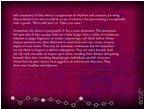
The Nature of the Urban Night
Stay in Place

Telesharing
The Burning Question
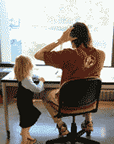
Gallery as Radio Station
OPEN VIDEO PROJECTS

CALL FOR SUBMISSIONS: Season 2
- Each submitted video must include the name of the artist, title, duration, year of production, contact information (e-mail and home address), biography, and any additional information;
- The sender is responsible for mailing costs of submission;
- Works will not be returned to the senders from Italy and the United States unless a stamped, self-addressed envelope is included in the package. For submissions outside these two countries, please contact Blueroom by email for return postage instructions.
-Acceptable formats:
Dvd
Mini DV
CD
c/o Lorenzo Benedetti
via Ottorino Gentiloni, 41
00139 Roma, Italia
or:
c/o Sarra Brill
177 Garfield Place
Brooklyn, NY 11215
Curatorial contributions provided by Andrew Cappetta, Adrienne Drake, Giuliano Lombardo, and Irene Di Maggio.RE: [iDC] wrapping up: "new media" education curricula/potentials
![]()
The Negotiatior and the Knife
tobias c. van Veen
McGill Communication & Philosophy
http://mailman.thing.net/pipermail/idc/January 29, 2007
ZOO
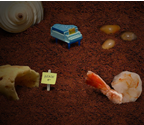
The Relationship Between Technology, Culture and Nature
5+5=5
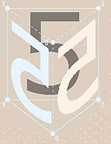
Review by Tindara Sidoti
[iDC] New Media Education
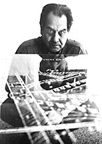
Luis Camnitzer
http://mailman.thing.net/pipermail/idc/
Networking | The Net as an Artwork
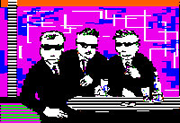
Presentation @ Transmediale
Regine Debatty's

Interview with Mushon Zer-Aviv
January 28, 2007
XIV RADIO CREATION WORKS CONTEST
![]()
Contest of Ideas
Centro para la Difusión de la Música Contemporánea
c/ Santa Isabel 52, 5ª planta
28012 -Madrid (Spain)[Re: magAzine] | #004 Curating Ambiguity
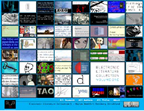
Interview with Scott Rettberg
Make Everything New

Ways in which the Communist Imagination can be Materialised as Art
[iDC] sharing "new media" curricula/potentials
![]()
Kevin Hamilton
iDC -- mailing list of the Institute for Distributed Creativity iDC[at]bbs.thing.net http://mailman.thing.net/cgi-bin/mailman/listinfo/idc
http://mailman.thing.net/pipermail/idc/Leonardo Electronic Almanac Discussion (LEAD)

Giselle Beiguelman + Sue Thomas
creative writing and the creative industries. She is currently writing The Wild Surmise, a study of nature and cyberspace.
Use your subscriber email and JISCMAIL password to log into the discussion room (using the first link above). If the online interface does not start, it is necessary to download and install the most recent Java version.
LEA Gallery: http://leoalmanac.org/gallery/index.asp
Wild Nature and Digital Life Forum Info: http://leoalmanac.org/journal/Vol_14/lea_v14_n07-08/forum.aspJanuary 27, 2007
Challenges for a Ubiquitous Museum:
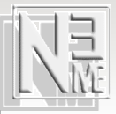
Presenting and Preserving New Media
Networked Furniture and More with Tobi Schneidler

Interview/Article
January 26, 2007
3 X 3: New Media Fix(es) on Turbulence
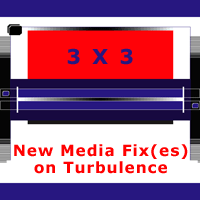
Essays by Josphine Bosma, Belén Gache, and Eduardo Navas
Biomapping Brixton

Workshop
Clapham - Monday 12 Feb. Meet at Clapham City Learning Centre
http://www.biomapping.net or http://www.softhook.com The Girlfriend Experience
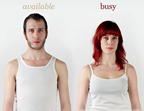
Multi-Player Game with Avatars of Flesh and Blood
www.liminalinstitute.nl [via netbehaviour]Bacterial Orchestra

Evolutionary Musical Organism
Mega Plotter

Collective Painting
Second Life Population Gets Virtual Cell Phone
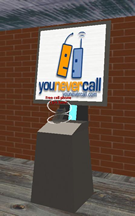
Is your avatar being served?
January 25, 2007
Many Eyes on Visualization
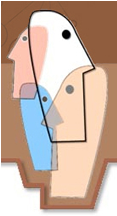
Democratized Visualization
Maya Deren
January 24, 2007
Performing Second Life
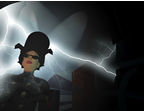
Gaza Stripped
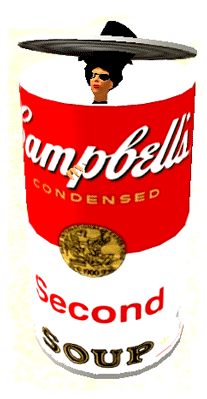
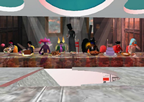
Performance Art for a Virtual World
Wirxli Flimflam: Yes I consider myself an alien but at the same time accessible enough to pass for Post-Human ;-)
Aidan: Do people react instinctively to your avatar appearance?
Wirxli Flimflam: Hmmmm..most people are polite, it is always hard to know what people really think. Some have immediate surface reactions though, they can tell right away that I am an artist of some kind, usually.
Aidan: And it's a benefit to Second Front that you all vary in appearance?
Wirxli Flimflam: I have noticed that by instinct, performance artists choose to be Tranny-esque. I like to keep my avatar recognizable. I would like to endorse the meme of brand recognition. Other avatars in the group like to change their appearance, but I am also the PR face of SF so I like to keep things familiar.
Aidan: How did your last performance go at Ars Virtua?
Wirxli Flimflam: No regrets, if that is what you mean, I consider it "early work". We learned a lot from it. Continue reading Performance Art for a Virtual World by Aidan Aquacade, SL Enquirer (scroll down).
Aram Bartholl
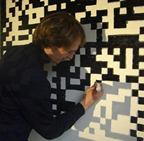
Tagging Interactive Paintings
"Knowledge does NOT become unnecessary by the Internet!"beiLAB
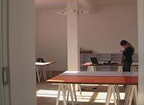
Call for Residencies, Beijing, China
Theatre in Motion Residence Program: more info click here
The studio has a separate entrance to ensure the privacy of the resident. Next to the artist studio, the beiLAB covers another private apartment, an office space and a project space with pantry, for project presentations, workshops and lectures. In certain occassions, artists in residence use the project space to present work in process. Images.
Theatre in Motion at beiLAB
Beijing, China
Dongcheng 100007
Dongsi Shisi Tiao 93 A lou 3 ceng
els[at]theatreinmotion.org
Billions and Billions of Us
FAMULUS

Digital Scavenging
Joe Winter
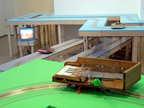
Fantasie no. 1 for Mobile Pianos

Distributed Performance
Future of Sound
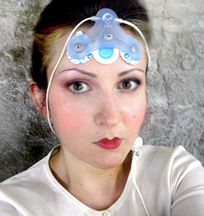
Blows the Mind
http://www.flickr.com/photos/pixelsumo/sets/72157594488393569/Interactive Architecture
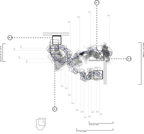
Eyebeam - New York
IMD Forum
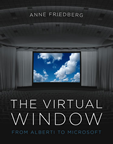
Anne Friedberg
Rock N' Scroll
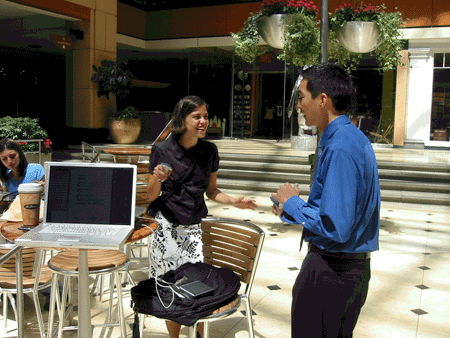
Interventions into Public Space
TAGS NETWORKS NARRATIVE
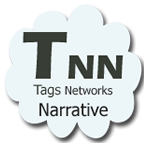
Request for Information
NASDAQ Vocal Index
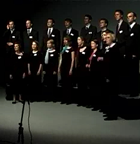
Vocal Interpretations of the Market
Viroid Flophouse
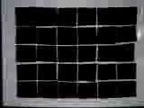
An Exploration of Playable Art
http://art.ntu.ac.uk/performance_research/birringer/lat.htm
http://art.ntu.ac.uk/performance_research/birringer/lat4.htm RPM's Remixed
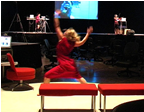
A Virtual Space "Sings"
Brigitta Zics: Out of Body Control
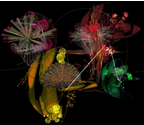
Interviewed by Julia Peck
January 23, 2007
Prospero – A “Visual Commons” Framework
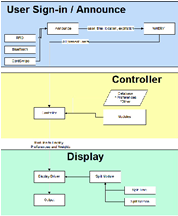
for Community-Aware Public Displays
The Electric Sheep Screen-Saver

A Collective "Android Dream"
New Forms Festival 2007: Re·Use
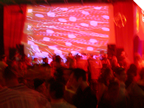
Call for Proposals
NFF EXHIBITION 07: Re-Use: Everything Knows Itself
The world is round.- Gertrude Stein
Clocks are thinking, Earth is spinning, people are ticking...
Furthering the New Forms Festival’s 2007 direction of exploring things unseen the exhibition will centre on the theme of re-constructing, re-shaping and re-mixing the already extant. The aim of this reincarnation is to reflect the sameness and the difference of things revealed by repetition, iteration, rhythm and phase.
Sameness requires difference; the very regularity of a beat, of drumming, can be enhanced and overwritten. The second repetition is invariantly different then the first by being second. Difference resolves into more complex kinds of sameness.
We are interested in form as much as content. We shall invite works that are spare, astringent, and display a simplicity of means coupled with transparency of technique. Works purged of metaphor and stripped down to their most fundamental features. "Less is more, more is less. The eye is a menace to clear sight." [Ad Reinhardt]. We would like to show self-contained works that shed light on the underlying systematic action of their construction, exhibiting regularity of behavior in the elements they use. We welcome audio/visual installation, kinetic sculpture, networked and telematic art submissions. The key words, again, are: repetition, iteration, rhythm and phase.
UNCONFERENCE: ArtCamp07: Re:use
ArtCamp07: Re:use follows up on ArtCamp06, the World’s First Un-Conference on Art, a groundbreaking day-long event co-produced by New Forms Festival and Upgrade! Vancouver, which was attended by over a hundred artists, designers, programmers, critics, theorists, curators and practitioners from all fields who presented over 30 workshops, talks and hybrid events throughout a single inspiration-filled day. The theme of Re:use will be brought into the framework of ArtCamp in order to offer an opportunity for participants from all fields working creatively with technological or material frameworks to come together in an open window of time and space to meet, show work, talk about ideas, try things out, and learn new hands-on practices.
ArtCamp is a self-organizing event that gear up in the form of a collaborative wiki in the months and weeks leading up to the festival. Last year’s wiki.
FILM
MUSIC AND VISUALS SERIES
Manglification
RESIDENCY PROGRAM
All submissions should be done through the online form with accompanying material sent to: New Forms Festival 06 / Transformations #200-252 East 1st Avenue, Vancouver, B.C. V5T-1A6. Submission Deadline: April 1st, 2007.
New Forms Festival : Revised Films
#200-252 East 1st Avenue. Vancouver, B.C. V5T-1A6
malcolm[at]newformsfestival.com
604.648.2752net-native stories are already here:
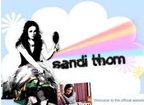
so are the vultures
New Urban Topologies:

The Desire for Public Place in the Age of Virtual Geography
DRAIN 7

Desire
Tangible Musical Interfaces
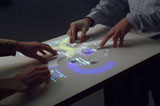
Music Tables
• affiliation: MIT Medialab, Tangible Media Group
• publication: Audiopad: A tagged based Interface for Musical
Performance [PDF]
• website: http://www.jamespatten.com/audiopadHyperrhiz Journal

New Media Cultures
Border Art
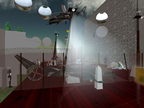
Imaging Place SL: U.S./Mexico Border
Everyware
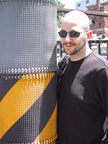
An interview with Adam Greenfield
for that matter?Electronic Literature Collection
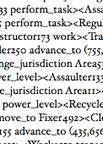
Volume One
Upgrade! Lisbon
![]()
Marta de Menezes
Borders, Boundaries & Liminal States

Call for Participation
m-DAT presents:
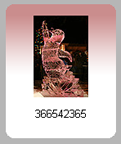
The Hack-Able Curator
January 22, 2007
AUR(O)RA:
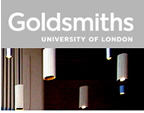
EXPLORING ATTRIBUTES OF A LIVE ALGORITHM
Dear Internet v1.
![]()
Networked Technologies and the Paradoxes of Social Relations
Emerson College and NRPA present
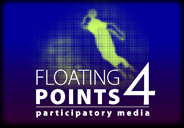
OurFloatingPoints 4: Participatory Media
Robert B. LISEK's
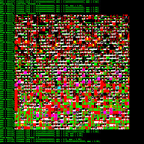
GENGINE
3. knowledge representation engine based on hyperposets (ready core >> FLOAT project, LMCC NYC) and optional Suprabot extensions:
4. open source game engine for visualization and sensing (UTD)
5. robotic sensimotor interface (the Hanson Robotics)
6. natural language processing interface (UTD)
http://www.flickr.com/photos/fundamental_data/
http://www.fundamentalresearch.org/
lisek[at]fundamental.art.plsagasnet: Developing Interactive Narrative Content Seminar
![]()
Call for Projects
Selection board: Greg Childs (ChildsEye, UK), Raimo Lang (YLE, FIN), Anthony Lilley (Magic Lanterns Production, UK), Peter Olaf Looms (DR interactive, DK), Mark Ollila (Nokia, S/AUS), Lee Sheldon (USA), Brunhild Bushoff (sagasnet, D)CELL PHONE
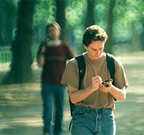
Art and the Mobile Phone
Blast Theory (London)
Steve Bradley (Baltimore)
Family Filter
Jonah Brucker-Cohen (New York), Tim Redfren (Dublin), Duncan Murphy (Dublin)
Informationlab
Ursula Lavrencic and Auke Touwslager (Amsterdam)
Paul Notzold (Brooklyn, NY)
Mark Shepard (New York)
URBANtells
Steve Bradley, James Rouvelle, and Joe Rensel (Baltimore)
Angie Waller (New York)January 19, 2007
Howard Rheingold
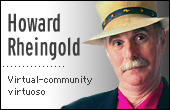
Ninnys who conflate "Marxism" with "collective action."
A market -- all markets have regulations and honor contracts, and are entered into voluntarily by buyers and sellers -- is a form of collective action. Can one of these geniuses please explain to me how a market is "Marxist?"The Way We Loop "Now:"
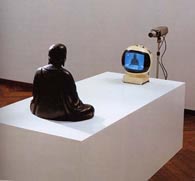
Eddying in the Flows of Media
Second Person:
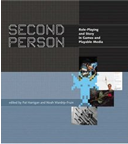
Role-Playing and Story in Games and Playable Media
Sleepwalkers

a vast outdoor multiplex
V2_ Institute for the Unstable Media
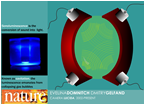
Camera Lucida: Sonochemical Observatory
Packet Garden
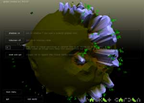
Landscapes of net behaviour
January 18, 2007
Anna Halprin: Dance/Art Experiments

Lecture and Workshop
Timescope
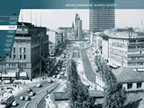
A Virtual Journey in Time
THE VOICE OF NEW MUSIC
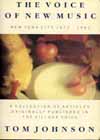
Minimal Music in New York: 1972-1982
The Voice of New Music (Microsoft Word format) [1.1 MB]Second Life Left Unity
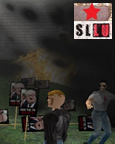
Real Life Fascist Group Recruiting Inworld
SLLU, also condemn this racist party for using SL as a place to recruit - the dissemination of discrimatory racist hate propaganda should be viewed as a violation of SL's community standards' We call on Axel residents to complain about this cabal and their sullying of the tranquil and beautiful area that was once Axel, and join our campaign to rid SL of racism. SLLU support residents in their wish to rid themselves of this group and the protests that have followed. SLLU can promise residents that our organization has no want to stay in Axel any longer than it takes to rid residents of the FN (who are at present trying to buy more Axel land). We reiterate our call on the Lindens to ban this group from PG areas." [via SLLU]New Media Literacies

Training Kids With Skills For Participatory Culture
Alan Sondheim
Mediaruimte
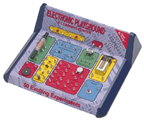
Code 31 Workshop and 8bit / Gameboy Concerts
empyre: what needs to be done (Skills For Participatory Culture)

the paradox of critiquing the system one is working within
Schwelle
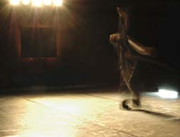
@ Tesla/Transmediale 2007
Concept/Direction/HD Video/Sound: Chris Salter
Collaboration Sound: Daniel Moody-Grigsby and Philip Viel
Premiere: Tesla/Transmediale 2007, Berlin, February 2007
Concept/Direction: Chris Salter, in collaboration with Michael Schumacher
Dramaturgy: Heidi Gilpin
Lighting Design: Lea Xiao
Sound Design and Programming: Marije Baalman, Daniel Moody- Grigsby, Chris
Salter, Philip Viel
Interaction Design/Sensing Systems: Marije Baalman
Objects: Thomas Spier, Flora Luna
Production Stage Manager/Technical Director: Daniel Plewe
Production Assistents: Daniel Wessolek, Alexander Wilson, Brett Bergmann
Thursday-Saturday, February 1-3, 2007. 20:30
For tickets/more information, please visit http://kasse@tesla-berlin.de
Asst. Professor of Computation Arts
Faculty of Fine Arts
Concordia UniversityFrom Land Art to Bioart

International Conference
January 17, 2007
Ultimate Shopper
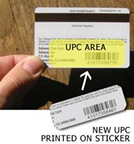
Circumvention and Architectures of Control
Piotr Szyhalski in conversation with Steve Dietz
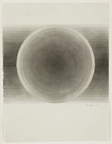
Thursday, January 18, 7:00 pm
The Greatest Sound Sculptures in the Metaverse
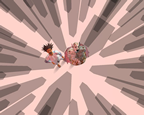
or sounding-out the Metamatic Neighbours
Adam Nash

Interactive Second Life Sculpture Park
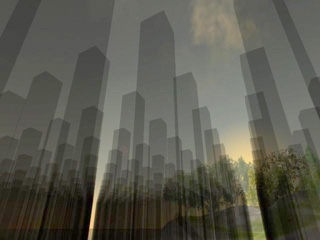
Cantata Park, by Chris Dodds (Mashup Islander in SL) and Adam Nash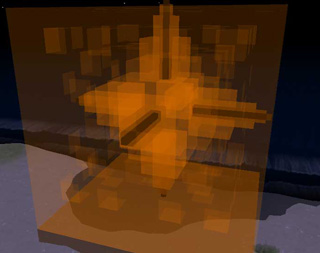
Anahata The Mute Swan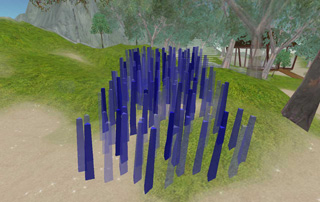
Bell Garden
Blue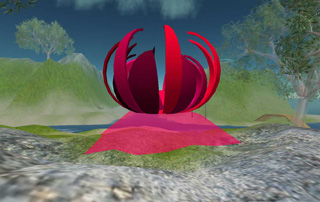
Eudemonia Stallata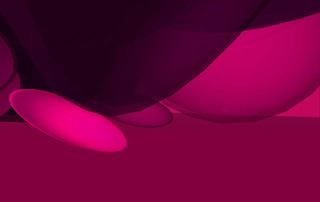
Pure Absence
Direct link to christo’s work: http://slurl.com/secondlife/Marni/205/53/25/Nathaniel Stern

In and Around: the Implicit Body as Performance
My research contends that in such spaces, it is the body, itself, which is performed. A body in space can "act" as a site of emergence, a boundary project, and an incipience. While Rebecca Schneider’s "explicit body" in feminist performance art performatively unfolds (Latin: explicare) and explicates, the implicit body concordantly enfolds (Latin: implicare) and implies. Inter-action is both constitutive of, and always already involved in, the space of the body as relational. Like an animated moebius strip, the body is: in and around.Book and Volume
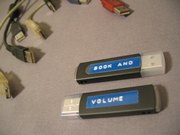
Art Barter
University of Pennsylvania, IRCS
3401 Walnut Street
Suite 400A
Philadelphia, PA 19104-6228Iraq Study Group Report
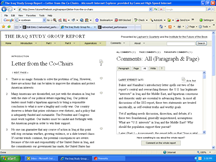
bush's iraq speech: a critical edition
eRiceCooker
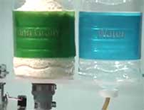
Rice is nice?
S O N I C B E D _ L O N D O N plays

pluckEhisquare_anti
Neural n. 26 IN PRINT
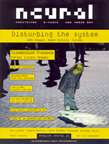
Available Now
Hive:

Small Mobile Open Source Networks
Stream: http://connect.waag.org
Where: Theatrum Anatomicum, waag building, Nieuwmarkt 4, 1012CR, AmsterdamThe Institute of Unnecessary Research
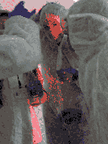
pluckEhisquare_anti
UmNyango Project
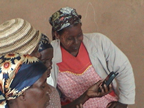
Women Fight for Rights with Cell Phones
Art's Birthday
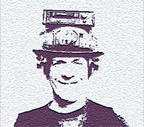
art'n'radio birthday parties
The Heart Chamber Orchestra

Music "From the Heart"
January 16, 2007
TRANSMISSION.06/mimesis
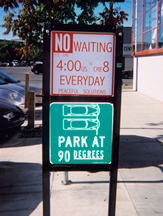
Call for Participation
Leonardo Electronic Almanac Discussion [LEAD]

Live Chat with Jennifer Willet
Use your subscriber email and JISCMAIL password to log into the discussion room (using the first link above). If the online interface does not start, it is necessary to download and install the most recent Java version.
LEA Gallery: http://leoalmanac.org/gallery/index.asp
Wild Nature and Digital Life Forum Info: http://leoalmanac.org/journal/Vol_14/lea_v14_n07-08/forum.aspWhisperBox
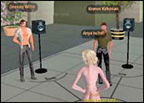
Interactive Sound Installation in Second Life
Serious Games
![]()
Pax Warrior
January 15, 2007
16 Beaver Group

The Case for Immediate Withdrawal from Iraq + National Protest
Instead, the new year saw the US occupation of Iraq reach even further depths of barbarism. 3,000 US soldiers are now dead while Iraq continues to descend into civil war as a result of the US occupation. The public hanging of Saddam Hussein was just the latest attempt to justify a continued US presence in the name of "democracy." Yet 90% of Iraqis polled believe things were better under Hussein than they are today. Real justice for Iraqis can only come from an immediate withdrawal of US military from the entire Middle East.
16 Beaver Street, 4th / 5th fl.
New York, NY 10004
phone: 212.480.2099
4,5 Bowling Green
R,W Whitehall
2,3 Wall Street
J,M Broad Street
1,9 South FerryCharacter Reference
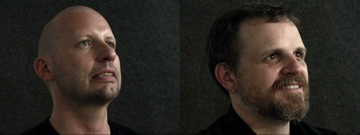
MTAA
New Media Consortium Campus
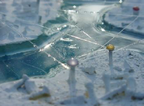
NMConnect: CALL FOR ARTISTS
Visit http://www.nmc.org/sl/nmconnect.php to connect your installation.
* Reliable Email contact
* Name of piece to be presented
* Medium and format
* Space and Number of prims needed
* Special scripting/features to consider (sound, light, video, interference)
* Graphic images, links or slurls
•Name and Email contact
•Space, prims and technical/media needs
•Preferred time, format, co-presenters and associationsNUWeb A project for Web 3.0:

for the user, by the user, of the user!
December 27, 2006 Photos from the Event
See also: http://www.nuweb.cc/tw/index-c1.htm
[via nettime]37 Isolated Events
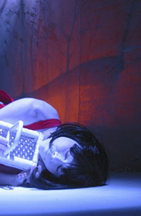
Contemporary Butoh Dance and Immersive Video Performance
37 Isolated Events begins with the normal running temperature of the human body and gradually fabricates a facsimile body. Within the noise of networked society, our intimate distance and distant intimacy induce a virtual, mediated sensibility. We are anesthetized - our breath mechanized - as the human biological system becomes hybridized with the global system. At thirty-seven degrees Celsius, in isolation, we have unprecedented potential to risk exposure and make contact inside the noise of a growing global network.
collaborating media artist | lucy hg (LA)
sound artists | imaginationandmymother (UK)
performance/choreography | sorvillo, monique goldwater, isabelle sjahsam, jez lee
lighting design | elaine buckholtz
photography | ian wintersTurbulence Commission:
![]()
"html_butoh" by Ursula Endlicher
aMAZElab

GOING PUBLIC '06
International distribution by: Actar, Barcelona
EFA Gallery

EFA Live!
Fri & Sat, Feb 2 & 3, 2007, 8 pm :: Tickets: http://www.smarttix.com or 212 868 444
EFA Studio Center
323 West 39th Street, 2nd Floor
New York, NY 10018
between 8th and 9th Avenues
Gallery Hours: open 6pm on performance nights
Elaine Tin Nyo, Director
T. 212-563-5855 x203, F. 212-563-1875
elaine[at]efa1.orgOLIVER GRAU Lecture

PHANTASMAGORIC MEDIA ART
Upgrade! Paris

Eduardo Kac
January 12, 2007
.dpi no 7

hard mobility
Jason E. Lewis
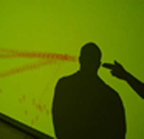
Everything You Thought We’d Forgotten
Internet Black Holes
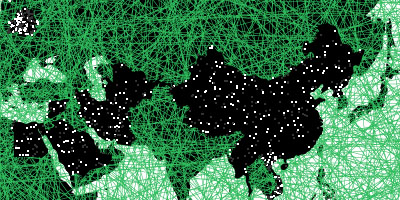
Citizens Denied
i-Biology

Evolution isn't what it used to be...
True Secrets
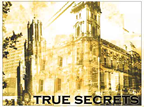
Audio Theatre on your Mobile Phone
S Y N C H R O M Y
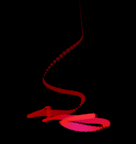
Spectator at the Heart of the Creative Processs
Mediamatic
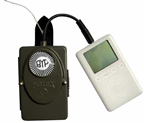
Workshops
PureData (or PD) is a fairly easy to learn graphical programming language for the creation of interactive computer music and multimedia works. This workshop is an opportunity for anyone to learn how to process and organize sounds, how to map and program for physical interaction, for video processing and and for networking possibilities with Pure Data. In PureData functions or objects are patched together in a graphical environment which models the flow of data. Participants will learn the basics of using PD, the basics of sound synthetization and they will build their own PureData sound- video or control patches. PureData is a free, open source software tool.
More about Radio Rietveld: "Radio Rietveld at Stedelijk Museum" (RR.SMCS) is a temporary radio project broadcasting for 3 months 24/7 live on 105.6 FM in Amsterdam as well as on broadband internet stream (hosted by TheWaagSociety) for the international public. RR.SMCS wants to create a channel for audio art, sound related art projects, extraordinary and underestimated music as well as being a discussion platform and speaker's corner for a vivid discussion about art.
Lotte Meijer, media designer, maker of the Broadcast-Your-Podcast project and the amazing Wifio set. Lotte Meijer will present her work and lines of research into new kinds of radio experiences.
One or both of the ladies of Cut-n-Paste will present their innovative radio projects LoveControl, Teletap and CallCenter in which broadcast, podcast and mobile phones meet in intimate and unexpected ways.
This workshop is intended for everybody who's interested in creating new radio experiences.
Registration: You can register online. The price for this workshop is EUR 100 incl. lunch & VAT and EUR 75 if you're a student. Special offer for Rietveld students: 3 can come for the price of 2.
Participants will be guided through Machinima production process by Daniel van Gils (NL), Jonas Hielscher (G) and Ricard Gras (E/UK). The coaches are experienced in a wide variety of game engines, and specialized in using the Unreal Tournament engine, the Sims 2 engine, the Machinima possibilities of Second Life and Machinimation, that runs in the Quake 3 engine.
This workshop is intended for filmmakers, animators and gamers. Some experience with playing video games or film editing is helpful, but not essential.
Mediamatic Arduino Unplugged workshop by Massimo Banzi a.k.a. Mr. Arduino :: 12 | 13 | 14 | March 2007
Tiny chips, cheap sensors and the possibilities of emerging smart fabrics, conductive yarns and cheap wireless communication (bluetooth or even rfid) make wearables easier and cheaper to make. Arduino boards are small physical computing platforms: Arduino developed a fairly simple integrated development environment to deal with the small portable input/output board.
In this workshop we will have a look at wireless Arduino's (Bluetooth Arduino's).
Massimo Banzi a.k.a. Mr. Arduino, is one of the founders of Arduino. He currently teaches Physical Interaction Design at the Interaction Design Institute Ivrea and is a consultant on interaction design projects that involve electronics and technology.
This workshop is intended for Computer scientists, hardware hackers, art students, fabric experts, product developers, nerds, dancers - everyone is welcome. However, note that some technical affinity is required. Some experience in programming and electronics will come in useful, specifically in soldering and java, but is not strictly necessary.
Registration: You can register online. The Arduino Unplugged workshop costs 125 euros. Dutch students receive a discount of 50 euros.
Upcoming workshops:
Radio–to-Go workshop: February 14 | 15
Machinima workshop: February 27 | 28 | 01 | 02
Arduino Unplugged workshop: March 12 | 13 | 14
Hybrid World Lab workshop: Dates to be confirmed
http://www.mediamatic.net/workshopsMutaMorphosis: Challenging Arts and Sciences

First Call for Abstracts
‘MutaMorphosis’ seeks a multiplicity of perspectives as well as a qualified and diverse group of conference participants. The conference will concentrate on the growing interest -- within the worlds of the arts, sciences and technologies -- in EXTREME AND HOSTILE ENVIRONMENTS. These environments appear as symptomatic indicators of the mutations that are taking place; they are potential vectors that make possible an awareness of the different problems at the origin of the disturbances that threaten the ensemble of the Earth’s eco-systems.
1. LIFE
Keywords: adaptation, artificial life, bioart, biotechnology, cell, cloning, control, emergence, ethics, evolution, extremophilia, hybrid, limit, organization, performativity, self-organization, strategy, survival, symbiogenesis, symbiosis, tissue, transformation, transgression, transplantation, unpredictability.
2. SPACE
How do the arts and sciences face radical scales and extreme environments?
Keywords: Antarctica, astrophysics, colonisation, climate, dark matter, dark energy, deserts, deteritorialization, ethics, exobiology, exploration, geotagging, globalization, map, macro, micro, nano, singularity, outer space, speed, territory, underwater, vacuum.
3. COGNITION
How do the arts and sciences address evolving ideas about cognition in extreme environments?
Keywords: collective intelligence, complexity, connectivity, decision, deficiency, distributed, ethics, intelligence, dysfunction, emotion, efficiency, information, instrument, handicap, manipulation, memory, mobility, networked, pathology, perception, sensorial, simulation, system, therapy, visualization, web 2.0.
Join us in Prague 8th – 10th of November 2007.
Organiser: CIANT – International Centre for Art and New Technologies in Prague, CZ.
Co-organisers: Leonardo (www.leonardo.info, USA; www.olats.org, FR), Hexagram (www.hexagram.org, CAN), Pépinières européenes pour jeunes artistes (www.art4eu.net, FR)
Partners: Centre for Global Studies at Charles University (CZ), CYPRES Arts Sciences Technologies Cultures (FR), Czech Academy of Sciences – Week of Science and Technology (CZ), French Institute in Prague (CZ), MARCEL (GB), UQAM (CAN)January 11, 2007
InSense: Interest-based life logging
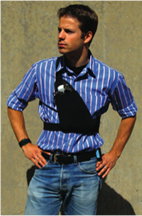
Mapping First Life Experiences with Virtual World Counterparts
Join us Tonight in Second Life
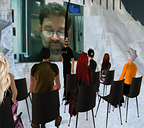
Upgrade! Boston
At the Edge of Art
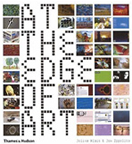
Art's Long-Term Effects on the Social Body
under.ctrl: KONTROL Online Magazine
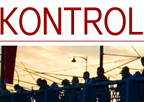
The Pornography of Fabricating Fear
Ambient Addition
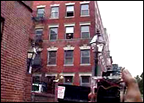
Music from Surrounding Noises
‘SPIRAL’ by Kyoko Nagashima
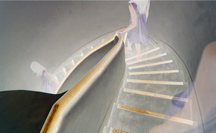
Reviewed by Yukihiko Yoshida
tokyo-artists kyoko nagashima art works http://www.tokyo-arts.jp/kyokonagashima.html
http://www.tokyo-arts.jp/kyokonagashima.html
Satoko Yahagi and also Hisano Yamanaka, Satoko Yahagi "Alicetopia" and Mariko Okamoto "sputnik*gilu" http://www.turbulence.org/blog/archives/000660.html#comments
Ho-Ho-Do
http://hoho-do.net/January 10, 2007
James Cameron’s Virtual World Film Greenlit

Avatar
[iDC] The Ethics of Leisure
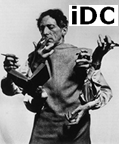
Judith Rodenbeck
http://mailman.thing.net/pipermail/idc/Festival HTMlles 8: CROWD CONTROL

Call for Contributions
www.htmlles.net
www.htmlles.net/08/callM/C Journal
![]()
Call for Contributions
- adapt as strategy of cultural and/or gender and/or ethnic identity
- adapt as mechanism of difference production
- adapt and nostalgia for the original
- adapt and case studies of adaptation
- adapt as resistance or submission to power
- adapt and new understandings of Darwinism
Issue release date: 2 May 2007
'home': article deadline 29 June 2007, release date 22 August 2007
'error': article deadline 24 August 2007, release date 17 October 2007
'vote': article deadline 19 October 2007, release date 12 December 2007
ColorField Remix
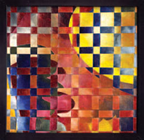
OPEN CALL FOR ENTRIES
Honorable Mention)
Date
Address
City, state, zip
Email
Phone (day) Phone (evening)
Up to 2 proposals for a site-specific work based in the Corcoran auditorium
Current Resume
One Paragraph synopsis or treatment must accompany each piece submitted.
One self-addressed envelope with enough postage to return your materials or prepaid, addressed FED EX, UPS or similar tracking slip. (If no SASE is provided, submission materials will not be returned to the artist.)
(Check one) Yes_____ NO______
Length
Year
Brief summary of Piece
Length
Year
Brief summary of Piece
Length
Year
Brief summary of Piece
WPA\C
Experimental Media Series - ColorFieldremix
500 Seventeenth Street NW
Washington, DC 20006
* More info: 202.639.1828 / dren[at]corcoran.org (Ding Ren, WPA\C Program Director)WHO MAKES AND OWNS YOUR WORK?

OPEN CONTENT MEETING 2
Teleklettergarten
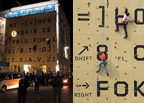
Physical and Programming Commitment
Neurornet

Cinematic and Immersive VR Experiences
Sleeping Beauty

In Which the Object of our Gaze Subjects us to Hers
January 09, 2007
Upgrade! Boston
![]()
ShiftSpace and OPENSTUDIO
Robert Ladislas Derr

Chance: Breckenridge
Just as in past performances, he will wear the mirrored suit to allow his presence on the street to be real and illusionary, and have four video cameras attached to his person, recording simultaneously the front, rear, and side views of his journey. Using the city as a fluid canvas, Derr will move through the streets in silence capturing the ephemeral characters that construct the ambiance of place and time. With the cameras attached to his body, the arrhythmic quality of the videos provides a delusive appearance to the captured scenes. The videos from the performance will be on view at the Tin Shop from January 28 to February 5, 2007.Dune & Devil
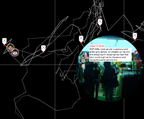
Tracking Vienna + Tokyo through Dune+ Devil
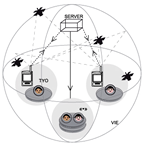
Embracing the Inevitable
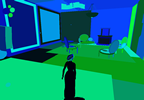
Second Life, now Open Source
MyDeathSpace and Yourdeathspace
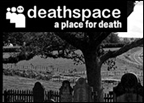
Remembering deceased MySpace users
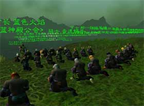
Mourning and digital culture
January 08, 2007
damali ayo
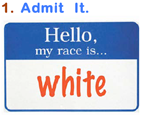
I CAN FIX IT + How to Rent a Negro
produced by christos ikonomopoulos- audiofantastic.com
mastered by clark salisbury
photos by thom wallace
design by damali ayoArs Virtua Artist in Residence
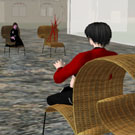
Brad Kligerman
National Academy of Sciences
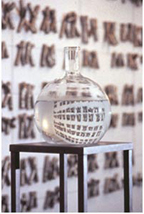
Virtual Symposium on Visual Culture and Bioscience
Andrew Carnie, Artist and Consultant, Greater London Arts professor at Winchester School of Art, Winchester, United Kingdom
Oron Catts, Artistic Director, SymbioticA - The Art & Science Collaborative Research Laboratory, School of Anatomy & Human Biology, University of Western Australia
Catherine Chalmers, Artist Helen Chandler, Former Scientific Manager, The Arts and Genomics Center, University of Amsterdam
Carl Djerassi, Emeritus Professor of Chemistry, Stanford University
Florian Dombois, Professor and Head, Institute for Transdisciplinarity, Berne University of the Arts, Switzerland
Troy Duster, Professor of Sociology, New York University
Sian Ede, Arts Director, UK Branch of Calouste Gulbenkian Foundation Applications
Sabine Flach, Lecturer, Center for Literary Studies, Berlin, Germany
Giovanni Frazzetto, Molecular Biologist, London School of Economics and Political Science, United Kingdom
David Freedberg, Professor and Director, the Italian Academy for Advanced Studies in America, Columbia University
Karl Grimes, Professor, School of Communications, Dublin City University, Ireland
Jens Hauser, Independent Curator, Writer, and Artist Marvin Heiferman, Professor, New York School of Visual Arts
Vladimir Mironov, Research Associate Professor and Director of Bioprinting Center, Medical University of South
Carolina Orlan, Performance Artist, France Nancy Princenthal, Senior Editor, Art in America
Ingeborg Reichle, Art Historian, Berlin-Brandenburg Academy of Sciences, Berlin, Germany
Miriam van Rijsingen, Professor of Humanities, University of Amsterdam, Holland
Michael Sappol, Curator and Historian, National Library of Medicine
Brad Smith, Molecular Biologist, University of Michigan
Andrew Solomon, Writer and Board Member, Cold Spring Harbor Laboratory, New York
Susan Squier, Brill Professor of Women's Studies and English, The Pennsylvania State University
Eugene Thacker, Assistant Professor, School of Literature, Communication, and Culture, Georgia Institute of Technology
Richard Twine, Principal Investigator, ESRC Center for Economic and Social Aspects of Genomics
Catherine Waldby, International Research Fellow, Department of Sociology and Social Policy, University of Sydney, Australia
Catherine Wagner, Photographer
Peter Weibel, Chairman, Center for Art and Technology, Karlsruhe, Germany
Richard Wingate, Lecturer, Center for Developmental Neurobiology, King's College, LondonHz Journal
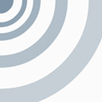
Issue #9
January 07, 2007
High Noon
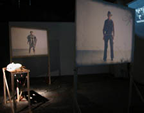
Mobile Phone Duels
Polar Wandering

A Continuous Line Drawing to and from Antarctica
5 Courts
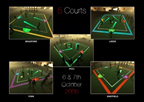
Played Across Five Cities
Sensorium:
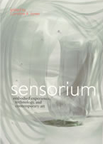
Embodied Experience, Technology, and Contemporary Art
January 06, 2007
Crosstalking (XT)
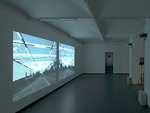
Sound Event(s)
January 2007 on -empyre- soft-skinned space

"What is to be Done?" (Education)
Andrea Sick (DE) Dr Sick has the management and artistic responsibility for the cultural lab Frauen.Kultur.Laboratorium thealit since 1993 (co-operation with thealit since 1990). he is research assistant at the University of Arts Bremen (Atelier für Zeitmedien) and responsible for the creation and concept of a network between art and science in new media technologies. Her research explores relations between technological media and cultural production, transitions between biological and information-technological discourses, interfaces of scientific and cultural activities; and gender studies.
Claudia Reiche (DE) is a media theorist, artist, and curator. Her work focuses on (cyber)feminist approaches to questions of how man/machine relations are designed with words and images. She is a member of the alit Frauen.Kultur.Labor, Bremen (http://www.thealit.de) and of the first international cyberfeminist alliance 'old boys network' http://www.obn.org. She has been director of the European project 'Cyberfeminism.Lab' (Culture 2000 programme of the European Union). Currently she is curating with Helene von Oldenburg The Mars Patent, the first exhibition site on Mars http://mars-patent.org, and with Andrea Sick, do not exist, europe, women, digital medium, a transnational European conference and exhibition lab, http://thealit.de/lab/donotexist/program.htm.
http://www.mca.com.au/default.asp?page_id=10&content_id=1947
Øjeblikket (DK) (editorial collective: Karin Hindsbo, Mikkel Bolt, and Kristina Ask) is a magazine based in Copenhagen, Denmark. Founded in 1993, it is dedicated to the theory and critique of contemporary art. Throughout its existence the journal has tried to address issues of significance to the present situation, thereby hoping to contribute to the creation of a critical public sphere. Each issue of Øjeblikket features a theme that is approached from different angles - philosophical, political, and feminist; recent themes have been propaganda, exclusion, and drawing. Kristina Ask, visual artist is engaged in tv-tv, UKK (Association of Young Artworkers in Denmark) and the project Free Floating Faculty. Mikkel Bolt is Assistant professor at the Department of Arts and Cultural Studies, Copenhagen University, and author of The Last Avantgarde: Situationistisk Internationale beyond Art and Politics (2004).Karin Hindsbo, art historian is director of Den Frie, Contemporary Art Gallery, and chairman of UKK (Association of Young Artworkers in Denmark). Øjeblikket is a participating magazine in the documenta 12 magazine project.International Remix Competition A
![]()
Listen to Capri
International Remix Competition A
c/o AA Independent Radio
Student Forum Pigeonhole
Architectural Association School of Architecture
36 Bedford Square
London, WC1B 3ES
United Kingdom January 05, 2007
Fantastic Piano
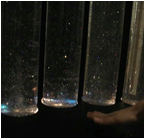
Orchestrating an Audio-Visual Dance
CASAzine #4: Drawing the Line

Call for Contributions
http://www.shintai-z.com Second Life Sketches:

Two Worlds - Fame and Infamy
Tate Britain

Art and Immaterial Labour
Montevideo/Time Based Arts:

Art in the New Field of Visibility
CORCORAN, Strategies of Confinement in the Age of Biopolitics
19 January – 25 February
Opening: Friday 19 January 17.00 h
Artists: Alexandra Croitoru, Johan Grimonprez, Mladen Miljanovic, Solmaz Shahbazi, Sean Snyder
Curator: Zoran Eric
CLUB VOYEUR: CORCORAN, Strategies of Confinement in the Age of Biopolitics
Thursday 8 February 20.30 h, Zoran Eric in dialogue with Bart Rutten
Videoworks from: Harun Farocki, Walid Raad & Atlas Group, Artur Zmijewski
Curator: Zoran Eric
Montevideo/Time Based Arts
Keizersgracht 264
1016 EV Amsterdam
T 020 6237101
http://www.montevideo.nl
Ready Media
18 January – 10 February
Opening: Thursday 18 January from 17.00 - 19.00 h
Artists: Pierre Bismuth, Heather & Patrick Burnett-Rose, Claude Closky, Sagi Groner, Sami Kallinen, Matthieu Laurette, Gabriel Lester, Anna Maltz, Cristi Pogacean, Julika Rudelius
Curator: Maria Rus Bojan
Faith in Exposure
24 February – 17 March
Opening: Friday 23 February, 17.00 h
Artists (t.b.c.): Beirut Letters, De Geuzen, Govcom.org, Lynn Hershman, Olia Lialina, Avi Mograbi, Oog (Nanette Hoogslag / Volkskrant), Sean Snyder, Thomson & Craighead, Jody Zellen
Curator: David Garcia
Faith in Exposure
Saturday 24 February
With contributions by: Jody Dean, Noortje Marres, Richard Rogers, Sean Snyder, David Garcia (moderator)
Nieuwe Spiegelstraat 10
1017 DE Amsterdam
T 020 6255651
http://www.deappel.nl
The Shadow Cabinet: ‘Distorted Fabric’
19 – 27 January
Opening 19 Januari 20.00 h.
Artists: Joana Hadjithomas, Khalil Joreige
Curator: Natasa Petresin
Distorted Fabric
Curator: Natasa Petresin
Friday 19 January 21.00 h
Videoworks from: The Atlas Group/Walid Raad, Daya Cahen, Sebastián Díaz Morales
Saturday 20 January 20.30 h
Videoworks from: Egle Budvytyte, Keren Cytter, Jakup Ferri, Mario García Torres, Driton Hajredini, Ahmet Ögüt, Natascha Sadr Haghighian & Judith Hopf, SilentCell Network, Clemens von Wedemeyer & Maya Schweizer
Vijzelgracht 2A
1017 HR Amsterdam
T 020 5319501
http://www.maisondescartes.com
INVESTIGATIONS
20 January - 10 February
Opening Saturday 20 January 17.00 h
During the opening Pascal Beausse will talk to Bruno Serralongue
Artists: Ziad Antar, Alain Declercq, Clarisse Hahn, Florence Lazar & Raphael Grisey, Bruno Serralongue, Olivier Zabat
Curator: Pascal BeausseJanuary 04, 2007
Mogens Jacobsen:
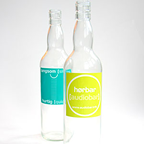
Hørbar/Audiobar
Transnational Temps
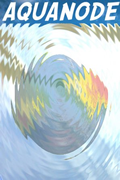
Aquanode 2006
Ars Virtua Presents
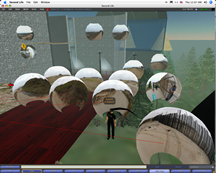
Imaging Place SL: The U.S./Mexico Border
Upgrade! Seattle

annie on ni wan + eunsu kang
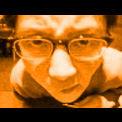
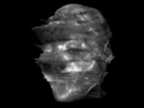
NETWORKED NATURE
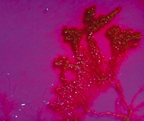
'Nature' through the Perspective of Networked Culture
air: a living micro-environment.
www.newmuseum.org
617 WEST 27TH ST. GROUND FLOOR,
NEW YORK NY 10001
f: 212 239 2759
foxyproduction.comJanuary 03, 2007
Joi's Diary
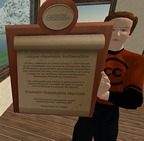
Sitting in a Big Chair
Organized Networks:

Media Theory, Creative Labour, New Institutions
Vibrö
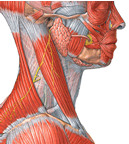
Three Sonic Objects
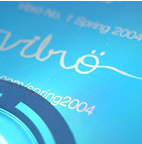
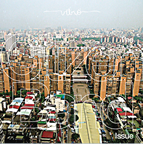
SilenceRadio.org
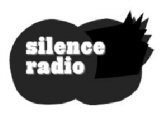
Audio Art Podcasting
http://www.silenceradio.org/
http://www.silenceradio.org/rss.php
http://www.domainepublic.net/Piemonte Share Festival 2007
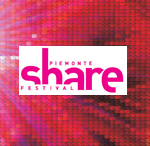
Digital Affinity / Communities Now
Frank Popper
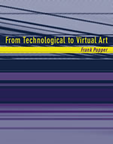
From Technological to Virtual Art
FOREWARD BY JOEL SLAYTON ix
ACKNOWLEDGMENTS xi
INTRODUCTION
Sample Chapter - Download PDF (64 KB) 1
I. The Emergence of Virtual Art (1918–1983) 9
1. HISTORICAL ANTECEDENTS (1918–1967) 11
Artistic Sources 11
Modern Light Art 13
Spectator Participation 29
Environmental Artistic Commitments 39
Technical Sources (such as Engineering and Inventions) 46
Other Sources (such as Science and Linguistics) 47
2. TECHNOLOGICAL ART AND ARTISTS (1968–1983) 49
Laser Art 49
Holographic Art 52
Eco-technological Art 59
Computer Art 64
Communication Art 75
II. Current Virtual Art and Artists (1983–2004) 87
3. MATERIALIZED DIGITAL-BASED WORK 89
Plastic Issues 89
Cognition Issues 110
Bioaesthetic Issues 118
4. MULTIMEDIA AND MULTISENSORIAL OFF-LINE WORKS 131
Language, Narration, Hypertext 131
Plastic Multimedia Issues 156
Synesthesia 161
Sociopolitical and Security Issues 175
5. INTERACTIVE DIGITAL INSTALLATIONS 181
Sensory Immersion 181
Reciprocal Aesthetic Propositions 220
Individual Commitments to Interactivity 248
Social, Environmental, and Scientific Commitments to Interactivity 275
6. MULTIMEDIA ONLINE WORKS (NET ART) 313
The Internet as a Social Communications Option 313
Personal Presence Online 355
Critical Artistic Attitudes on the Net 371
Telematic and Telerobotic Human Commitments 379
7. CONCLUSION 379
NOTES 399
BIBLIOGRAPHY 405
ARTISTS LIST 415
INDEX
Sample Chapter - Download PDF (135 KB)Engaging 'Intermedia'
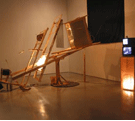
Engaging Technology: A History and Future of Intermedia
Visual Resistance
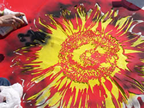
Liberating Public Space
January 02, 2007
Flickeur
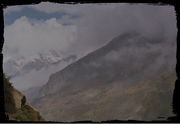
Stream-of-Consciousness Movie
Roberta Breitmore (1971-1978)
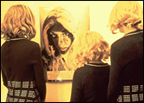
Virtual Identity Ante-Litteram
[iDC] The wrong kind of youth and distributed capitalism

We need an ethics of participation!
http://mailman.thing.net/pipermail/idc/
Placeblogger.com launches:
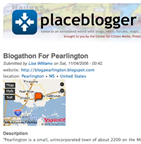
searchable index of local blogs
Daniel Joseph Martinez
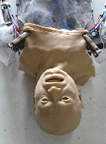
Android Provocateur
January 01, 2007
Leonardo Electronic Almanac Discussion

Kathryn Yusoff + Brett Stalbaum
New Interfaces for Musical Expression

CALL FOR PARTICIPATION
* Novel controllers for collaborative performance
* Novel musical instruments
* Augmented/hyper instruments
* Interfaces for dance and physical expression
* Interactive sound and multimedia installations
* Interactive sonification
* Sensor and actuator technologies
* Haptic and force feedback devices
* Interface protocols and data formats
* Gesture and music
* Robotics and music
* Perceptual & cognitive issues
* Interactivity design and software tools
* Musical mapping strategies
* Performance analysis and machine learning
* Performance rendering and generative algorithms
* Experiences with novel interfaces in education and entertainment
* Experiences with novel interfaces in live performance and composition
* Surveys of past work and stimulating ideas for future research
* Historical studies in twentieth-century instrument design
* Reports on students projects in the framework of NIME related courses
* Artistic, cultural, and social impact of NIME technology
- Full Paper (6 pages in proceedings, longer oral presentation)
- Short Paper (4 pages in proceedings, shorter oral presentation)
- Poster (2 or 4 pages in proceedings, poster presentation)
- Demo (Demonstration space plus 2 pages in proceedings)
- Concert Performance (Performance slot plus program note in proceedings)
- Club Performance (Performance slot plus program note in proceedings)
- New Work for Commissioned Performer (Performance by commissioned performer plus program note in proceedings)
- Installations (Installation space plus brief description in proceedings)
* Workshop on Music and Robotics
Details on how to participate in the Music and Robotics workshop to come.
* NIME 2007
* New York Electronic Arts Festival
596 Broadway, Suite 602 (at Houston St)
New York, NY 10012
Tel: 212-431-1130
http://www.harvestworks.org
Subway: F/V Broadway/Lafayette, 6 Bleeker, W/R Prince[iDC] How to overcome continuous partial attention
![]()
Margaret Morse Responds
Further on, I discuss responsiveness as "calling to account":
http://mailman.thing.net/pipermail/idc/


